At this point, SpaceX could claim to be both a rocket company and also a maritime shipping company. The company owns a fleet of drone ships for the purposes of providing their rockets with a safe place to retrograde land in the ocean without having to splash down. In the past, they actually had additional ships for fairing catching, Dragon Capsule recovery, and other support efforts. But now, the company welcomed its newest drone landing ship with an announcement by Elon Musk on Twitter. Welcome to the SpaceX: A Shortfall of Gravitas.
Continue reading “Here’s SpaceX’s new Drone Ship: “A Shortfall of Gravitas””The SpaceX Booster is Back in Town, Legs Quickly Detached: Photo/Video Gallery
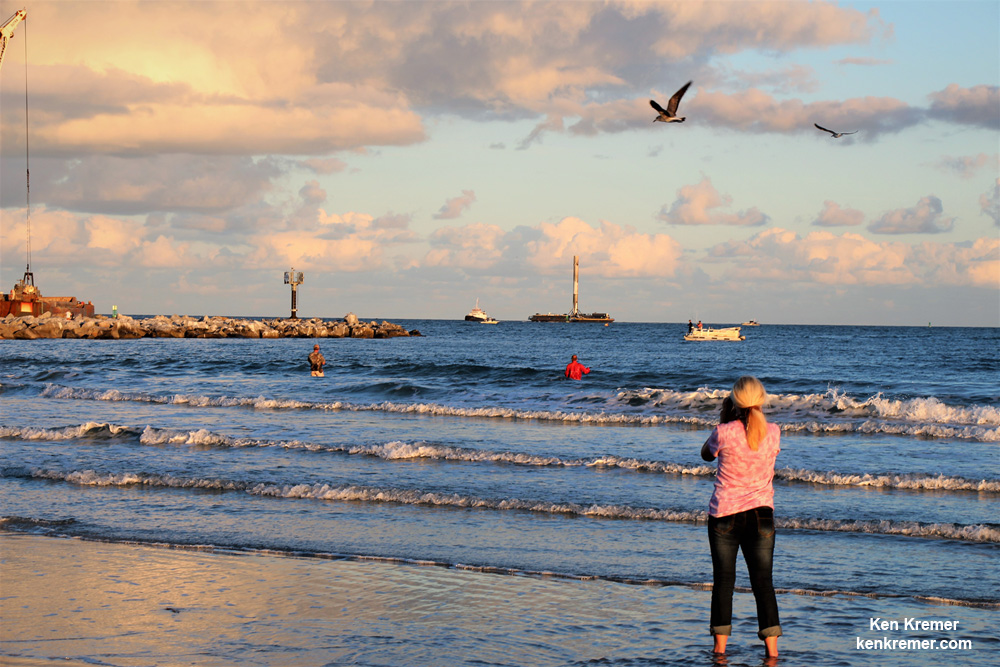

PORT CANAVERAL/KENNEDY SPACE CENTER, FL – ‘The SpaceX boosters back in town! The boosters back in town!’ paraphrasing the popular lyrics of the hit single from Irish hard rock band Thin Lizzy – its what comes to mind with the speedy cadence of ‘launch, land and relaunch’ firmly established by CEO Elon Musk’s hard rocking crew of mostly youthful rocket scientists and engineers.
Barely three days after successfully launching the commercial KoreaSat-5A telecomsat on Monday Oct 30, the SpaceX Falcon 9 first stage booster that did the heavy lifting to orbit generating 1.7 million pounds of liftoff thrust – arrived back in town Thursday, Nov. 2 or more specifically back into Port Canaveral, Florida.
“Guess who’s back in town?” – the song continues – well its the Falcon 9 that reached the edge of space on Halloween Eve while traveling several thousand miles per hour, flipped around like a witches broom and carried out a pinpoint propulsive and upright touchdown of what amounts to a stick on a board in the middle of the Atlantic Ocean. Just amazing!
Floating atop the football field sized platform upon which it soft landed 8.5 minutes after the two stage Falcon 9 lifted off at 3:34 p.m. EDT (1934 GMT) from seaside Launch Complex 39A at NASA’s Kennedy Space Center in Florida. The 16 story tall booster arrived back into the mouth of Port Canaveral late Thursday at sunset – as witnessed up close by myself and several space journalist colleagues.
Check out our expanding photo and video gallery compiled here of the boosters arrival into Port on the OCISLY droneship. The gallery is growing so check back again for more up close looks of the ocean arrival, sailing and docking.
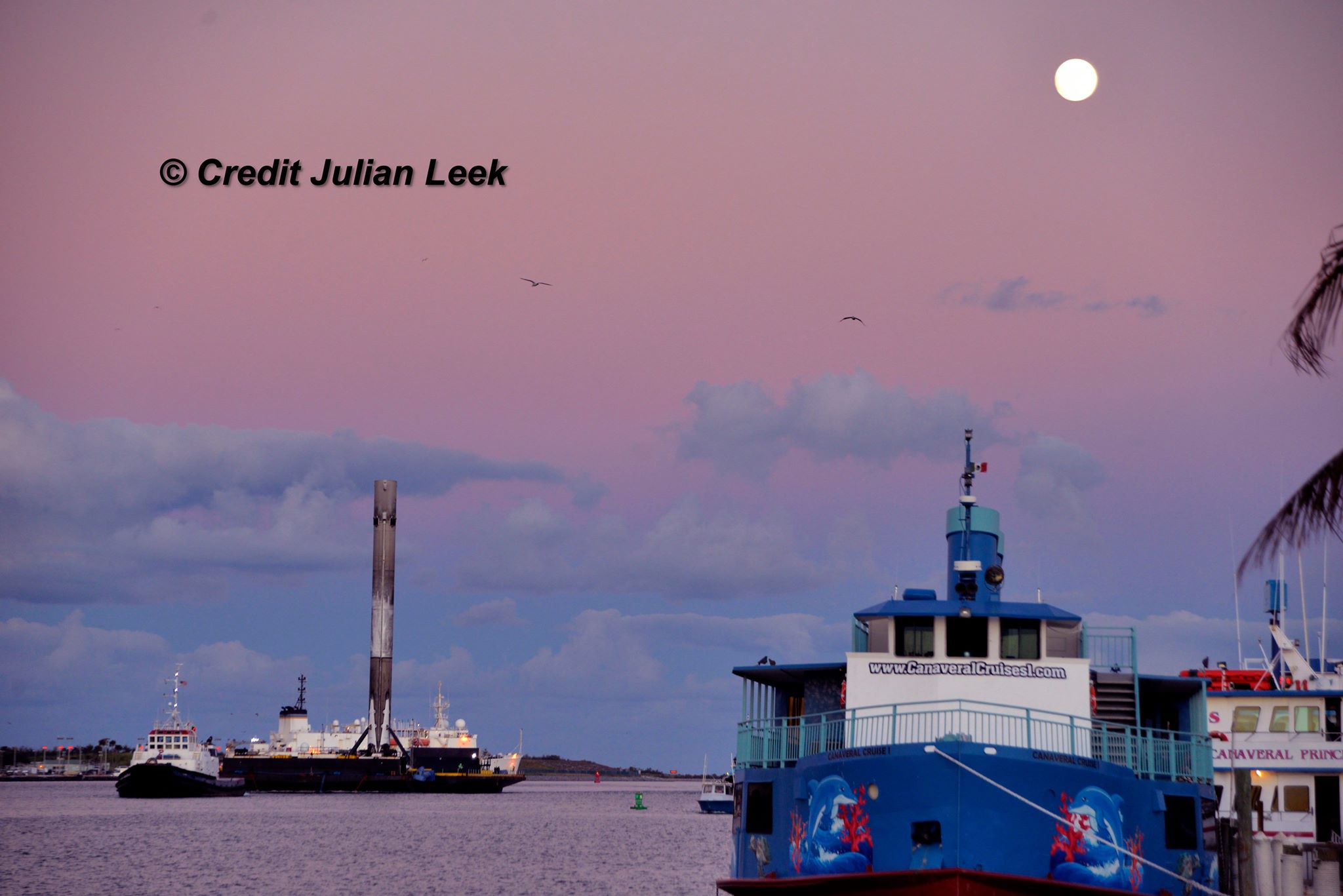
Furthermore the four landing legs that made the landing sequence possible – have already been quickly detached by workers this afternoon, as shown here with additional incredible up close imagery.
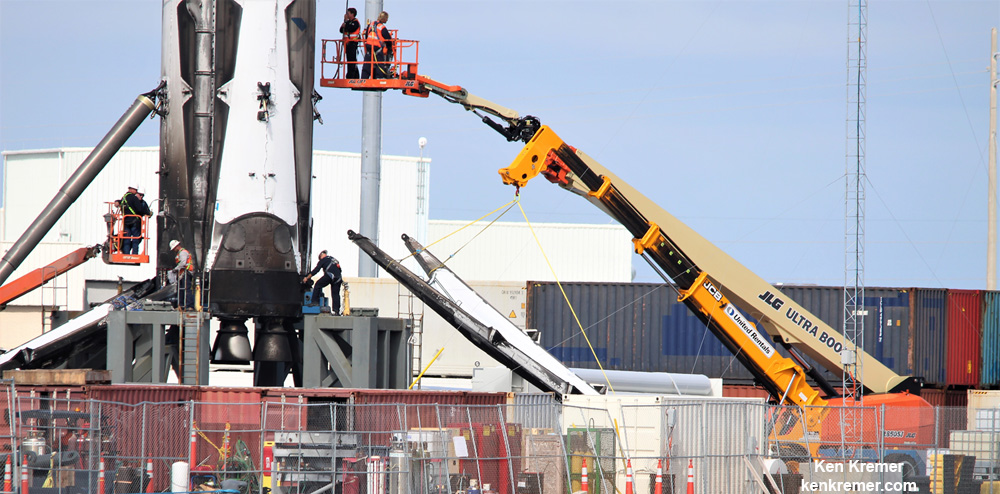
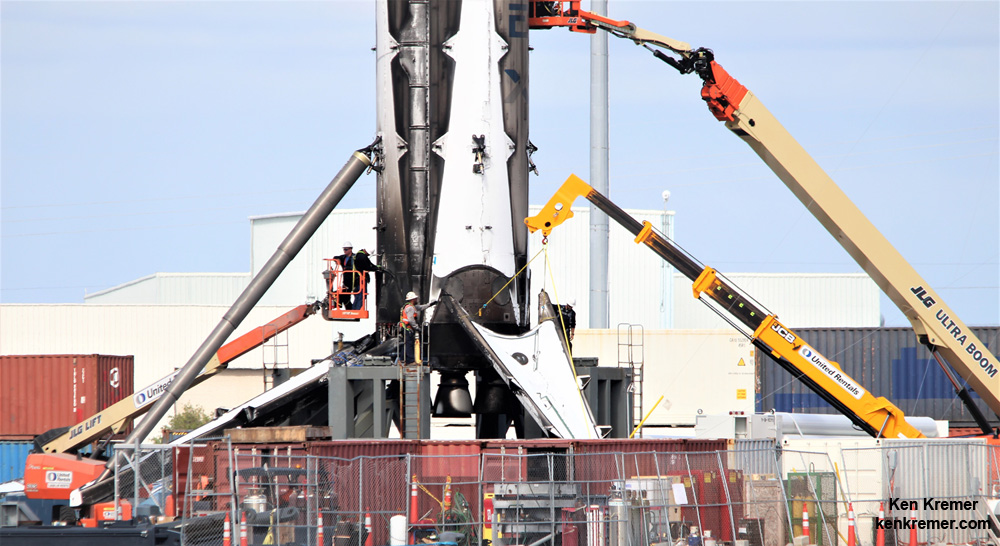
Plus also featured are lots of imagery of the booster sailing through the narrow channel of Port Canaveral – often past seemingly oblivious spectators and pleasure craft who have no idea what they are seeing. As well as imagery of work crews processing the booster for the eventual return back onto base.

The 156 foot-tall first stage atop OCISLY was towed from the Atlantic Ocean landing zone located several hundred miles off shore of the Florida’s East coast back into Port Canaveral by a tugboat named “Hawk.”
The Hawk was accompanied by a small naval flotilla of commercial vessels SpaceX leased for the occasion.

In fact with each booster return the SpaceX technicians are progressing faster and faster carrying out the booster processing involving safing, cap and line attachment, leg removal, and lowering the booster for horizontal placement on a specially outfitted lengthy multi-wheeled trailer for hauling back to SpaceX hangar facilities on the Kennedy Space Center and Cape Canaveral Air Force Station.
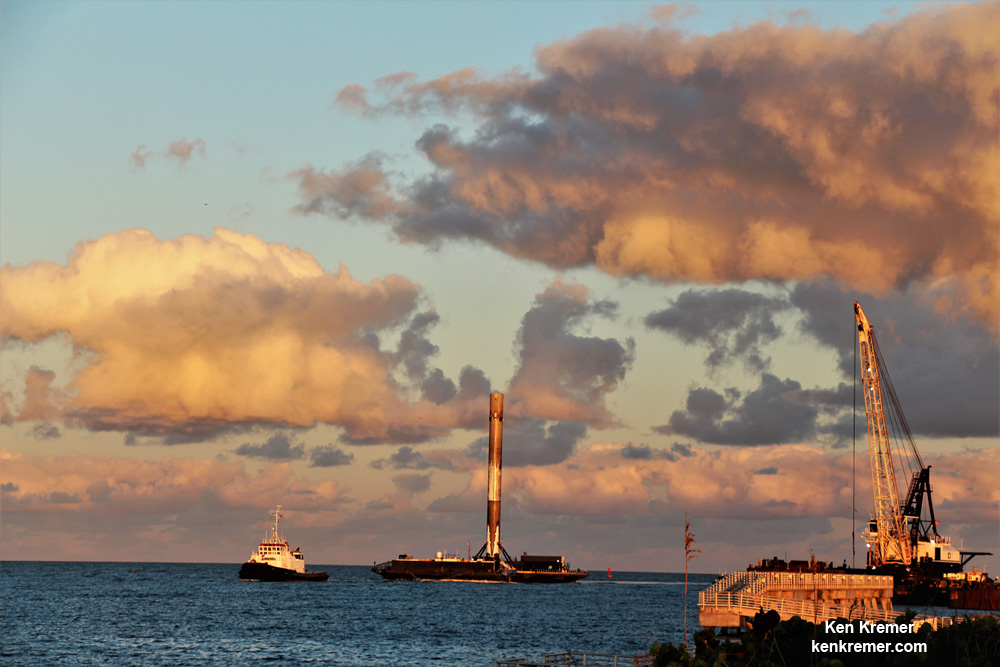
After arriving in port, and sailing through the channel for about 45 minutes the SpaceX flotilla carefully and methodically edged the droneship closer to shore and docked the vessel last night – and the crews got a well deserved rest as the booster basked in the maritime glow producing beautiful water reflection vistas.

The team wasted no time this morning. At the crack of dawn they began the task of attaching a hoisting cap to the top of the first stage.
Shortly after 9 a.m. EDT they craned the booster off OCISLY and onto a restraining pedestal platform on land.
The techs were working fast and making mincemeat of the booster.
They detached the four insect like legs one after another in an operation that looked a lot like a well thought out dissection.
One at a fime over a period about roughly two hour the workers methodically unbolted and detached the legs in 2 pieces. First they they slung a harness around the upper strut and removed it with a small crane. Then they did the same with the lower foot pad.
Altogether the land leg amputation operation took about 2.5 hours.
The now legless Falcon 9 stands erect. It will soon be lowered and placed horizontally for transport back to the base.
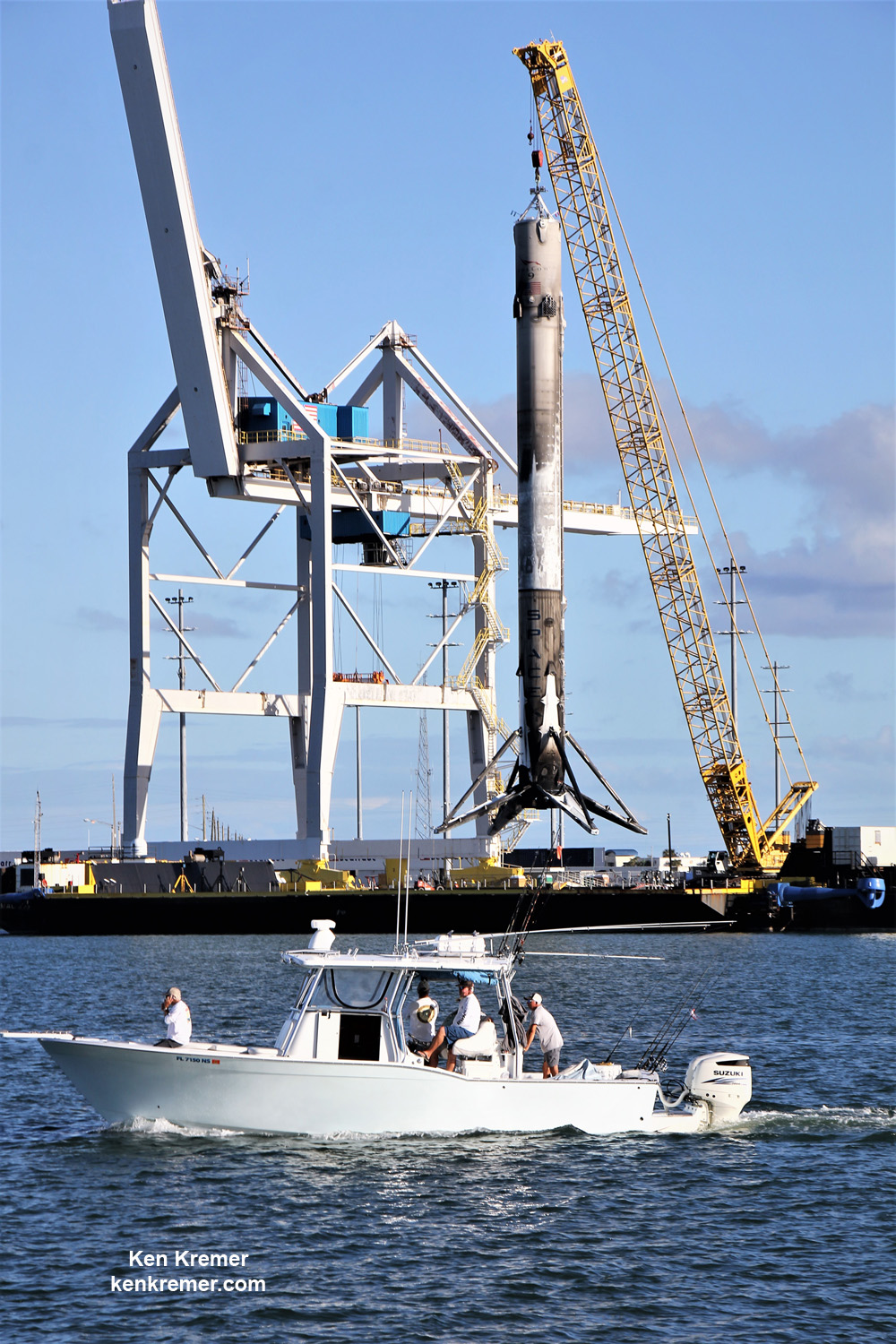
It has been barely two weeks after the last dogeship landed booster arrived back into port in mid-October for the SES-11 launch on October 11 and sunrise port arrival on October 15.
OCISLY which stands for “Of Course I Still Love You” left Port Canaveral several days ahead of the planned Oct. 30 launch and was prepositioned in the Atlantic Ocean several hundred miles (km) off the US East coast, awaiting the boosters approach and pinpoint propulsive soft landing.
The booster was outfitted with four grid fins and four landing legs to accomplish the pinpoint touchdown on the barge at sea.
Watch this video of the SpaceX booster return to Port Canaveral, FL, from the KoreaSat-5 mission:
Video caption: The booster from the KoreaSat-5 mission returns to Port Canaveral, FL, on the SpaceX drone ship ‘Of Course I Still Love You” on Nov. 2, 2017 after a successful landing at sea. Credit: Jeff Seibert
Video caption: After launching from the Kennedy Space LC-39A the SpaceX Falcon 9 first stage landed on the OCISLY droneship offshore. It was towed back to Port Canaveral to be refurbished and used again in a later launch. Credit: Julian Leek
To date SpaceX has accomplished 19 successful landings of a recovered Falcon 9 first stage booster by land and by sea.
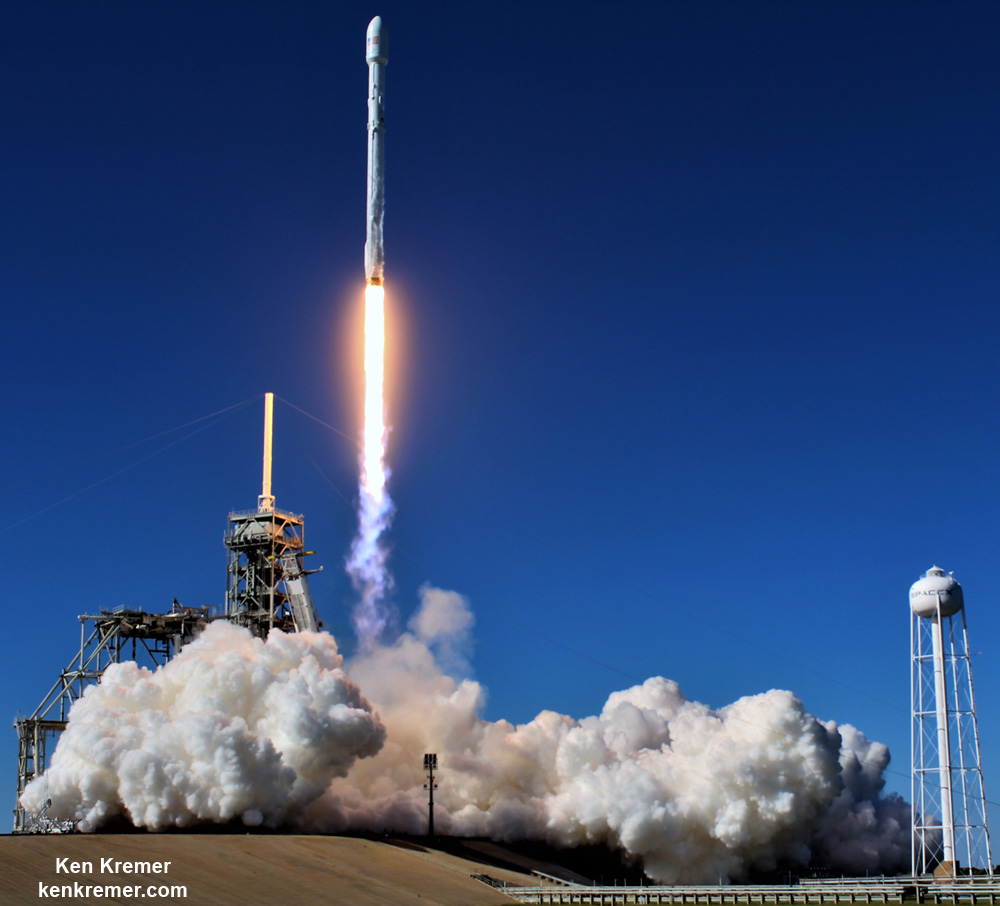
Watch for Ken’s continuing onsite coverage of SpaceX KoreaSat-5A & SES-11, ULA NROL-52 and NASA and space mission reports direct from the Kennedy Space Center and Cape Canaveral Air Force Station, Florida.
Stay tuned here for Ken’s continuing Earth and Planetary science and human spaceflight news.
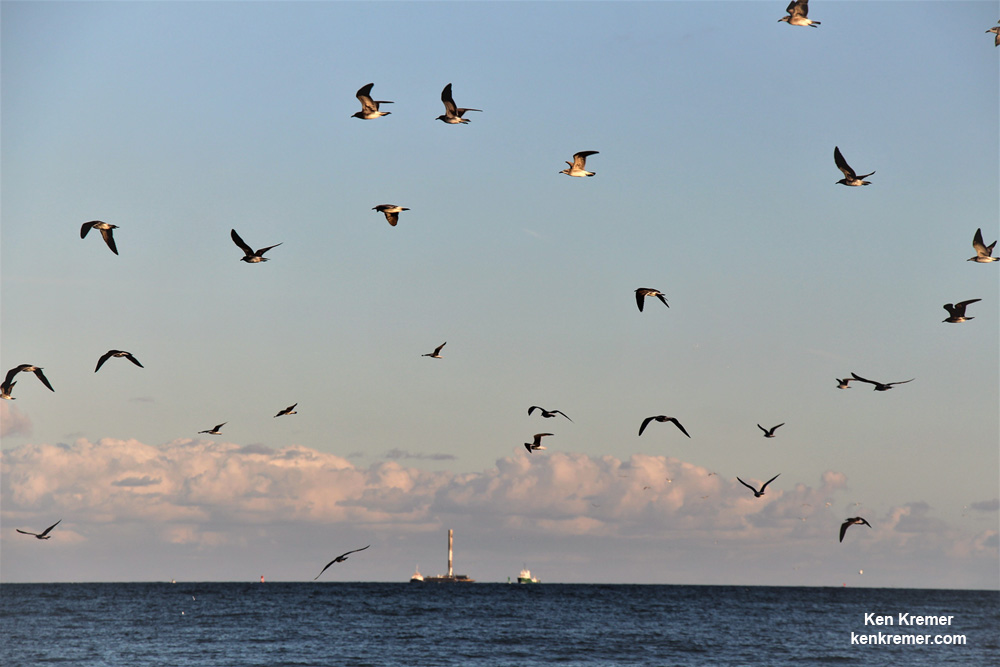
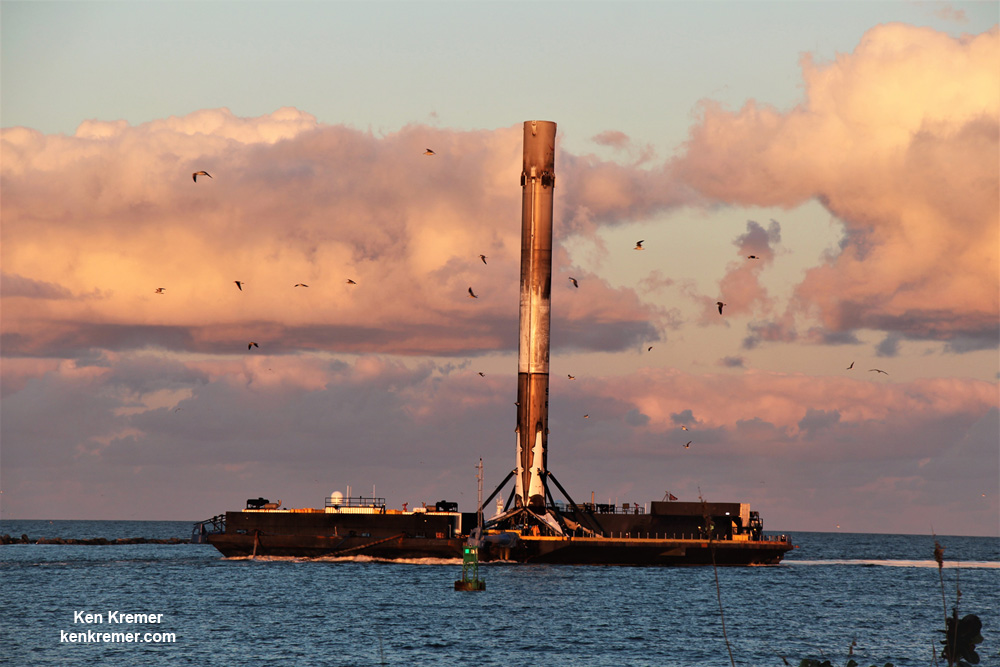
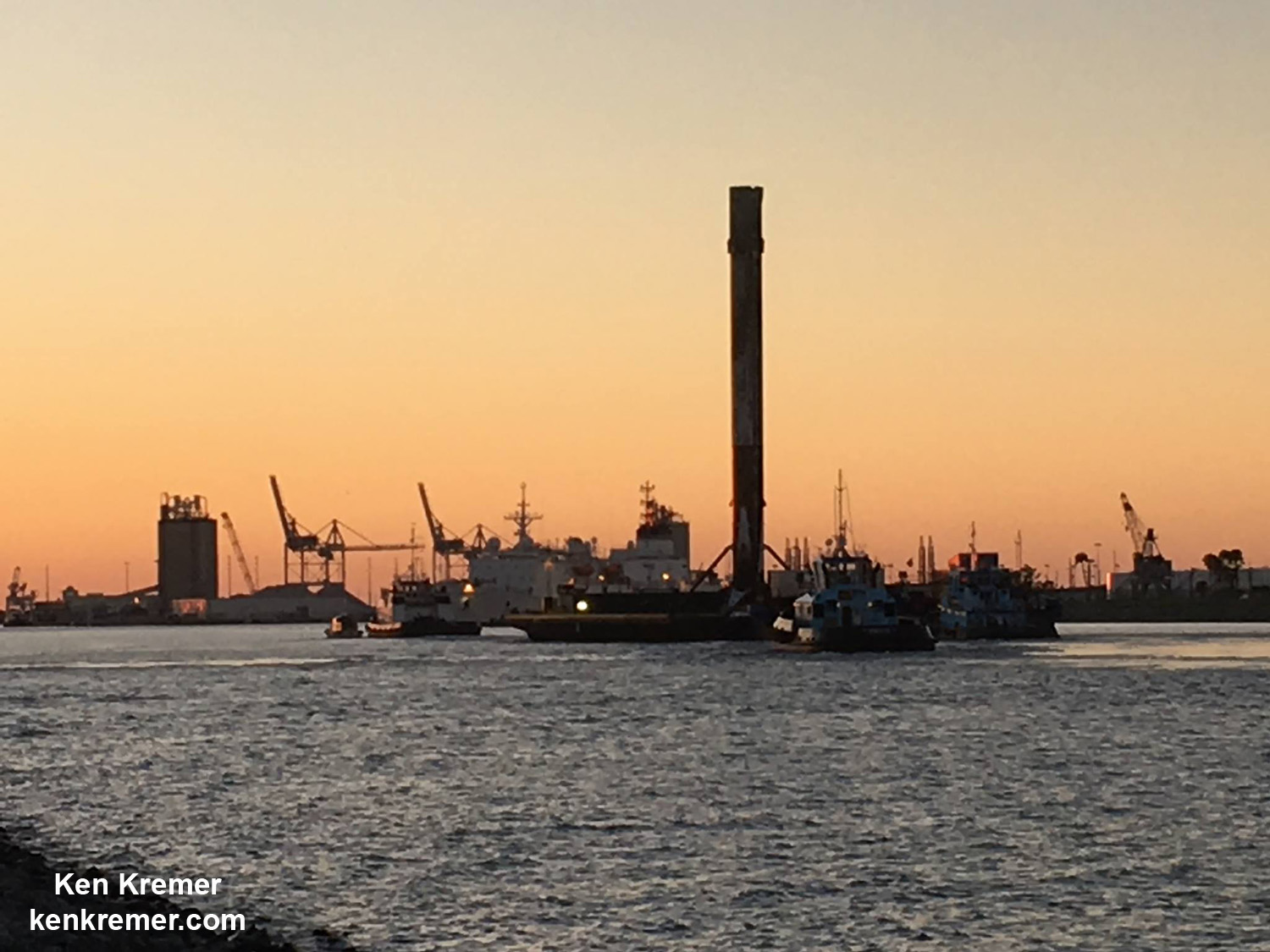

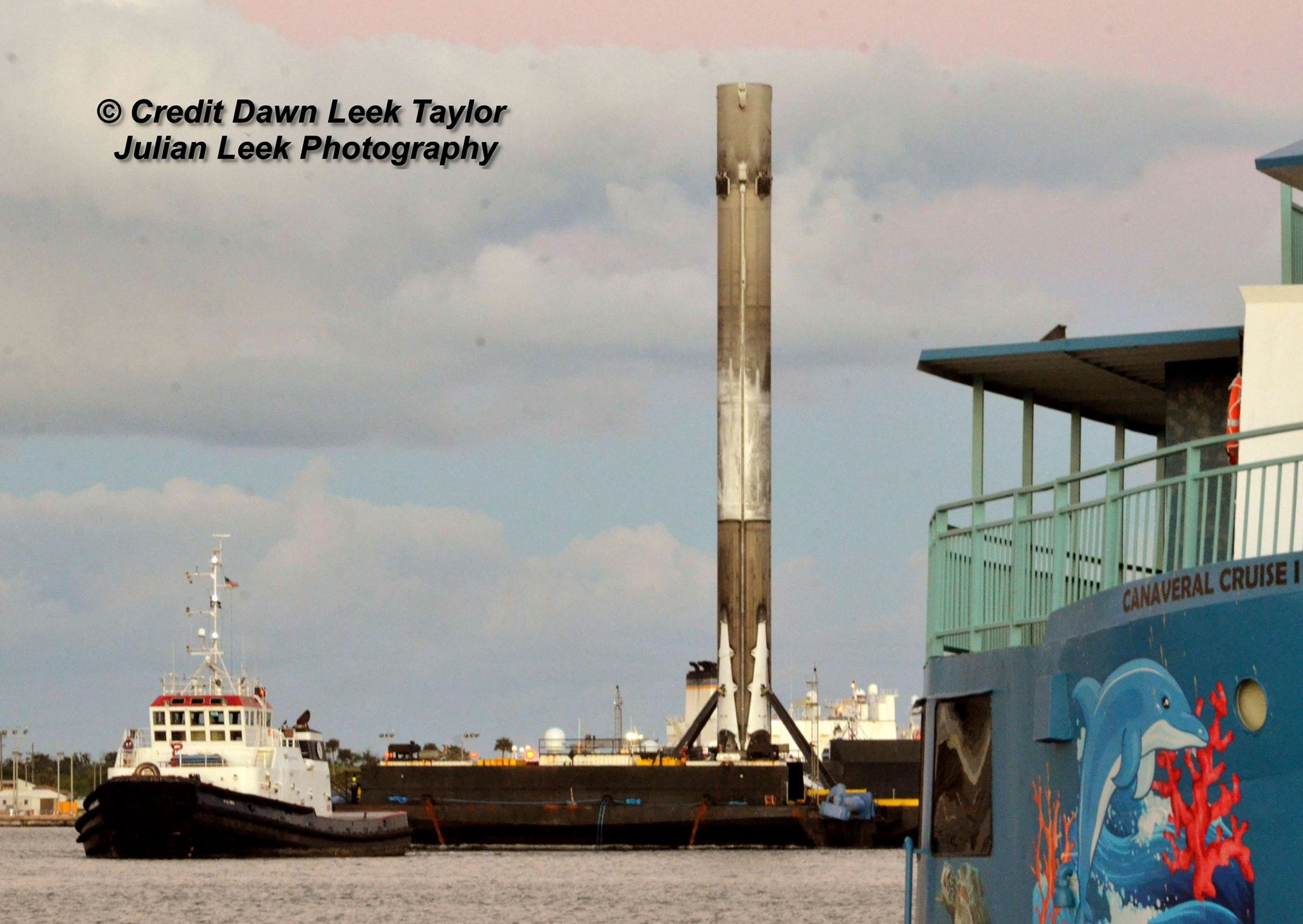
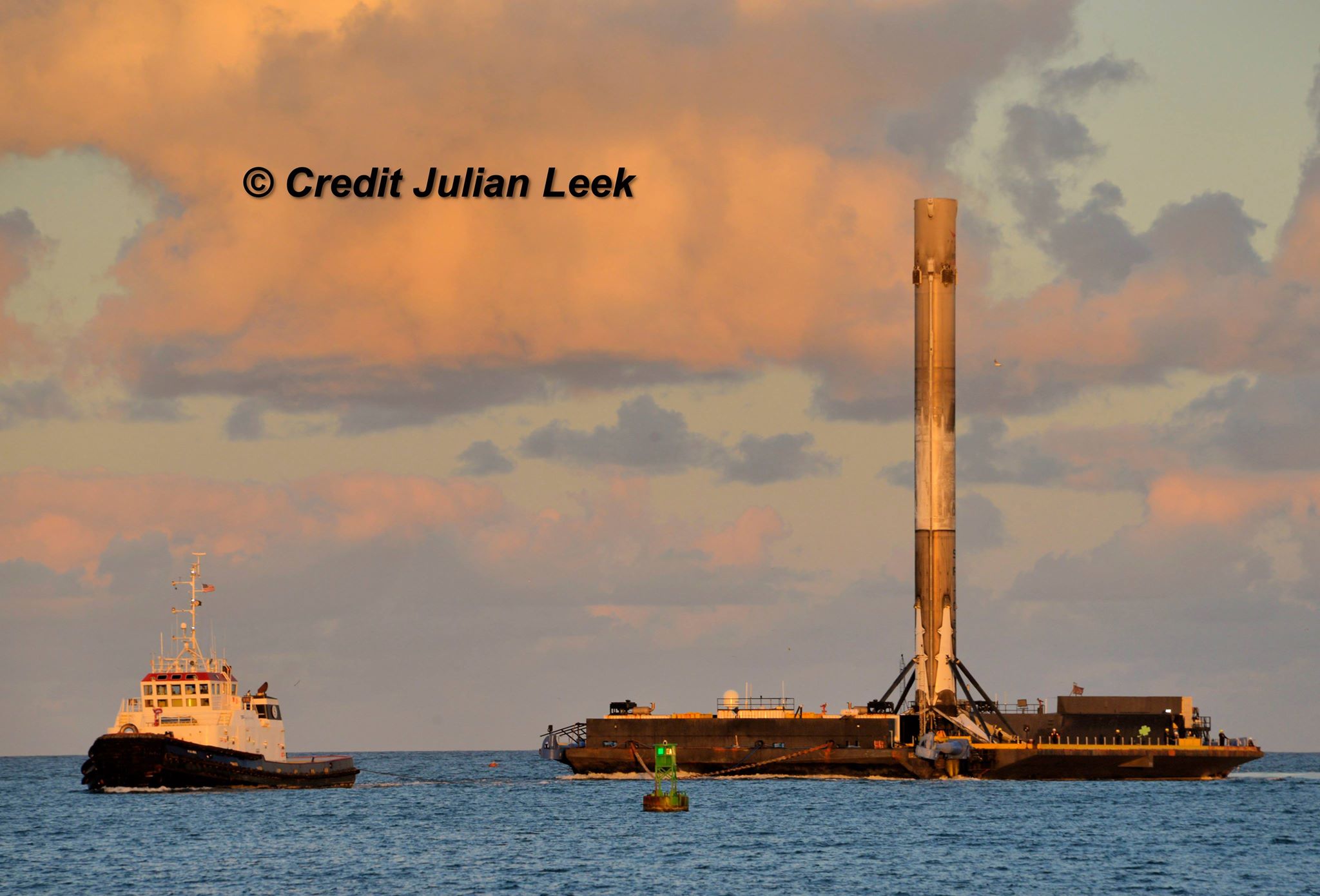
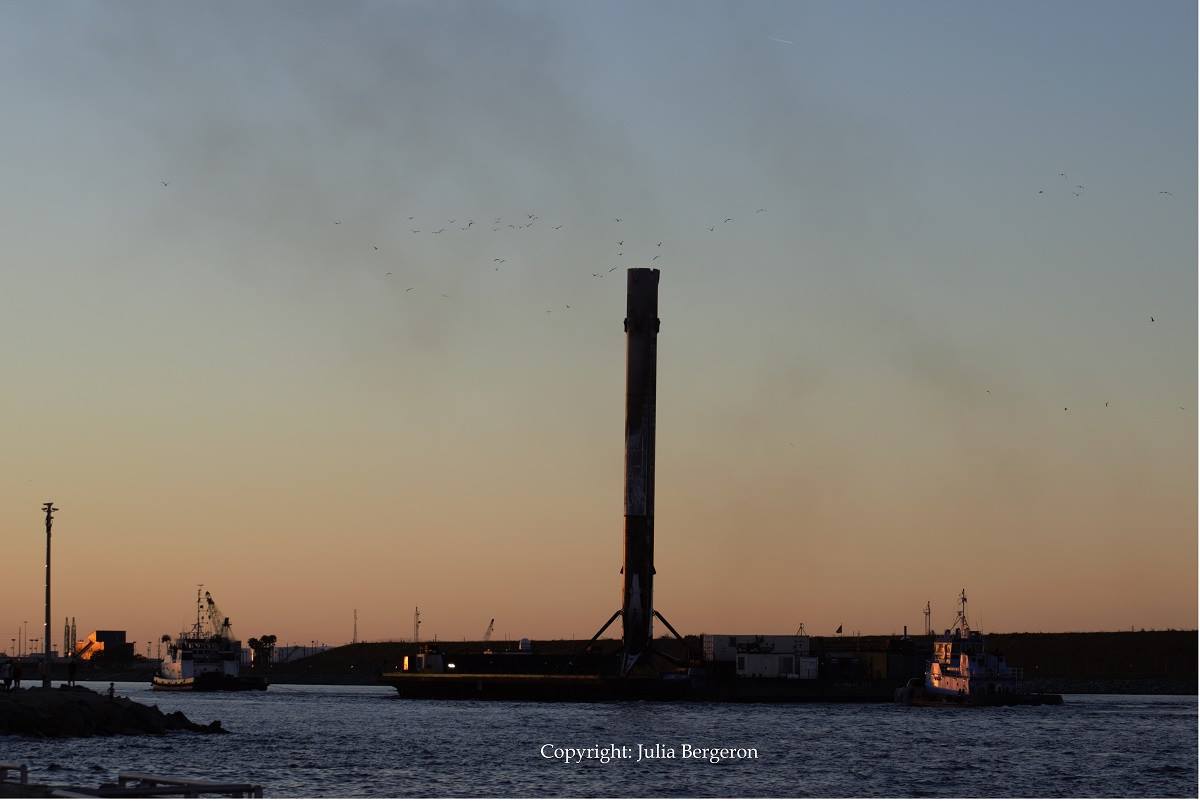
Spectacular SpaceX Falcon 9 KoreaSat Launch Lights Space Coast Sky with Halloween Eve Glow, Booster Lands at Sea
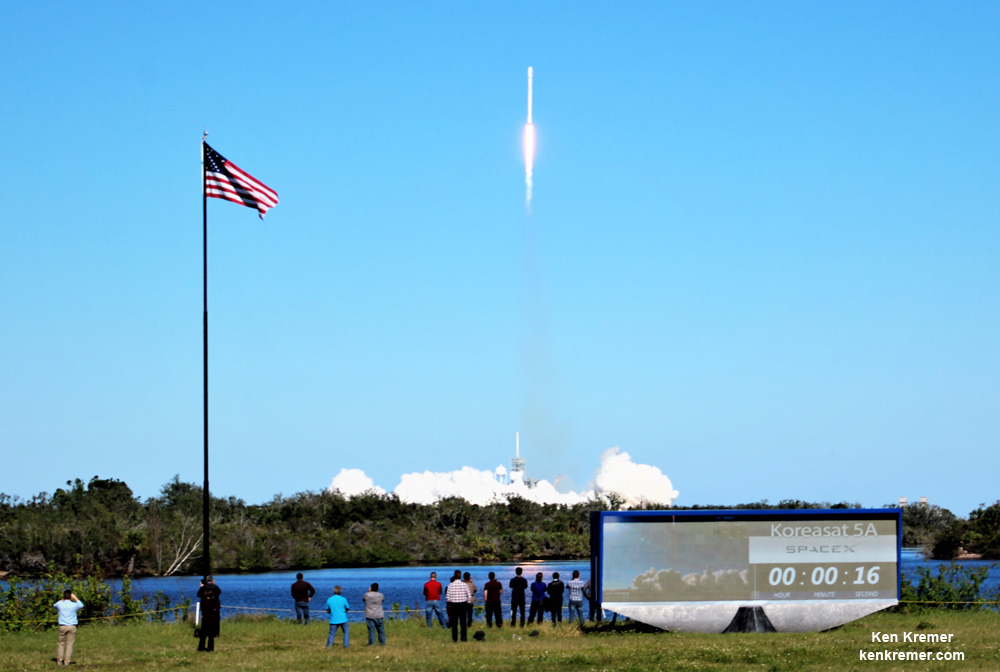

KENNEDY SPACE CENTER, FL – SpaceX delivered a spectacular Halloween eve delight with today’s Falcon 9 launch of a Korean HDTV satellite that lit up the Florida Space Coast skies with a glow that delighted kids of all ages and ghouls alike and put an end at last for today to the atrocious wet and windy weather afflicting the Spaceport region.
The SpaceX Falcon 9 blasted off mid-afternoon Monday Oct. 30 with the private KoreaSat-5A telecomsat mission right at the opening of the launch window at 3:34 p.m. EDT (1934 GMT) from seaside Launch Complex 39A at NASA’s Kennedy Space Center in Florida.
Eight and a half minutes after liftoff the 15 story tall first stage booster nailed another rocket assisted touchdown on the OCISLY droneship pre-positioned several hundred miles off shore of Cape Canaveral in the Atlantic Ocean.
Today’s mission marks the 16th launch by SpaceX this year, the 2nd this month by the new space firms Falcon 9 rocket from Florida’s Spaceport, and the third overall counting another liftoff from Vandenberg AFB, Calif. – thus maintaining an absolutely torrid and record setting yearly launch pace.
The launch was broadcast live on a SpaceX dedicated webcast.
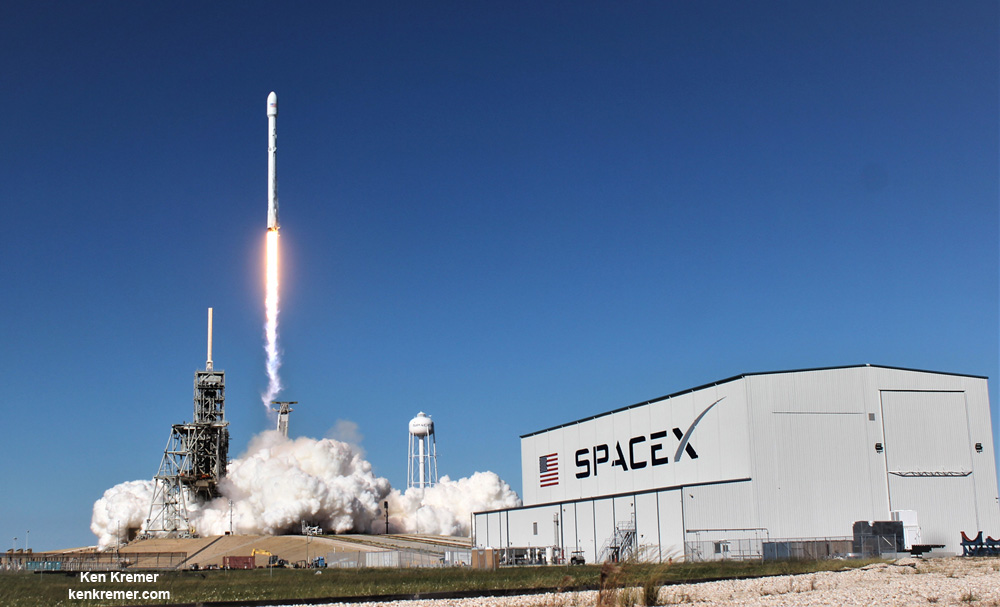
Florida finally fulfilled its billing as the ‘Sunshine State’ with truly superb afternoon weather for Monday afternoon’s liftoff of a SpaceX Falcon 9 with its first Korean satellite customer – and the decent weather outlook looks like it will extend into Tuesdays Halloween trick or treating for the local kiddies and their imaginative costumes.
The two stage 229-foot-tall (70-meter-tall) Falcon 9 rocket shined at sunrise this morning and throughout the countdown and fueling process fed the falcon with RP-1 and liquid oxygen propellant powering the rockets nine first stage Merlin 1D engines.
Altogether the Merlin 1D engine delivered a powerful liftoff punch that was far more than a Halloween ‘boo’ as the engines ignited with 1.7 million pounds of liftoff thrust.
As the Falcon 9 roared off launch pad 39A a rumbling thunder reverberated across the space coast region and beyond that brought broad smiles of glee to spectators faces packing local area beaches and hotels and quickly dispatched wicked ghouls to their graves.
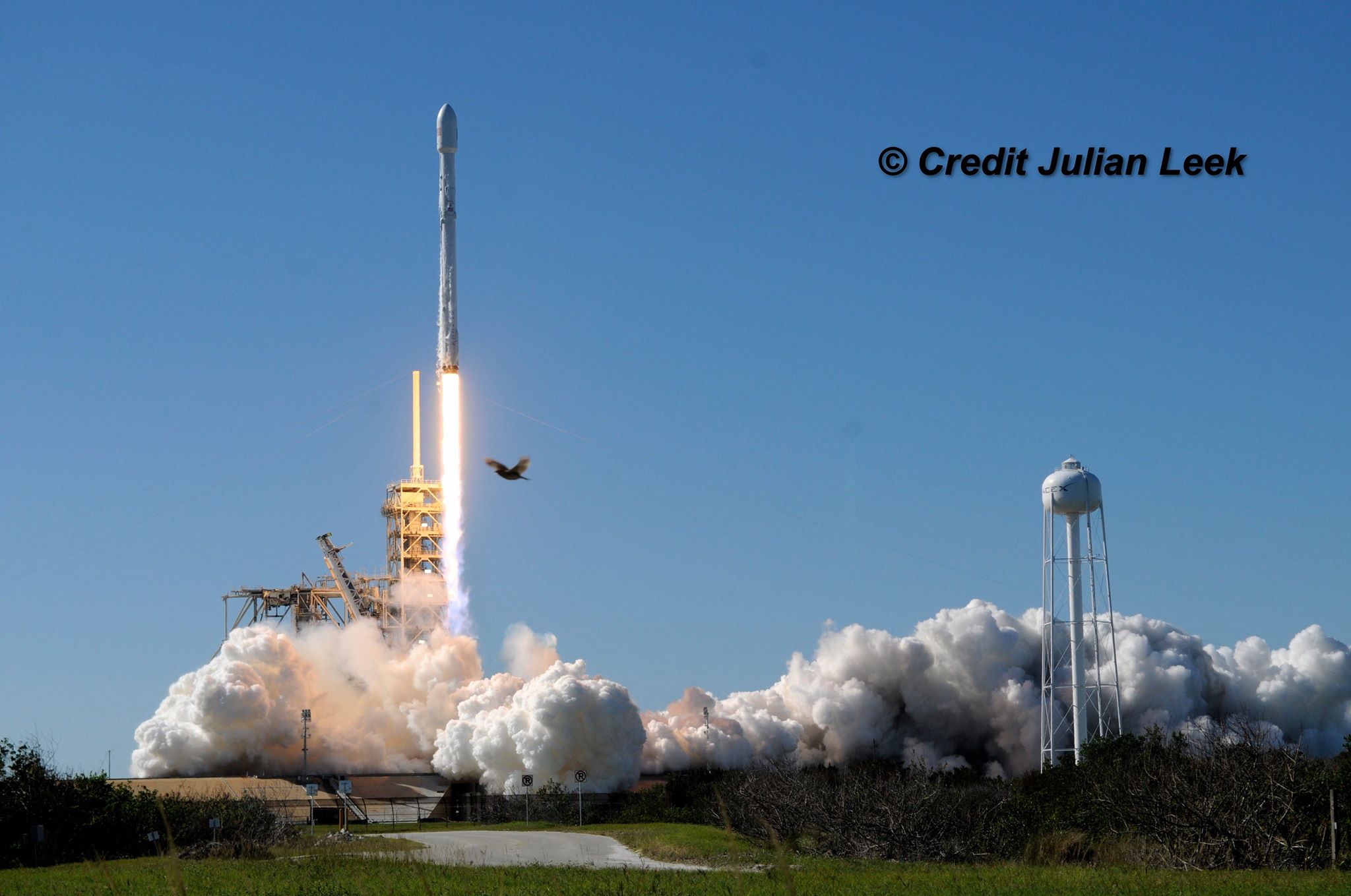
Trick or treaters will have a fine Halloween indeed following SpaceX’s thunderous rocket launch into picture perfect clear blue skies that were set of fire as the rocket vaulted off the pad and arched over eastwards to the African continent as it accelerated to the heavens.
The SpaceX Falcon 9 successfully delivered Koreasat-5A to a geostationary transfer orbit (GTO).
Satellite deployment took place as planned 35 minutes after launch as seen on the webcast.
“Successful deployment of Koreasat-5A to geostationary transfer orbit confirmed,” said SpaceX.
The launch was also accompanied by a successful attempt to recover the 156 foot tall first stage booster after completing its primary satellite delivery mission task.
Choppy seas from Tropical Storm Phillipe made the sea landing even more challenging.
SpaceX engineers guided it to a landing on the tiny OCISLY drone ship for an upright and intact pinpoint soft landing touchdown on the ocean going platform prepositioned off shore in the Atlantic Ocean – some 8 minutes after blastoff.
OCISLY or “Of Course I Still Love You” left Port Canaveral several days ahead of the planned Oct. 30 launch and was prepositioned in the Atlantic Ocean several hundred miles (km) off the US East coast, awaiting the boosters approach and pinpoint propulsive soft landing.
“Falcon 9 first stage has landed on the Of Course I Still Love You droneship.” announced SpaceX.
“A little toasty, but stage one is certainly still intact on the droneship.”
A small fire broke out on the Falcon 9 atop the droneship after landing as seen on the webcast but it was quickly extinguished.
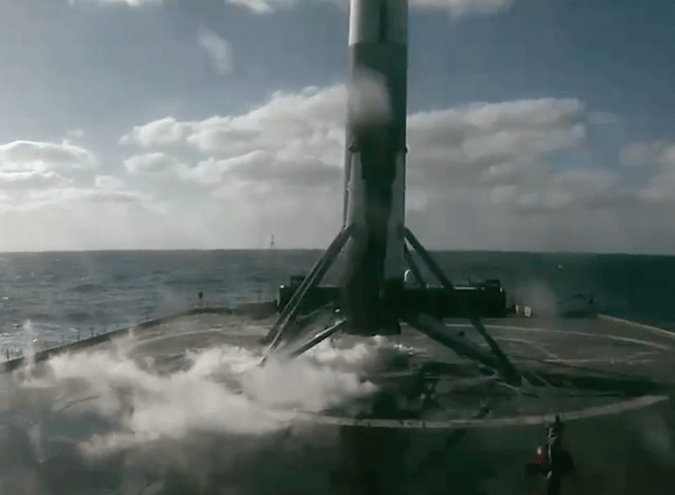
The nearly two ton commercial KoreaSat-5A satellite will provide Direct to Home (DTH) broadcasting, maritime, internet and other services to the Asian region centering around South Korea.
It has a 15 year design lifetime.
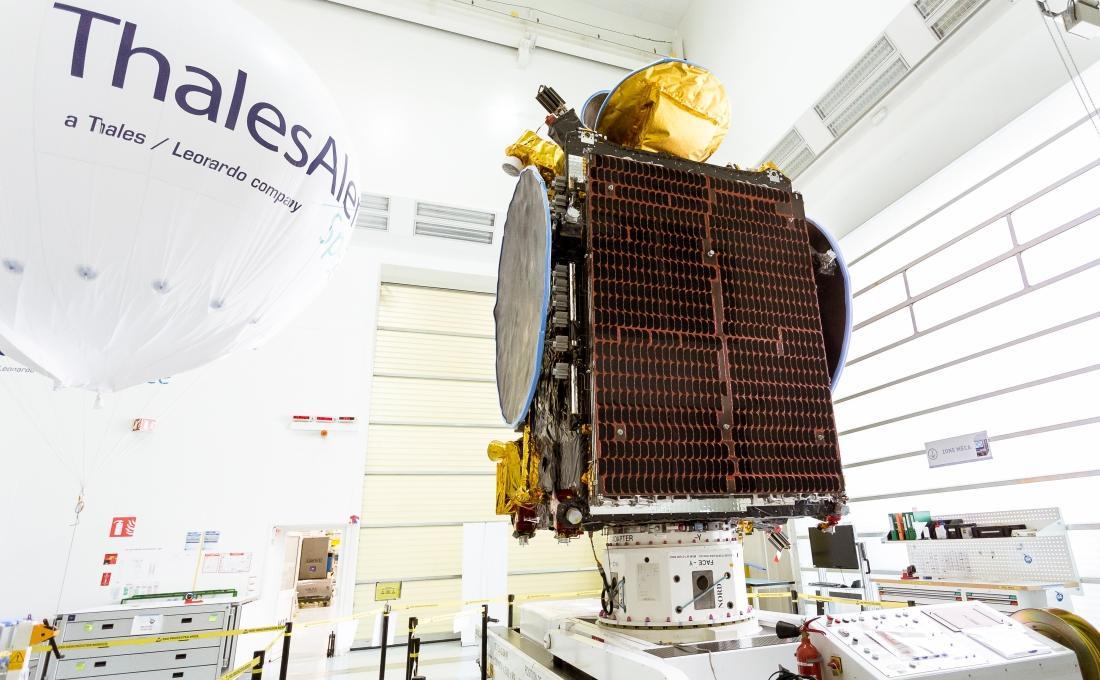
KoreaSat-5A was built by Thales Alenia Space and launched by SpaceX under a commercial contract for South Korean operator KTSAT (a KT Corporation company) using a freshly built first stage booster.
KTSAT is South Koreas sole satellite service provider.
Of course North Koreans have no access to any of these services as they are forbidden under the regime of Kim Jong Un with severe penalties for any violators.
The satellite was attached to the booster encapsulated in the nose cone last Friday after engineers successfully completed the routine but required static hot fire test of the first stage engines last Thursday, Oct 26.
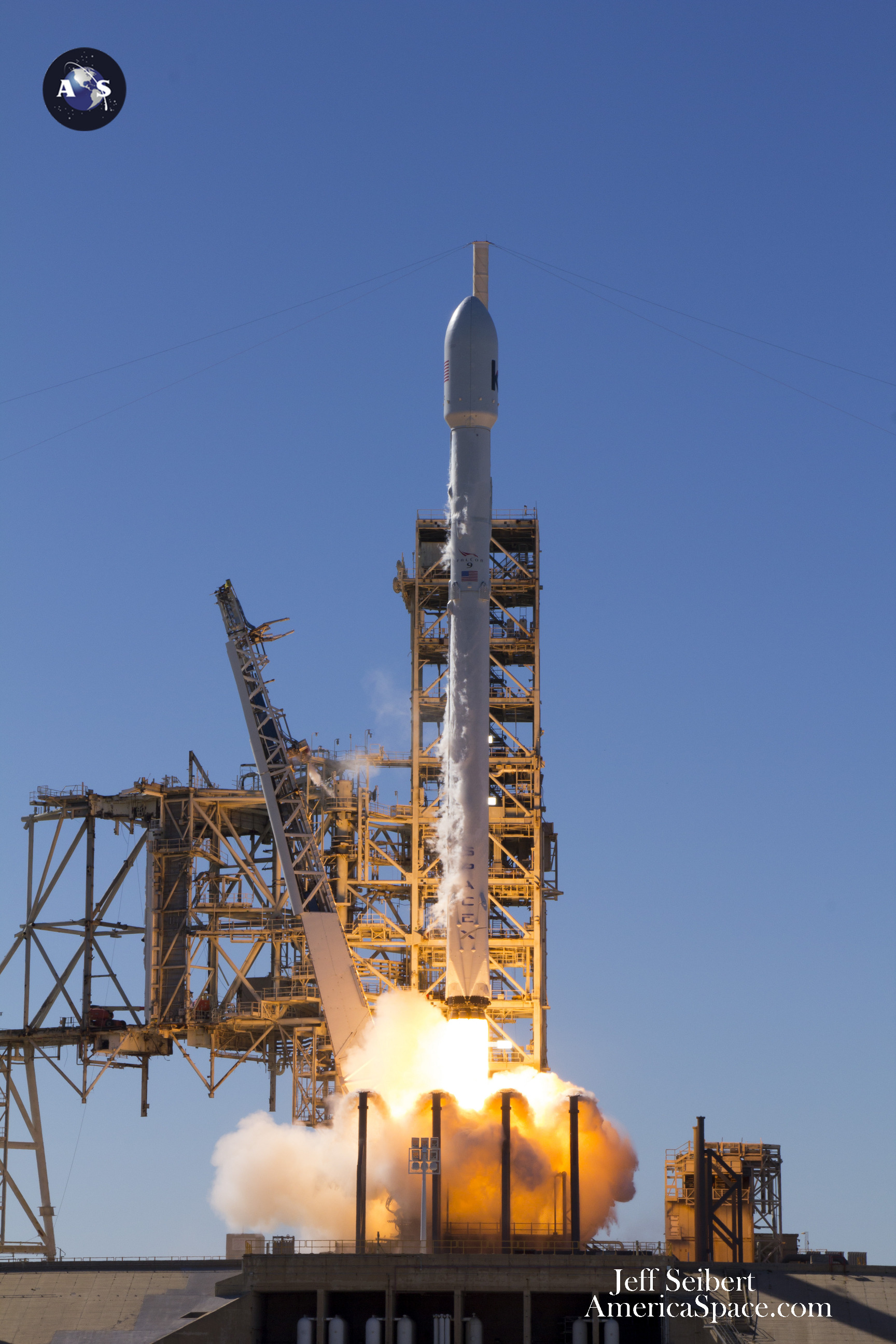
Koreasat-5A was built by prime contractor, Thales Alenia Space, responsible for the design, production, testing and ground delivery. It arrived at the Florida launch base on Oct. 5 for integration with the Falcon 9 rocket.
The 3,700 kg (8,160 lb) satellite is equipped with 36 Ku-band transponders and based on Thales Alenia Space’s new-generation Spacebus 4000B2 platform. It will replace Koreasat 5 launched a decade ago in 2006.
The solar panels provide a payload power of approximately 6.5 kW. It will be positioned at 113° East and provide coverage for Indochina, Japan, Korea, the Philippines and the Middle East including Direct to Home (DTH) services.
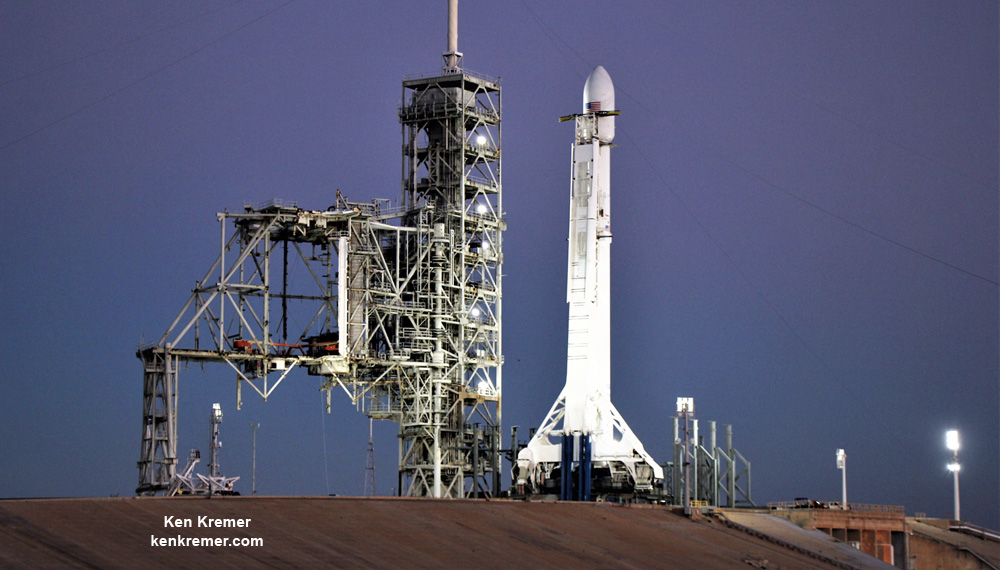
Pad 39A has been repurposed by SpaceX from its days as a NASA shuttle launch pad.
To date SpaceX has now accomplished 19 successful landings of a recovered Falcon 9 first stage booster by land and by sea.
The KoreaSat-5A booster is expected back into Port Canaveral later this week – and the public can watch the sailing action.
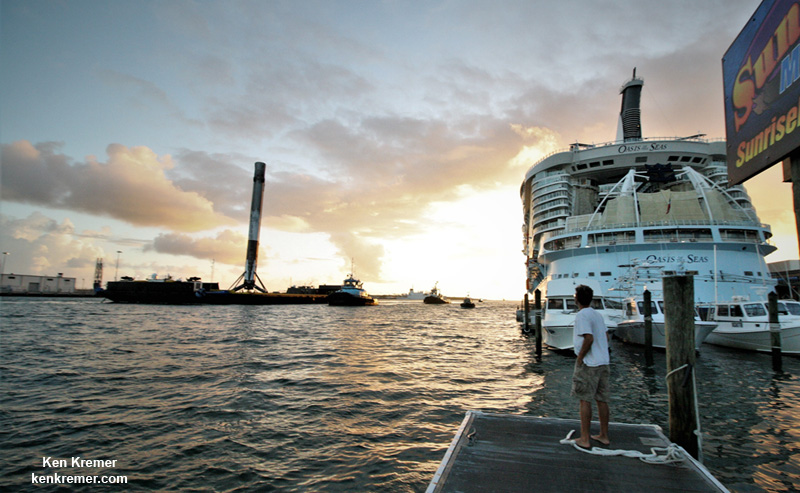
The first stage from this months SES-11 launch arrived back into Port Canaveral, FL on top of the OCISLY droneship on Oct. 15. The SES-11 comsat launched on Oct. 11.
Watch for Ken’s continuing onsite coverage of SpaceX KoreaSat-5A & SES-11, ULA NROL-52 and NASA and space mission reports direct from the Kennedy Space Center and Cape Canaveral Air Force Station, Florida.
Stay tuned here for Ken’s continuing Earth and Planetary science and human spaceflight news.
Ken Kremer
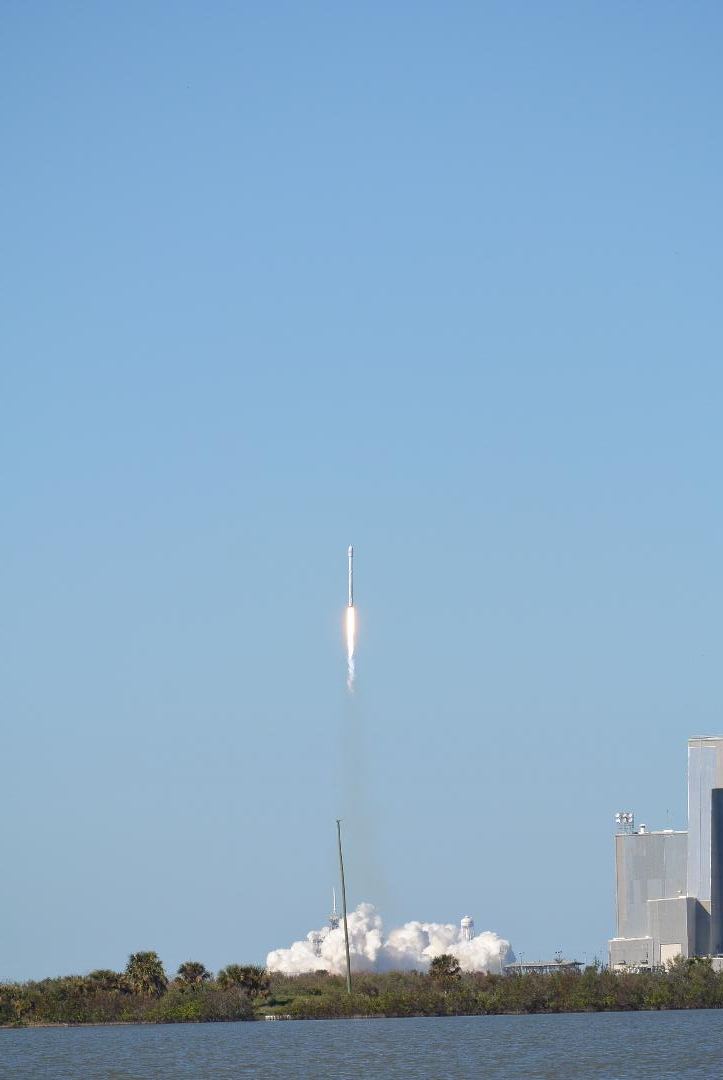
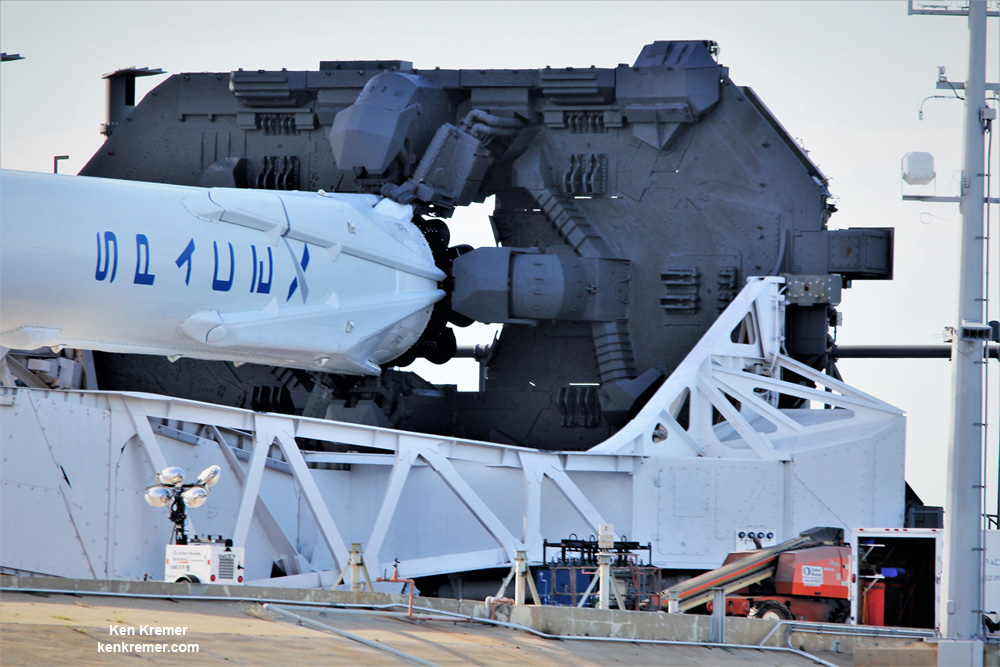
Superb Weather Forecast for SpaceX Halloween Eve Launch and Landing from Florida with 1st Korean Satellite: Watch Live


KENNEDY SPACE CENTER, FL – After seemingly endless bouts of damaging rain squalls and flooding, Florida is at last living up to its billing as the ‘Sunshine State’ with some superb weather forecast for Monday afternoon’s scheduled liftoff of a SpaceX Falcon 9 with its first Korean customer – on the eve of Halloween.
SpaceX engineers are targeting the Falcon 9 for a mid-afternoon liftoff with the private KoreaSat-5A telecomsat mission for a window that opens at 3:34 p.m. EDT (1934 GMT) Monday Oct. 30 from seaside Launch Complex 39A at NASA’s Kennedy Space Center in Florida.
The two stage 229-foot-tall (70-meter-tall) Falcon 9 rocket was raised to vertical launch position later Sunday afternoon.
The launch will also be accompanied by an attempt to recover the first stage booster by soft landing on an ocean going platform prepositioned off shore in the Atlantic Ocean – some 8 minutes after blastoff.
If all goes well, SpaceX will conduct their 16th launch this year and the 2nd this month by the new space firms Falcon 9 rocket from Florida’s Spaceport – maintaining an absolutely torrid and record setting yearly launch pace.
Space enthusiasts and Halloween trick or treaters alike will surely enjoy the heavenly fireworks display. And to top that off the procedure to recover the rockets first stage has been described as riding a ‘witches broom’ in the middle of a hurricane since the 15 story tall stick has to flip around and fire its engines while traveling at several thousand miles per hour to place it on course for the droneship.
The KoreaSat liftoff will also count as October’s third from the increasingly busy Florida Space Coast capping two earlier missions carried out by both ULA and SpaceX.

KoreaSat-5A was built by Thales Alenia Space and is being launched by SpaceX under a commercial contract for South Korean operator KTSAT (a KT Corporation company) using a new first stage booster.
The satellite was attached to the booster encapsulated in the nose cone over the weekend after engineers successfully completed the static hot fire test of the first stage engines on Thursday, Oct 26.
The nearly two ton commercial KoreaSat-5A satellite will provide Direct to Home (DTH) broadcasting, maritime, internet and other services to the Asian region centering around South Korea.
You can watch the launch live on a SpaceX dedicated webcast starting about 10 minutes prior to the 3:34 p.m. EDT (1934 GMT) liftoff time.
Watch the SpaceX broadcast live at: SpaceX.com/webcast
The launch window for the newly built booster extends nearly two and a half hours until it closes at 5:58 p.m. EDT (2158 GMT).
The weather outlook is uncommonly excellent along the Florida Space Coast with a greater than 90% chance of favorable conditions at launch time according to U.S. Air Force meteorologists with the 45th Space Wing Weather Squadron at Patrick Air Force Base.
The primary concerns on Oct. 30 are only for Liftoff Winds.
The odds remain high at 90% favorable for the 24 hour scrub turnaround day on Halloween Day, Tuesday Oct. 31.
Tropical Storm Philippe is not an issue and has moved north of the Bahamas and will continue moving northeastward at 30 mile per hour today says the AF.
Temperatures will be cool however on Monday dipping into the 50s and 60s.
The SpaceX Falcon 9 will deliver Koreasat-5A to a geostationary transfer orbit (GTO).
After the 156 foot tall first stage booster completes its primary mission task, SpaceX engineers seek to guide it to a second landing on the tiny OCISLY drone ship for a soft touchdown some eight and a half minutes after liftoff.
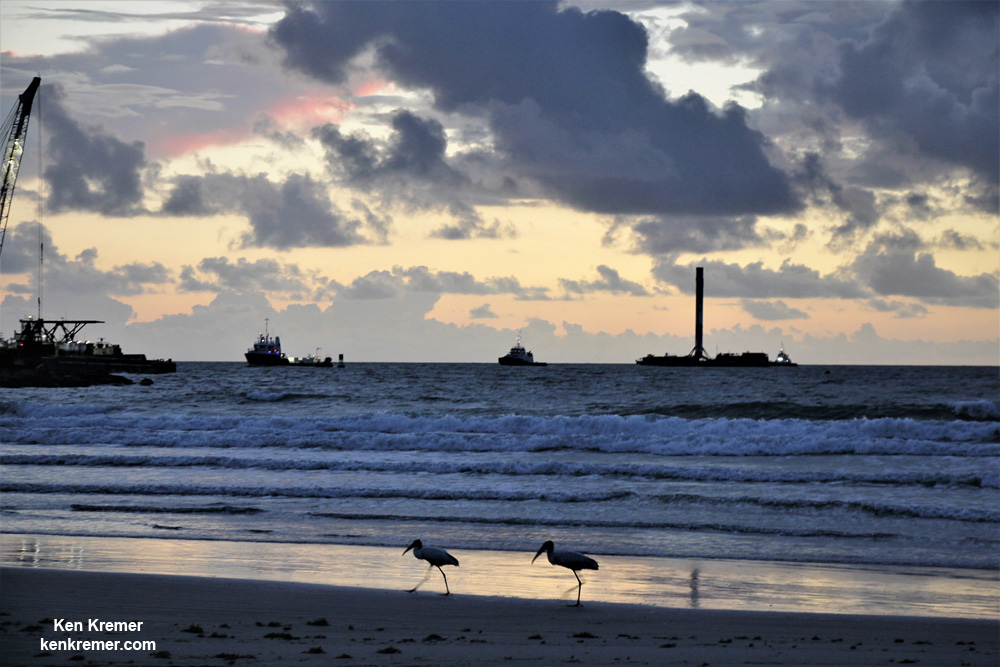
OCISLY or “Of Course I Still Love You” left Port Canaveral several days ahead of the planned Oct. 30 launch and may be prepositioned in the Atlantic Ocean some 400 miles (600 km) off the US East coast, just waiting for the boosters approach and pinpoint propulsive soft landing.
The path to an October launch trifecta from Florida’s Spaceport was cleared following SpaceX’s successful static fire test of the Falcon 9 boosters first stage engines this past Thursday afternoon, Oct. 26.
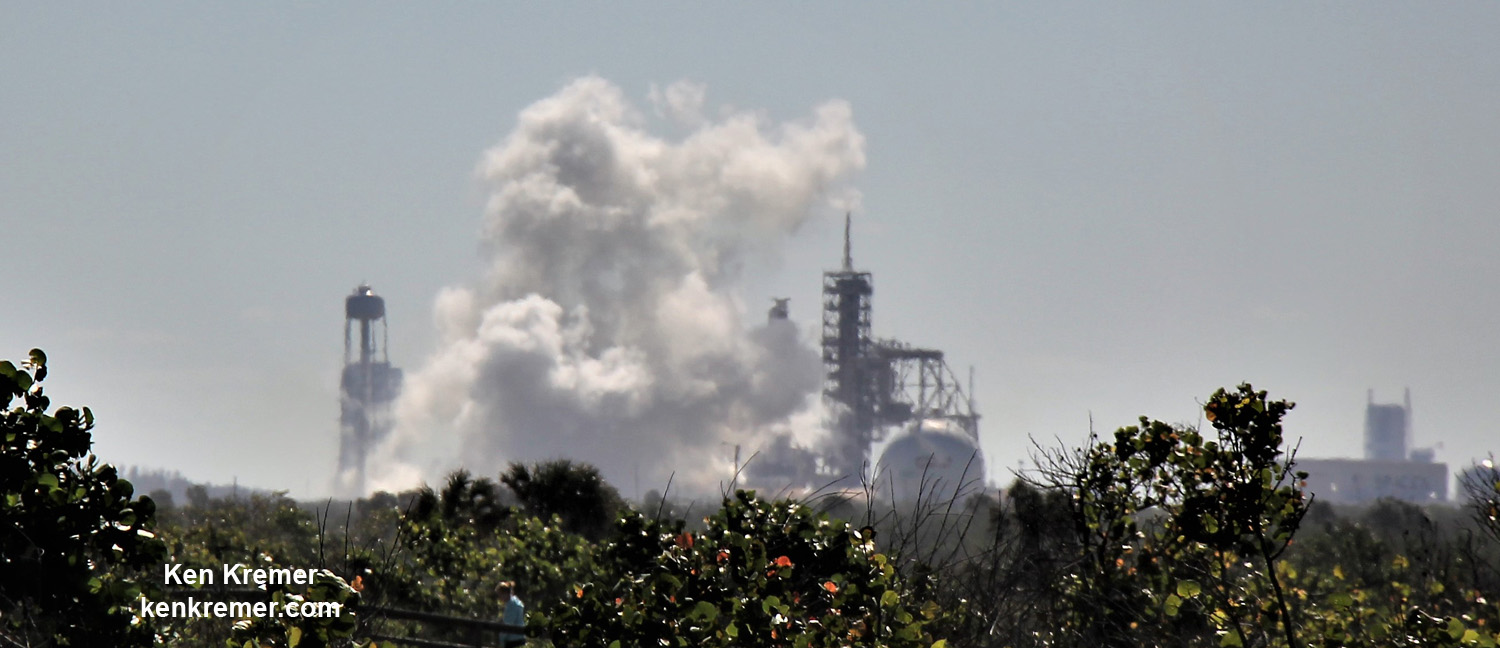
Koreasat-5A was built by prime contractor, Thales Alenia Space, responsible for the design, production, testing and ground delivery. It arrived at the Florida launch base on Oct. 5 for integration with the Falcon 9 rocket.
The 3,700 kg satellite is equipped with 36 Ku-band transponders and based on Thales Alenia Space’s new-generation Spacebus 4000B2 platform. It will replace Koreasat 5.
The solar panels provide a payload power of approximately 6.5 kW. It will be positioned at 113° East and provide coverage for Indochina, Japan, Korea, the Philippines and the Middle East including Direct to Home (DTH) services.
Pad 39A has been repurposed by SpaceX from its days as a NASA shuttle launch pad.
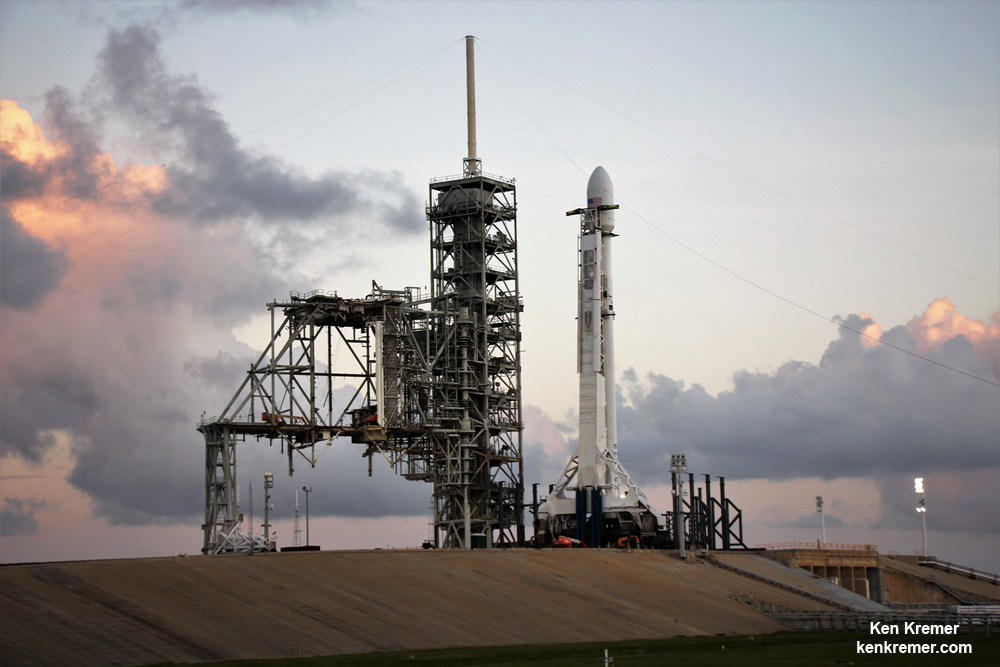
To date SpaceX has accomplished 18 successful landings of a recovered Falcon 9 first stage booster by land and by sea.
The first stage from this months SES-11 launch arrived back into Port Canaveral, FL on top of the OCISLY droneship on Oct. 15. The SES-11 comsat launched on Oct. 11.
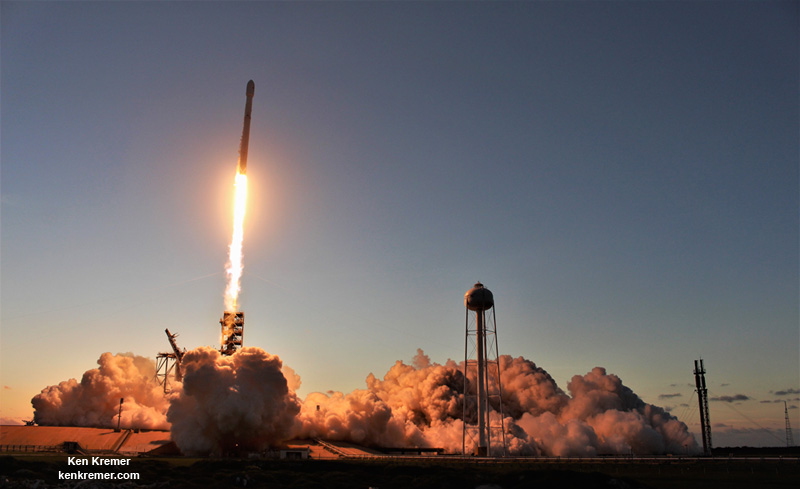
Watch for Ken’s continuing onsite coverage of SpaceX KoreaSat-5A & SES-11, ULA NROL-52 and NASA and space mission reports direct from the Kennedy Space Center and Cape Canaveral Air Force Station, Florida.
Stay tuned here for Ken’s continuing Earth and Planetary science and human spaceflight news.
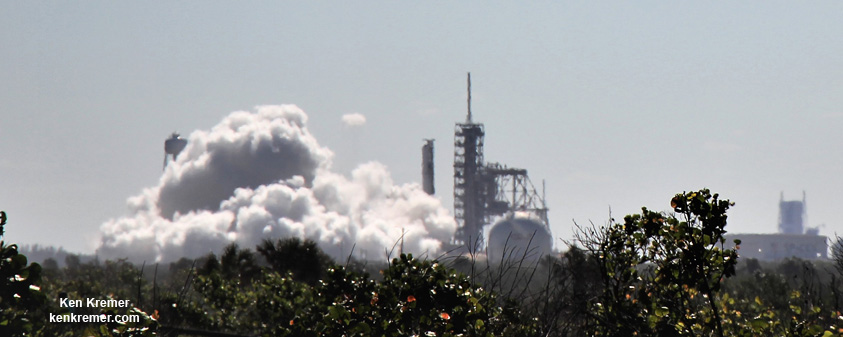


Twice Flown SpaceX Booster Sails Proudly into Port Canaveral at Sunrise 3 Days After Sunset Launch and Droneship Landing: Photos
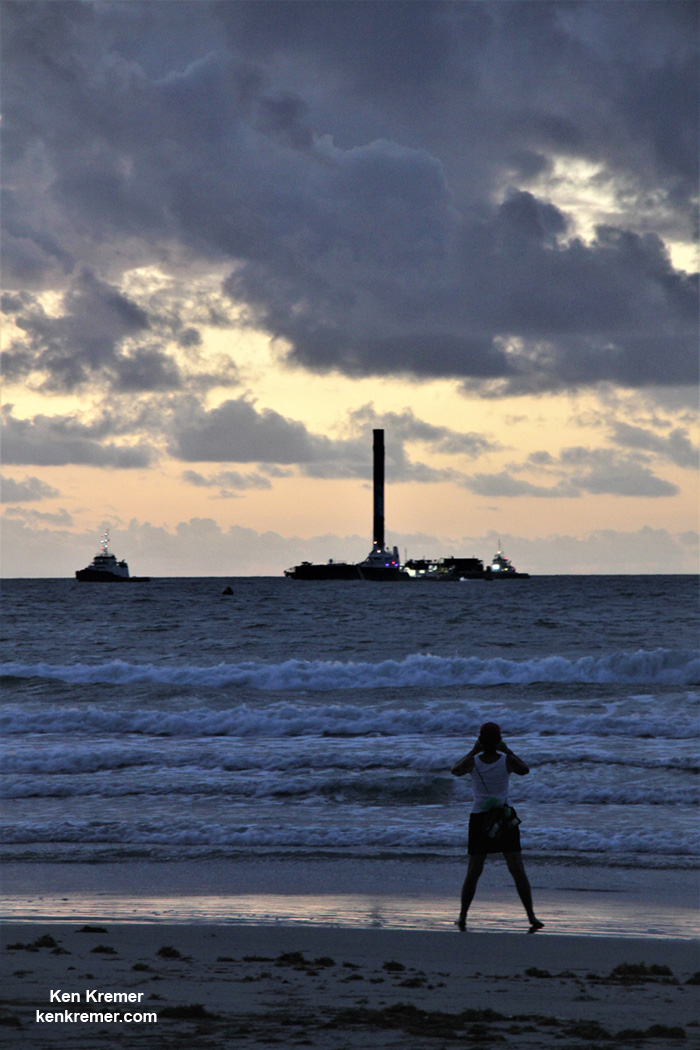

PORT CANAVERAL/KENNEDY SPACE CENTER, FL – The now twice flown SpaceX first stage booster that successfully delivered the SES-11 UHDTV satellite to orbit at sunset Wednesday, Oct 11, sailed proudly back home into Port Canaveral during a beautiful Sunday sunrise, Oct. 15 only three days after it safely landed on a tiny droneship at sea.
The booster arrival also took place just hours after a ULA Atlas launched the covert NROL-52 surveillance satellite for the US National Reconnaissance Office (NRO) – making for a nonstop day of space action on the Florida Space Coast.
The 156-foot-tall Falcon 9 booster accomplished a precision guided rocket assisted touchdown on the football field sized OCISLY droneship platform about 8 minutes after the dinnertime liftoff with the private SES-11/EchoStar 105 communications satellite on Oct. 11 at 6:53 p.m. EDT from seaside Launch Complex 39A at NASA’s Kennedy Space Center in Florida.
The 15 story tall first stage came to rest slightly tilted a few degrees, similar to at least two prior boosters that soft landed upright on OCISLY while prepositioned several hundred miles off shore of the Florida peninsula in the Atlantic Ocean.
The recycled booster was towed into Port Canaveral by a SpaceX contracted tugboat accompanied by a small fleet of pilot ships and support vessels.
The doubly used and doubly successful booster entered the mouth of Port Canaveral around 7:15 a.m. EDT Sunday under dawns delightful twilight I witnessed from Jetty Park and beach together with a few space media colleagues and a small crowd of onlookers with little fanfare.

Over the next hour it was hauled through the narrow channel as numerous vessels large and small and pleasure craft sailed by, likely wondering what they were looking it.
Finally the droneship platform was docked at SpaceX’s spot leased near the two huge shipping cranes dominating the scene across from popular portside restaurants – and also not far from humongous cruise ships dwarfing the booster in size.
The next step was for dock workers to hoist a cap and attach it to the top of the booster. This enabled it to eventually be carefully raised off the barge with a crane by about 1 p.m. and then slowly moved and swung over and affixed onto a restraining pedestal stand on land.


By the next evening Monday night, all 4 landing legs were still intact. After they are all detached the booster will be lowered horizontally aided by the cabling attached by the workers and placed on a flab bed transporter and trucked back to the Cape.
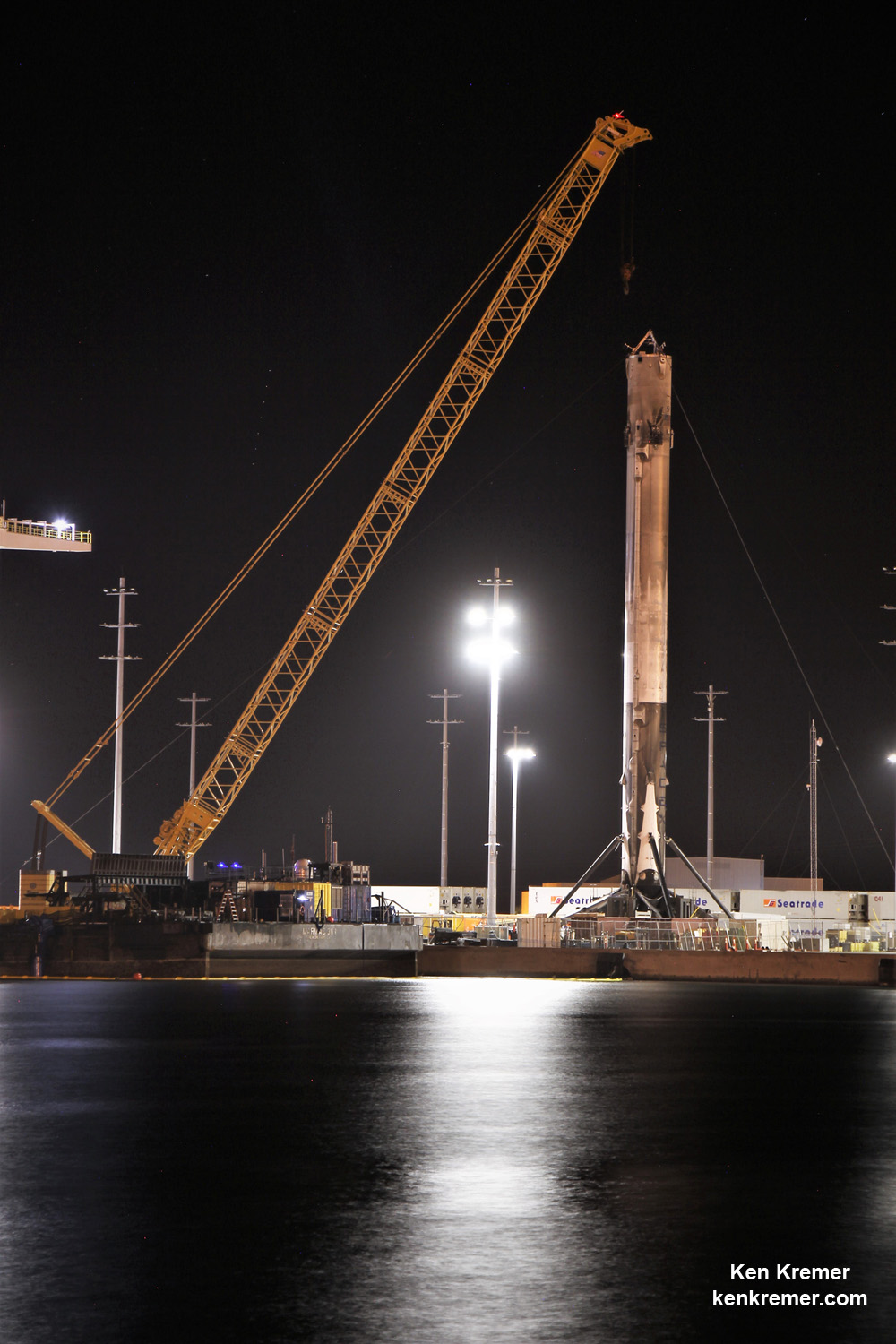
However the impact of developing and reusing ‘used’ rockets is leading to an era when re-flown rockets are offered as a ‘routine service’ rather than the exception.
Rocket reusability is at the heart of the extraordinary vision of billionaire entrepreneur and SpaceX CEO Elon Musk to drastically cut space launch costs and one day build a ‘City on Mars’.
And it represents a ‘major sea change getting closer’ to fruition with each passing day thanks to SpaceX, said SES CTO Martin Halliwell in an exclusive interview with Universe Today, following the stunning sunset blastoff of the SES-11 UHDTV commercial satellite on another ‘flight-proven’ Falcon 9 booster that also re-landed – thus completing another remarkable round of rocket recovery and recycling or ‘launch, land and relaunch!’
“As I’ve said before, I think in a couple years time you won’t even consider whether it’s a preflown rocket or a new rocket or a second time rocket,” SES Chief Technology Officer Martin Halliwell told Universe Today in a one-on-one post launch interview.
“It will just be a flight and you will buy a service to get to orbit – and that will be that!”
“It’s a major sea change,” Halliwell explained. “That’s absolutely true.”
“We’re getting closer to that every day. It’s exactly where we are going. There is no doubt about it.”
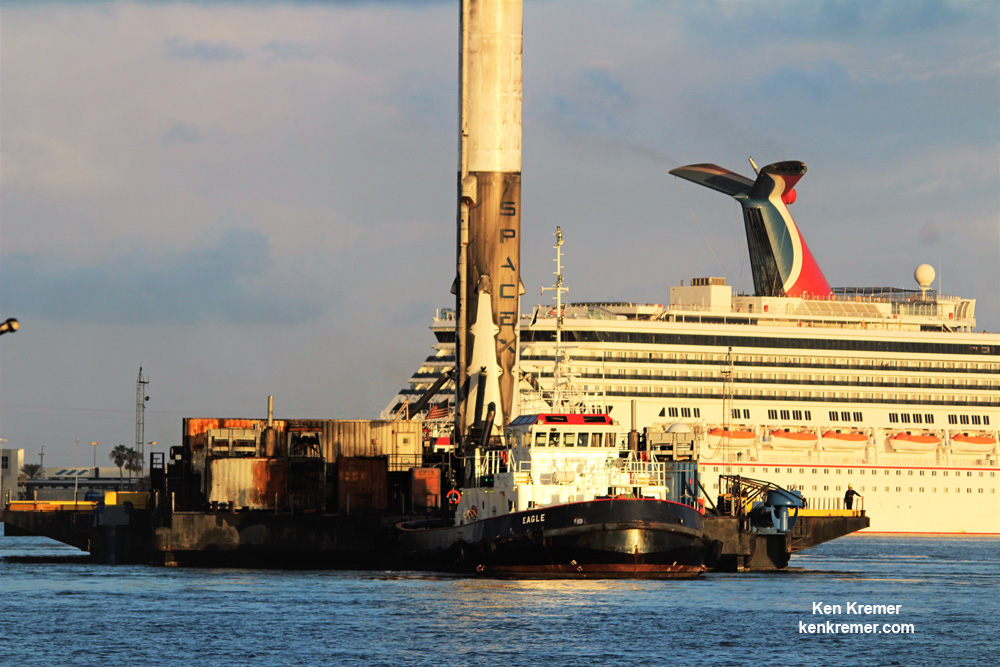
The launch of EchoStar 105/SES-11 counts as only the third recycled SpaceX Falcon 9 ever to be launched and is the third successful mission with a flight-proven orbital class rocket.
All three ‘flight-proven’ missions have lifted off from Pad 39A this year and all three have relanded.
The Falcon 9 first stage appeared to be in good shape upon its return to Port. I did not observe noticeable significant damage to the outside of the booster skin, grid fins or landing legs. Scorching seemed comparable to the first two reflown boosters.
This booster originally flew on the NASA Dragon CRS-10 resupply mission to the International Space Station in February of this year.
On arrival it was clearly anchored to the OCISLY droneship deck with multiple chains as previously done for droneship landings as well as with what appears to be several gripper arms.
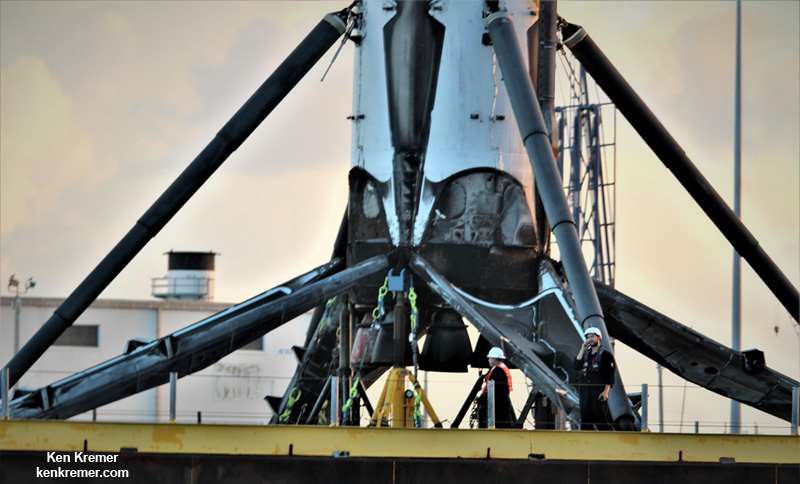
OCISLY, which stands for “Of Course I Still Love You,” had departed Port Canaveral several days ahead of the Oct. 11 launch and was prepositioned in the Atlantic Ocean off the US East coast, just waiting for the boosters 2nd approach and pinpoint propulsive soft landing.
The booster was outfitted with four grid fins and four landing legs to accomplish the pinpoint touchdown on the barge at sea.

SES was the first company to ever fly a payload on a ‘flight-proven’ Falcon 9. The SES-10 satellite lifted off successfully this spring on March 30, 2017.
The second reflown booster successfully launched the BulgariaSat-1 a few months later.
NASA is also assessing whether to utilize a reflown booster on upcoming ISS resupply missions – starting with the next flight of the Dragon CRS-13 cargo ship which may liftoff as soon as early December.
Pad 39A has been repurposed by SpaceX from its days as a NASA shuttle launch pad.
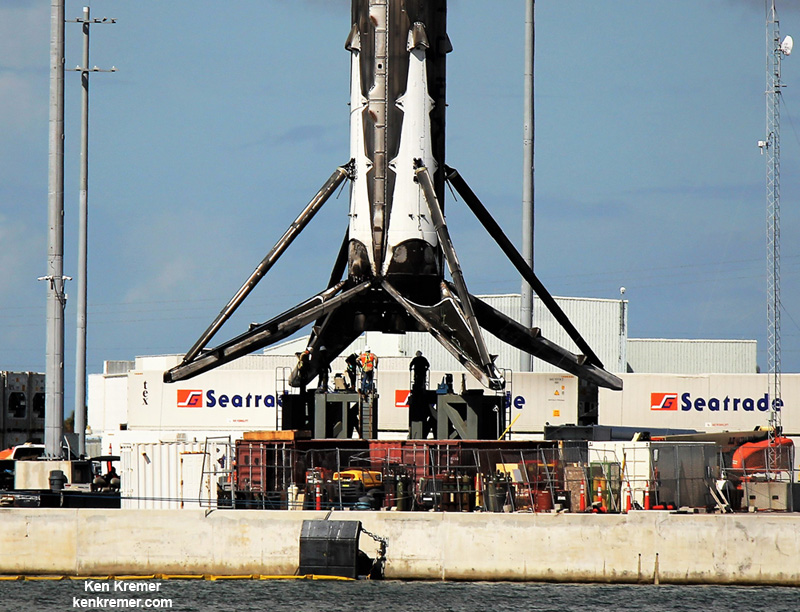
To date SpaceX has accomplished 18 successful landings of a recovered Falcon 9 first stage booster by land and by sea.

Watch for Ken’s continuing onsite coverage of SpaceX SES-11, ULA NROL-52 and NASA and space mission reports direct from the Kennedy Space Center and Cape Canaveral Air Force Station, Florida.
Stay tuned here for Ken’s continuing Earth and Planetary science and human spaceflight news.

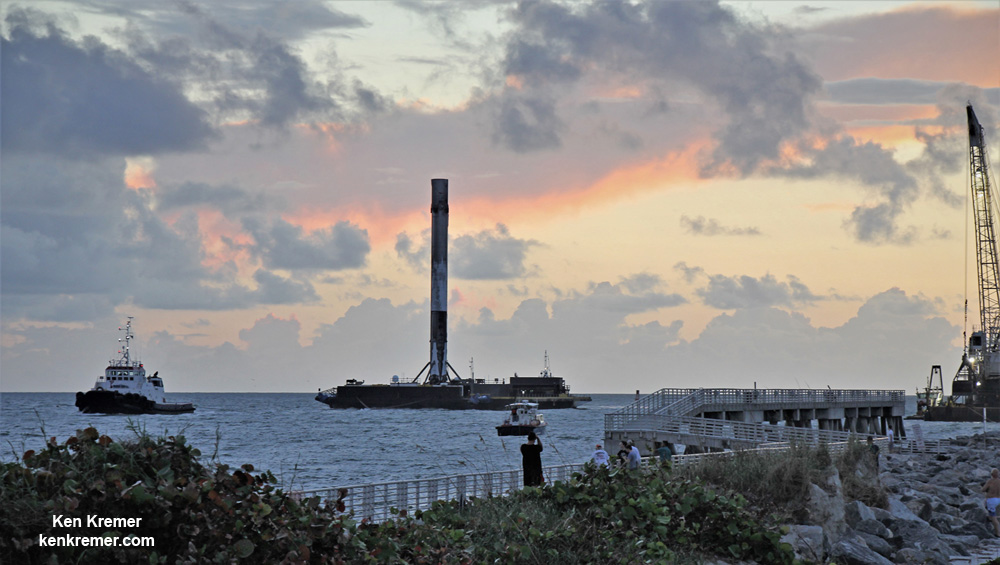
Musk Says Maiden Falcon Heavy to Launch in November, Acknowledges High Risk and Releases New Animation


Before the year is out, the long awaited debut launch of the triple barreled Falcon Heavy rocket may at last be in sight says SpaceX CEO and founder Elon Musk, as he forthrightly acknowledges it comes with high risk and released a stunning launch and landing animation earlier today, Aug. 4.
After years of painstaking development and delays, the inaugural blastoff of the SpaceX Falcon Heavy is currently slated for November 2017 from NASA’s Kennedy Space Center in Florida, according to Musk.
“Falcon Heavy maiden launch this November,” SpaceX CEO and billionaire founder Elon Musk tweeted last week.
“Lot that can go wrong in the November launch …,” Musk said today on Instagram, downplaying the chances of complete success.
And to whet the appetites of space enthusiasts worldwide, just today Musk also published a one minute long draft animation illustrating the Falcon Heavy triple booster launch and how the individual landings of the trio of first stage booster cores will take place – nearly simultaneously.
https://www.instagram.com/p/BXXiVWFgphb/
Video Caption: SpaceX Falcon Heavy launch from KSC pad 39A pad and first stage booster landings. Credit: SpaceX
“Side booster rockets return to Cape Canaveral,” explains Musk on twitter. “Center lands on droneship.”
The two side boosters will be recycled from prior Falcon 9 launches and make precision guided propulsive, upright ground soft landings back at Cape Canaveral Air Force Station, Florida. Each booster is outfitted with a quartet of grid fins and landing legs. The center core is newly built and heavily modified.
“Sides run high thrust, center is lower thrust until sides separate & fly back. Center then throttles up, keeps burning & lands on droneship. If we’re lucky!” Musk elaborated.
The center booster will touch down on an ocean going droneship prepositioned in the Atlantic Ocean some 400 miles (600 km) off of Florida’s east coast.
To date SpaceX first stages from KSC launches have touched down either on land at Landing Zone-1 (LZ-1) at the Cape or at sea on the “Of Course I Still Love You” droneship barge (OCISLY).
The launch of the extremely complicated Falcon Heavy booster with 27 first stage Merlin 1D engines also comes associated with a huge risk – and he hopes that it at least rises far enough off the ground to minimize the chances of damage to the historic pad 39A at the Kennedy Space Center.
“There’s a lot of risk associated with Falcon Heavy, a real good chance that that vehicle does not make it to orbit,” Musk said recently while speaking at the International Space Station Research and Development Conference in Washington, D.C. on July 19.
“I want to make sure to set expectations accordingly. I hope it makes it far enough beyond the pad so that it does not cause pad damage. I would consider even that a win, to be honest.”
Musk originally proposed the Falcon Heavy in 2011 and targeted a maiden mission in 2013.
Whenever it does launch, the Falcon Heavy will become the world’s most powerful rocket.
“I think Falcon Heavy is going to be a great vehicle,” Musk stated. “There’s just so much that’s really impossible to test on the ground, and we’ll do our best.
“Falcon Heavy requires the simultaneous ignition of 27 orbit-class engines. There’s a lot that can go wrong there.”
Designing and building Falcon Heavy has proven to be far more difficult than Musk ever imagined, and the center booster had to be significantly redesigned.
“It actually ended up being way harder to do Falcon Heavy than we thought,” Musk explained.
“At first it sounds real easy! You just stick two first stages on as strap-on boosters. How hard can that be?” But then everything changes. All the loads change, aerodynamics totally change. You’ve tripled the vibration and acoustics. You sort of break the qualification levels on so much of the hardware.”
“The amount of load you’re putting through that center core is crazy because you’ve got two super-powerful boosters also shoving that center core. So we had to redesign the whole center core airframe,” Musk added. “It’s not like the Falcon 9 – because it’s got to take so much load. Then you’ve got separation systems.”
Due to the high risk, there will be no payload from a paying customer housed inside the nose cone atop the center core. Only a dummy payload will be installed on the maiden mission.
However future Falcon Heavy missions have been manifested with commercial and science payloads.
Musk also hopes to launch a pair of paying private astronauts on a trip around the Moon and back as soon as 2018 while journeying inside a Crew Dragon spacecraft with the Falcon Heavy – similar to what his company is developing for NASA for commercial ferry missions to low Earth orbit (LEO) and the International Space Station (ISS).
Falcon Heavy will blast off with about twice the thrust of the Delta IV Heavy, currently the worlds most powerful rocket. The United Launch Alliance (ULA) Delta IV Heavy (D4H) has been the world’s mightiest rocket since the retirement of NASA’s Space Shuttles in 2011.
The Falcon Heavy sports about 2/3 the liftoff thrust of NASA’s Saturn V manned moon landing rockets – last launched in the 1970s.
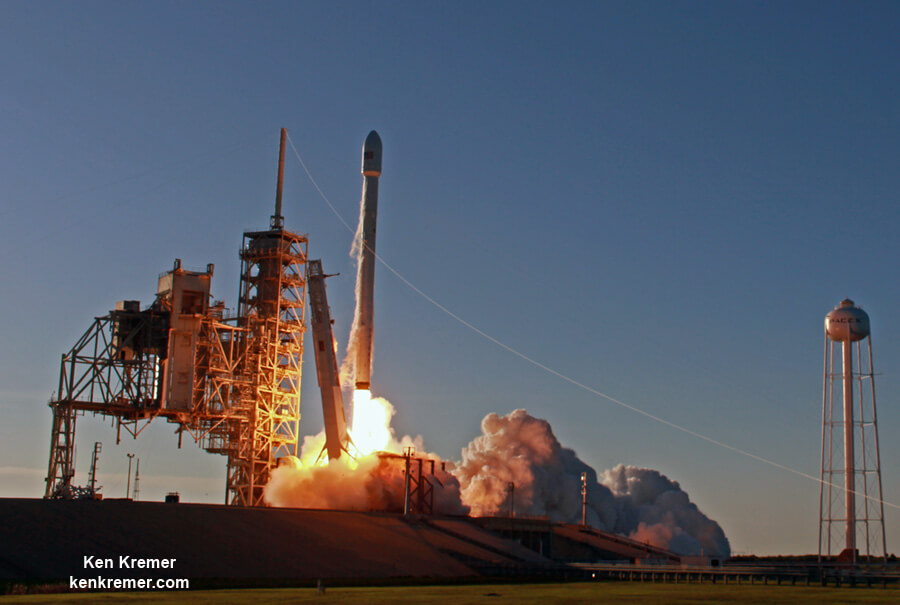
The Falcon Heavy is comprised of three Falcon 9 cores. The Delta IV Heavy is comprised of three Delta Common Core Boosters.
The combined trio of Falcon 9 cores will generate about 5.1 million pounds of liftoff thrust upon ignition from Launch Complex 39A at the Kennedy Space Center in Florida.
“With the ability to lift into orbit over 54 metric tons (119,000 lb)–a mass equivalent to a 737 jetliner loaded with passengers, crew, luggage and fuel–Falcon Heavy can lift more than twice the payload of the next closest operational vehicle, the Delta IV Heavy, at one-third the cost,” according to the SpaceX website.
“The nice thing is when you fully optimize it, it’s about two-and-a-half times the payload capability of a Falcon 9,” Musk notes. “It’s well over 100,000 pounds to LEO of payload capability, 50 tons. It can even get up a little higher than that if optimized.”
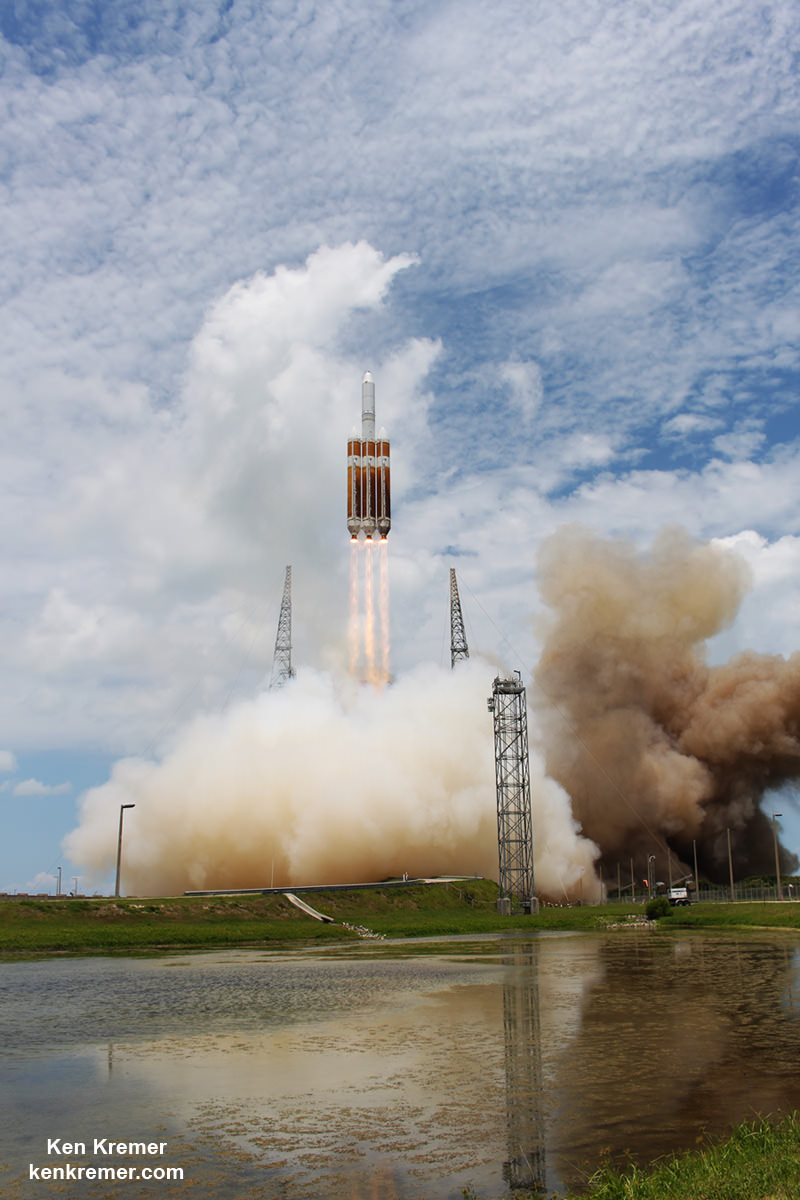
The two stage Falcon Heavy stands more than 229.6 feet (70 meters) tall and is 39.9 feet wide (12.2 meters).
It weighs more than 3.1 million pounds (1.4 million kilograms).
Like the Falcon 9 it will be fueled with liquid oxygen and RP-1 kerosene propellants.
The thunder, power and roar of over 5 million pounds of liftoff thrust from the Falcon Heavy’s 27 engines is absolutely certain to be a thrilling, earth-shaking space spectacular !! Thus placing it in a class of its own unlike any US launch since NASA’s Saturn V and Space Shuttles rocketed to the high frontier from the same pad.
“I encourage people to come down to the Cape to see the first Falcon Heavy mission,” Musk said. “It’s guaranteed to be exciting.”
But before the Falcon Heavy can actually be rolled up to launch position at pad 39A, SpaceX must first complete repairs and refurbishment to nearby pad 40.
That Cape pad was heavily damaged nearly a year ago during a catastrophic launch pad explosion that took place in Sept. 2016 during a routine prelaunch fueling and static fire engine test of a Falcon 9 rocket with the Amos-6 commercial comsat payload bolted on top.
Pad 40 must achieve operational launch status again before SpaceX can commit to the Falcon Heavy launches at Pad 39A. Workers will also need to finish construction work at pad 39A to support the Heavy launches.
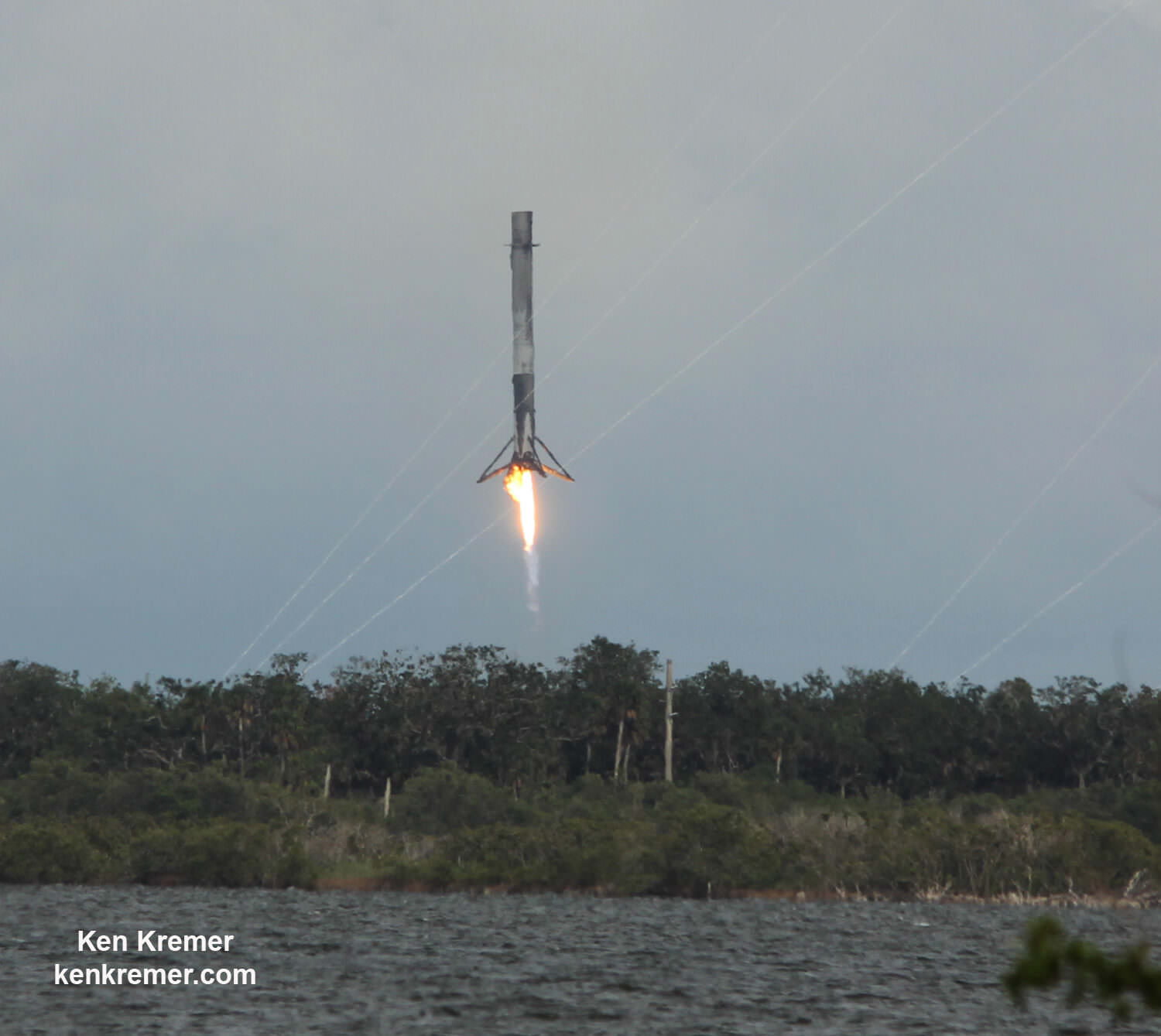
To date SpaceX has successfully demonstrated the recovery of thirteen boosters by land and sea.
Furthermore SpaceX engineers have advanced to the next step and successfully recycled, reflown and relaunched two ‘flight-proven first stages this year in March and June of 2017 from the Kennedy Space Center in Florida involving the SES-10 and BulgariaSat-1 launches respectively.
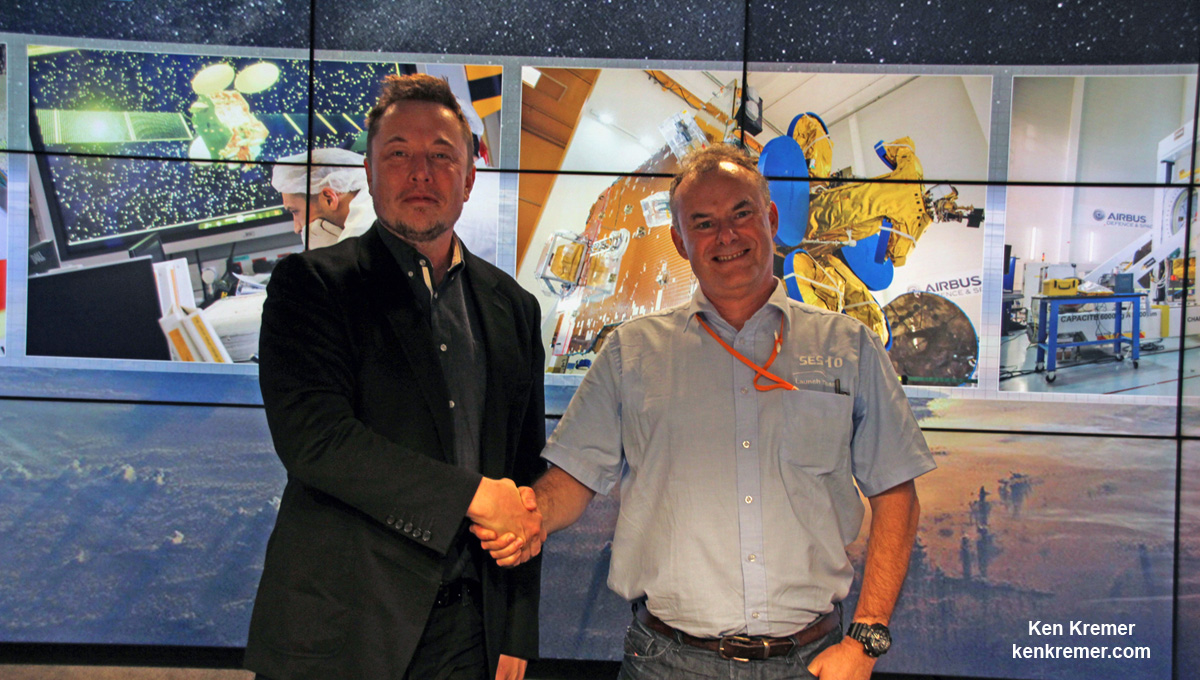
The next SpaceX Falcon 9 launch is slated for Aug. 13 on the NASA contracted CRS-12 resupply mission to the ISS.
Watch for Ken’s onsite space mission reports direct from the Kennedy Space Center and Cape Canaveral Air Force Station, Florida.
Stay tuned here for Ken’s continuing Earth and Planetary science and human spaceflight news.
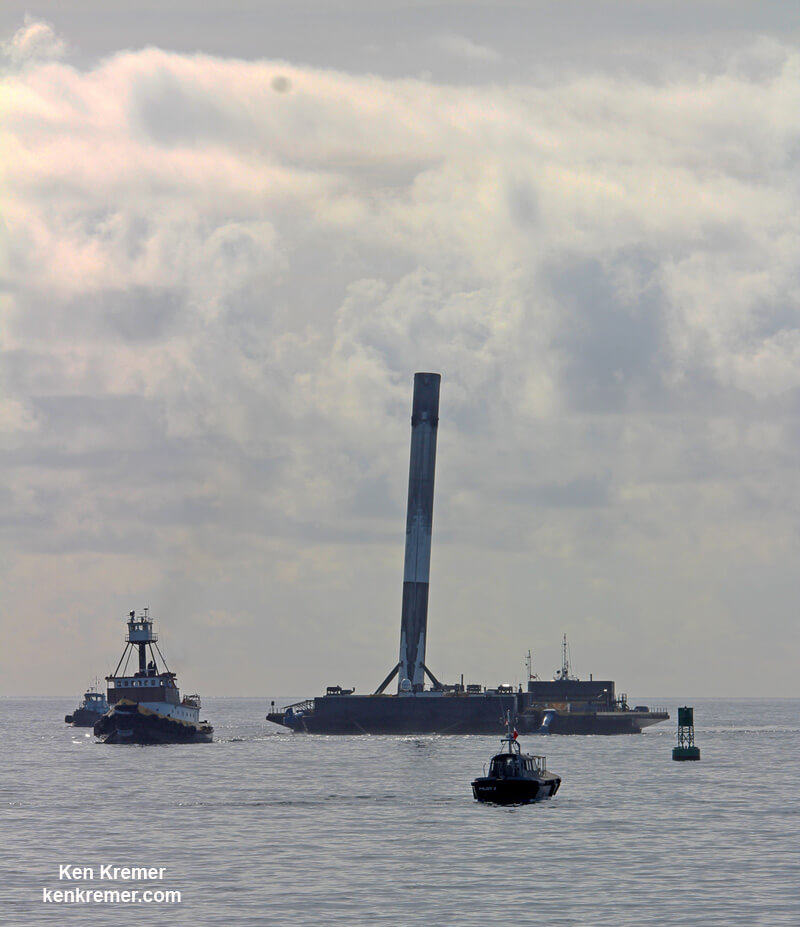
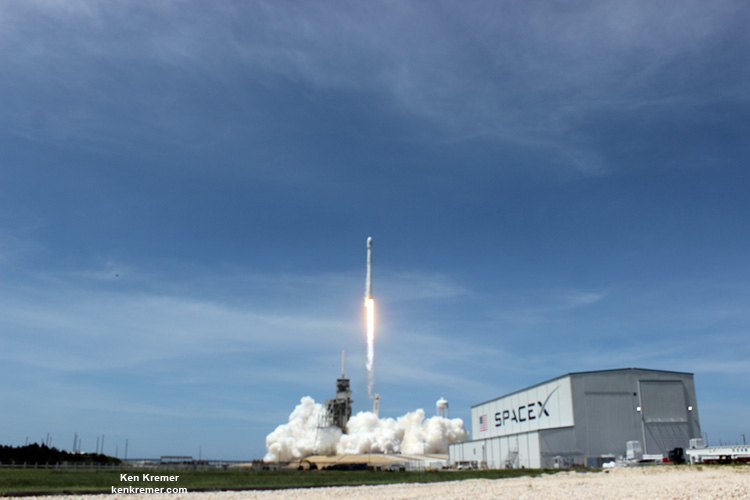
SpaceX Ramps Up; Reused SpaceX BulgariaSat-1 Booster Arrives in Port as Next Falcon 9 Test Fires for July 2 Intelsat Launch – Gallery
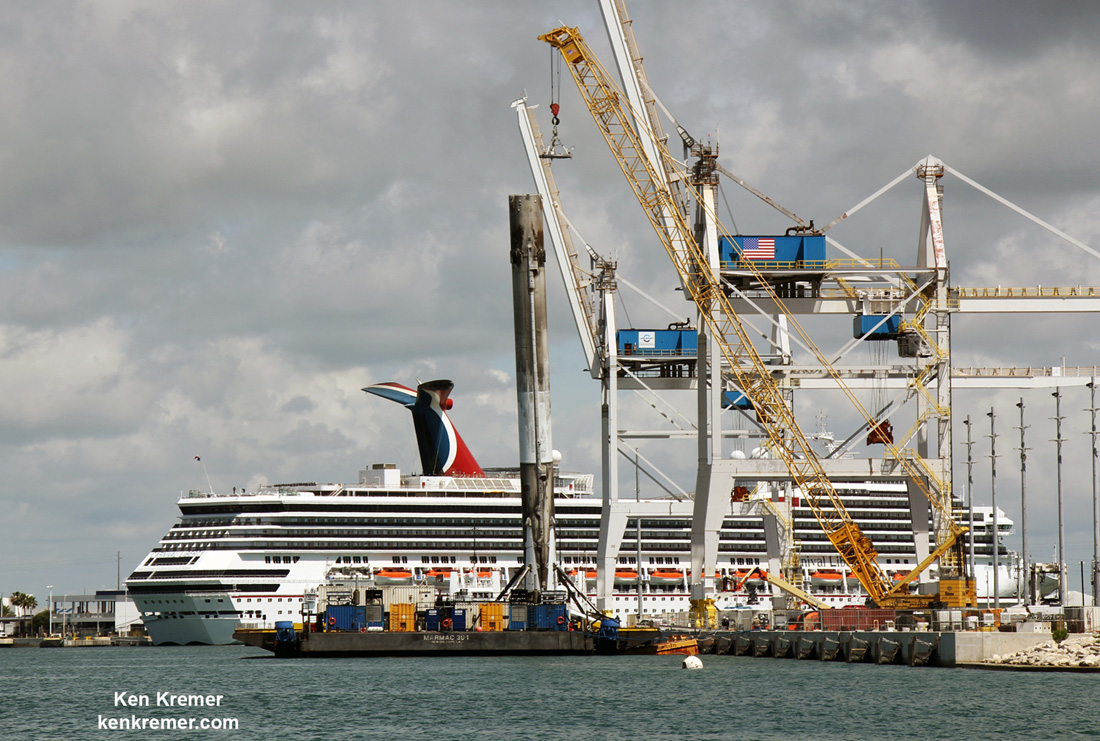

PORT CANAVERAL/KENNEDY SPACE CENTER, FL – The launch cadence at Elon Musk’s SpaceX is truly ramping up with Falcon 9 boosters rapidly coming and going in all directions from ground to space as the firm audaciously sets its sight on a third commercial payload orbital launch on July 2 in the span of just 9 days from its East and West Coast launch bases.
It was a magnificent sight to behold !! Seeing commercial passenger carrying cruise ships and commercial recycled rockets that will one day carry paying passenger to space, floating side by side in the busy channel of narrow Port Canaveral, basking in the suns glow from the sunshine state.
The doubly ‘flight-proven’ SpaceX Falcon 9 booster portends a promising future for spaceflight that Elon Musk hopes and plans will drastically slash the high cost of rocket launches and institute economic savings that would eventually lead to his dream of a ‘City on Mars!’ – sooner rather than later.
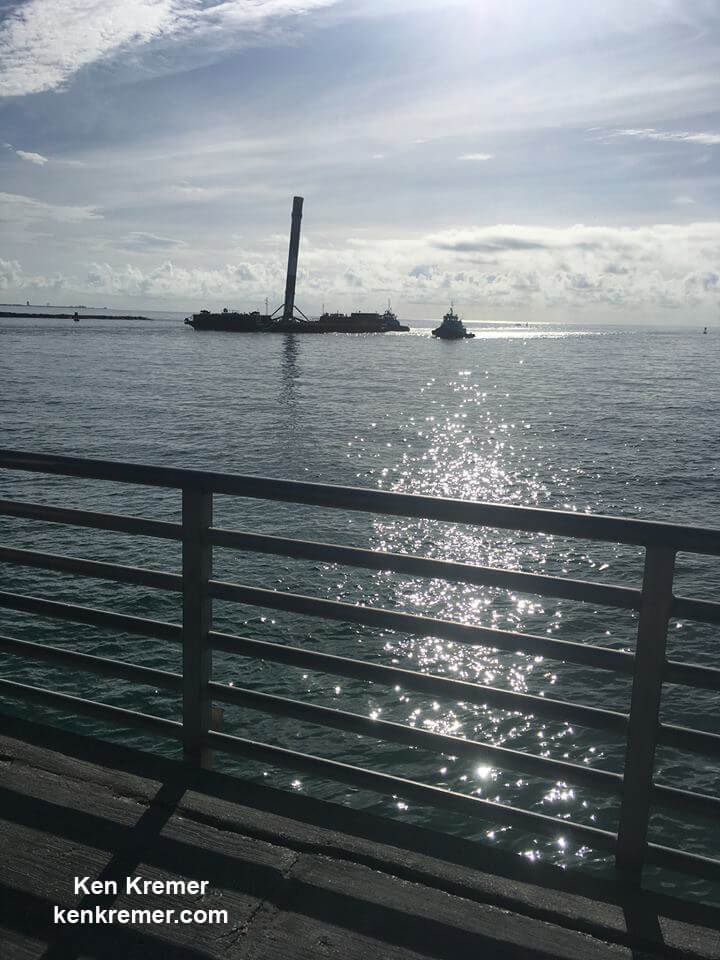
Thursday, June 29, serves as a perfect example of how SpaceX is rocking the space industry worldwide.
First, the reused first stage Falcon 9 booster from last Friday’s (June 23) SpaceX launch of the BulgariaSat-1 HD television broadcast satellite floated magnificently into Port Canaveral early Thursday morning atop the diminutive oceangoing droneship upon which it safely touched down upright on a quartet of landing legs some eight minutes after launch.

Second, SpaceX engineers then successfully conducted a late in the day static hot fire test of the Falcon 9 first stage engines and core that will power the next launch of the Intelsat 35e commercial comsat to orbit this Sunday, July 2.
So the day was just chock full of nonstop SpaceX rocketry action seeing a full day of rocket activities from dawn to dusk.
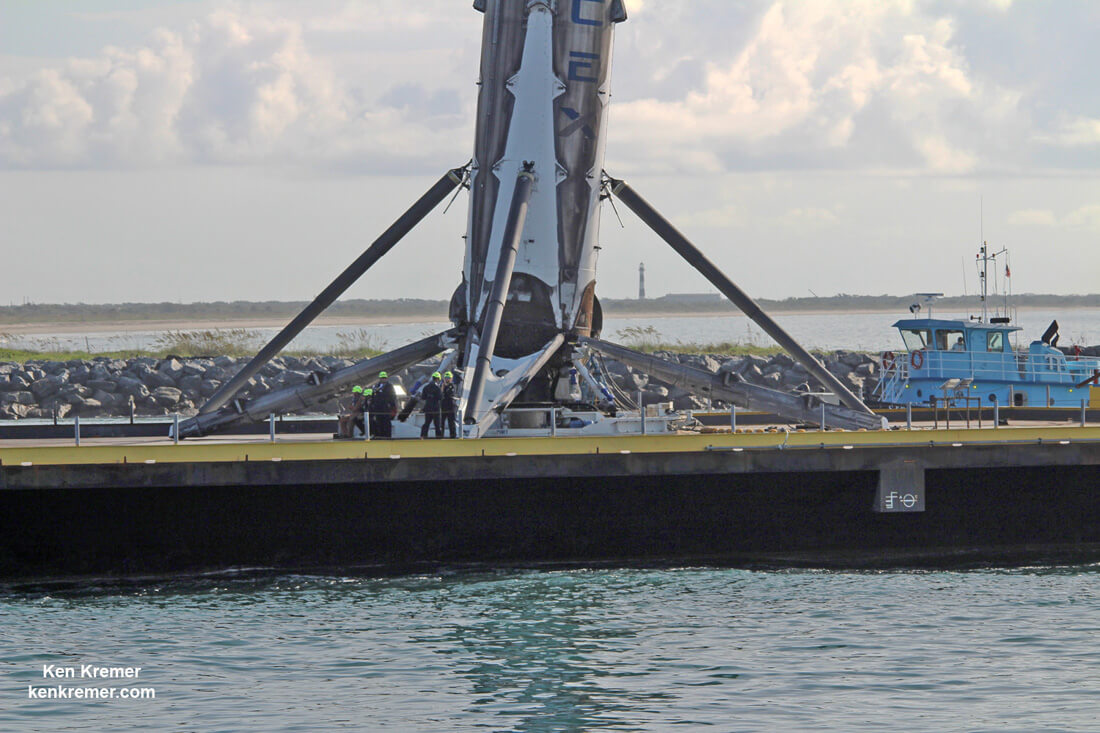
Thursday’s nonstop Space Coast action spanning from the north at the Kennedy Space Center and further south to Cape Canaveral Air Force Station and Port Canaveral was the culmination of space launch flow events that actually began days, weeks and months earlier.
The 156 foot- tall Falcon 9 booster had successfully landed on the tiny rectangular shaped “Of Course I Still Love You” or OCISLY droneship less than nine minutes after liftoff on Friday, June 23 on the BulgariaSat-1 flight.
That mission began with the picture perfect liftoff of the BulgariaSat-1 communications satellite for East European commercial broadband provider BulgariaSat at 3:10 p.m. EDT, or 19:10 UTC, June 23, with ignition of all nine of the ‘flight-proven’ Falcon 9 first stage engines on SpaceX’s seaside Launch Complex 39A at NASA’s Kennedy Space Center in Florida.
BulgariaSat is an affiliate of Bulsatcom, Bulgaria’s largest digital television provider.
The 15 story tall first stage touched down with a slight tilt of roughly eight degrees as a direct result of the extremely demanding landing regime.
Then after spending several post landing and launch days at sea due to stormy weather along the Florida Space Coast and to accommodate local shipping traffic and SpaceX planning needs, the booster at last neared shore from the south off the coast of Melbourne, FL.
Accompanied by a small armada of support vessels it was slowly towed to port by the Elsbeth III.
The SpaceX flotilla arrived at last at the mouth of Port Canaveral and Jetty Park Pier jutting into the Atlantic Ocean at about 830 a.m. EDT – offering a spectacular view at to a flock of space enthusiasts and photographers including this author.
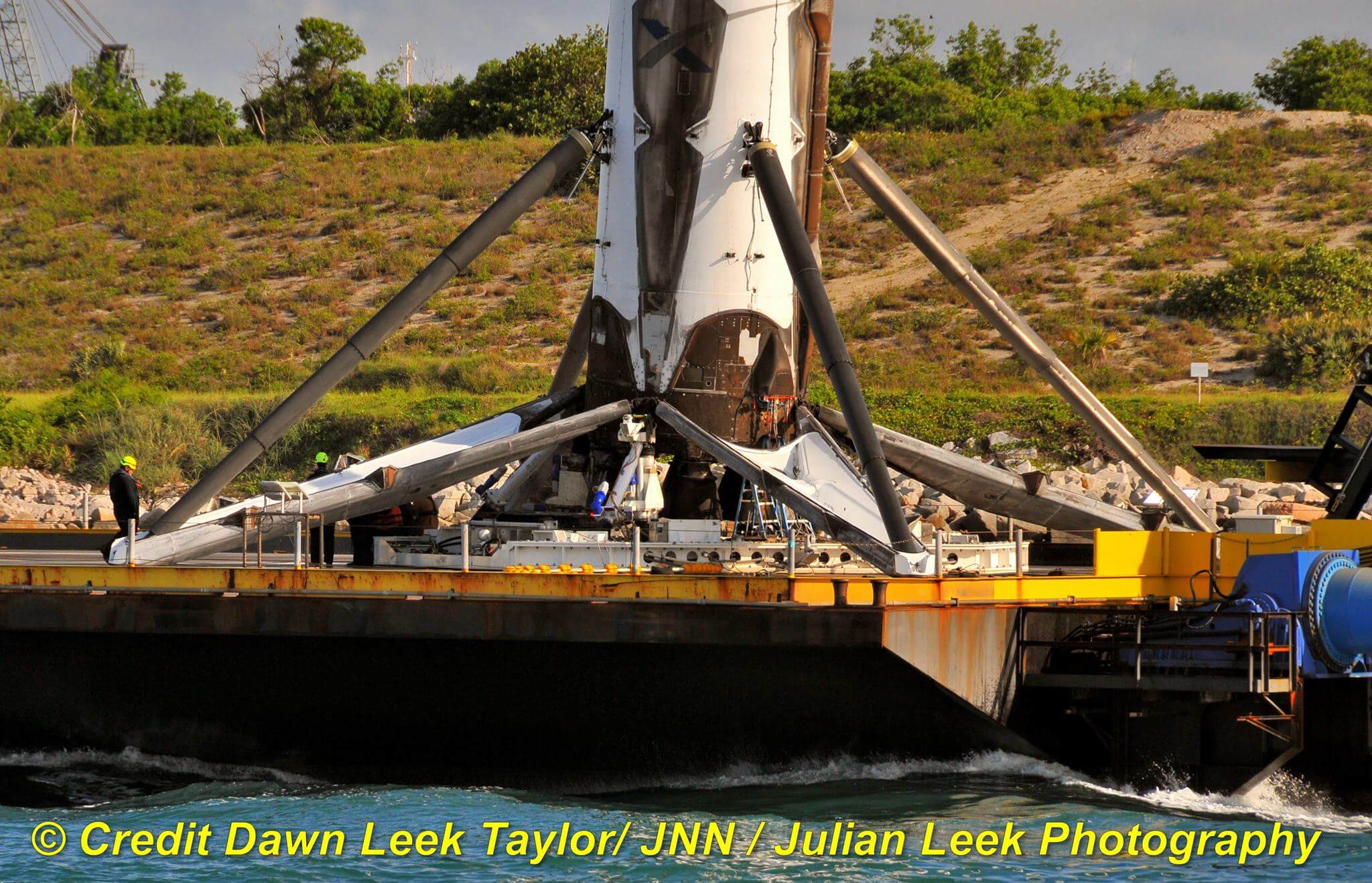
I highly recommend you try and see a droneship arrival if all possible.
The leaning boosters – of which this is only the second – are even more dramatic!
Because the Falcon 9 barely survived the highest ever reentry force and landing heat to date, Musk reported.
The rectangularly shaped OCISLY droneship is tiny – barely the size of a moderately sized apartment complex parking lot.
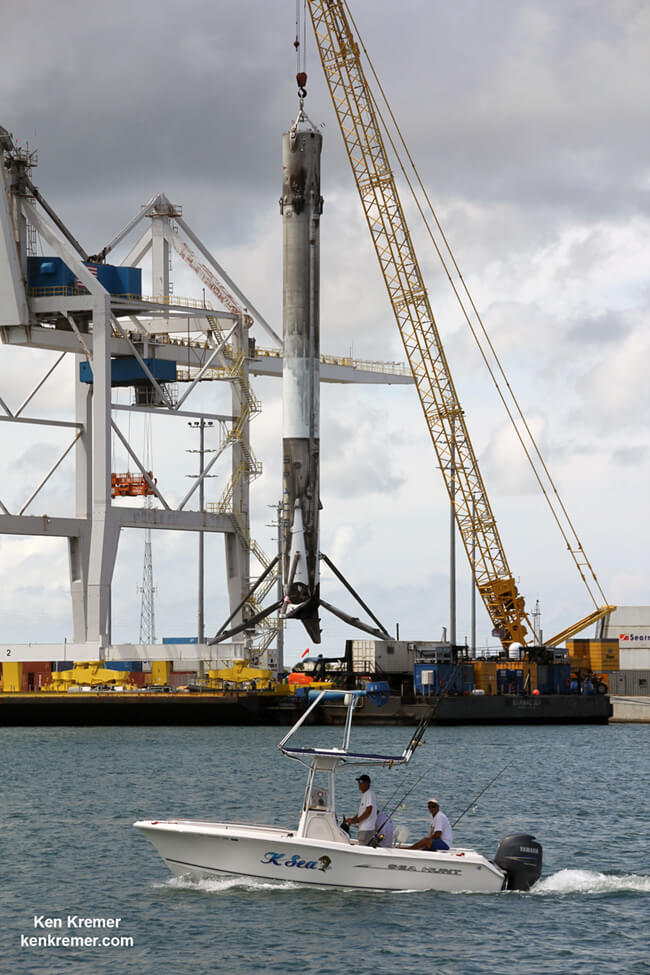
Falcon 9’s first stage for the BulgariaSat-1 mission previously supported the Iridium-1 mission from Vandenberg Air Force Base in January of this year.
Some two minutes and 40 seconds after liftoff the first and second stages separated.
As the second stage continued to orbit, the recycled first stage began the daunting trip back to Earth on a very high energy trajectory that tested the limits of the boosters landing capability.
“Falcon 9 will experience its highest ever reentry force and heat in today’s launch. Good chance rocket booster doesn’t make it back,” SpaceX founder and CEO Elon Musk wrote in a prelaunch tweet.
Following stage separation, Falcon 9’s first stage carried out two burns, the entry burn and the landing burn using a trio of the Merlin 1D engines.
Ultimately the 15 story tall booster successfully landed on the “Of Course I Still Love You” or OCISLY droneship, stationed in the Atlantic Ocean about 400 miles (600 km) offshore and east of Cape Canaveral.
“Rocket is extra toasty and hit the deck hard (used almost all of the emergency crush core), but otherwise good,” Musk tweeted shortly after the recycled booster successfully launched and landed for its second time.
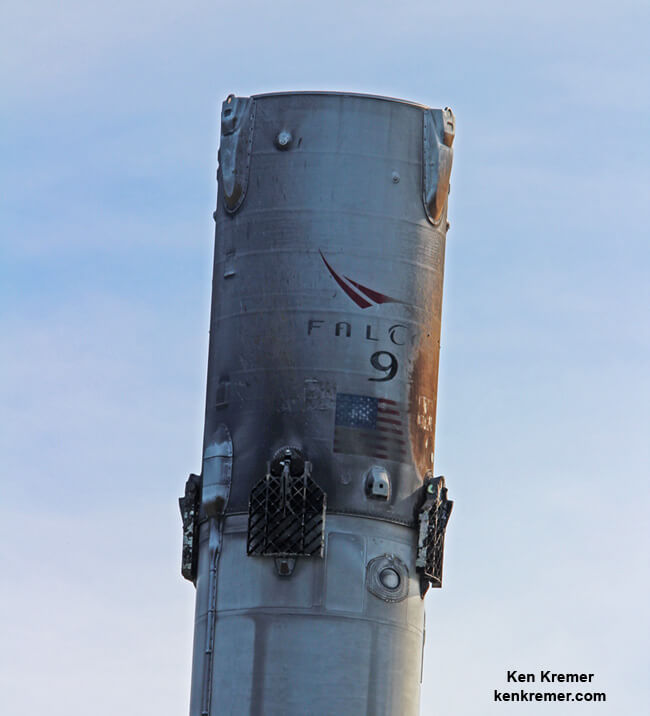
BulgariaSat-1 and Iridium-2 counted as the eighth and ninth SpaceX launches of 2017.
Including those two ocean platform landings, SpaceX has now successfully recovered 13 boosters; 5 by land and 8 by sea, over the past 18 months.
Both landing droneships are now back into their respective coastal ports.
It’s a feat straight out of science fiction but aimed at drastically slashing the cost of access to space as envisioned by Musk.
Watch my BulgariaSat-1 launch video from KSC pad 39A
Video Caption: Launch of SpaceX Falcon 9 on June 23, 2017 from pad 39A at the Kennedy Space Center carrying BulgariaSat-1 TV broadband satellite to geosynchronous orbit for BulgariaSat, which is Bulgaria’s 1st GeoComSat – as seen in this remote video taken at the pad. Credit: Ken Kremer/kenkremer.com
Watch for Ken’s onsite BulgariaSat-1 mission reports direct from the Kennedy Space Center and Cape Canaveral Air Force Station, Florida.
Stay tuned here for Ken’s continuing Earth and Planetary science and human spaceflight news.
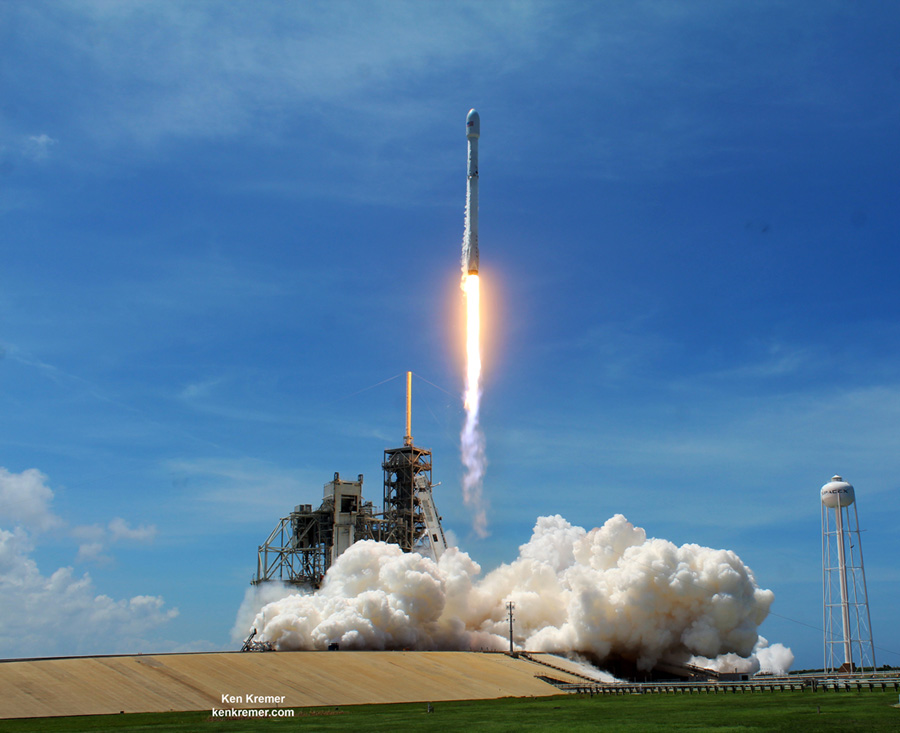
SpaceX Accomplishes Double Headed American Space Spectacular – 2 Launches and 2 Landings in 2 Days from 2 Coasts: Gallery
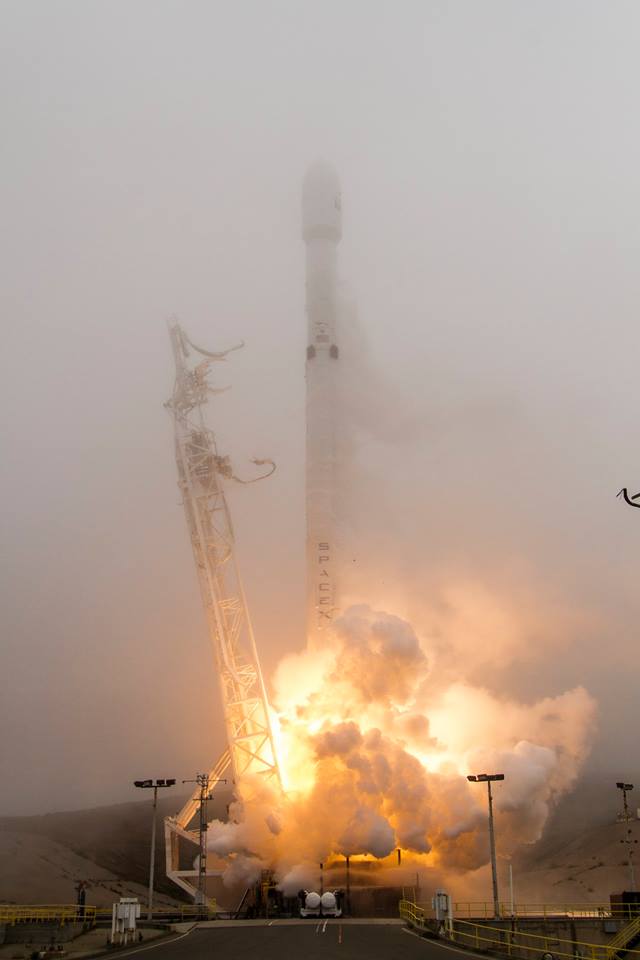

KENNEDY SPACE CENTER, FL – With Sunday’s successful Falcon 9 blastoff for Iridium Communications joining rocketry’s history books, Elon Musk’s SpaceX accomplished a double headed American space spectacular this weekend with 2 launches and 2 booster landings in 2 days from 2 coasts for 2 commercial customers – in a remarkably rapid turnaround feat that set a new record for minimum time between launches for SpaceX.
On Sunday, June 25 at 1:25 p.m. PDT (4:25 p.m. EDT; 2025 UTC) a SpaceX Falcon 9 rocket successfully launched a second set of ten Iridium Next mobile voice and data relay communications satellites to low Earth orbit on the Iridium-2 mission from SLC-4E on Vandenberg Air Force Base in California.
“All sats healthy and talking,” tweeted Matt Desch, Iridium Communications CEO, soon after launch and confirmation that all 10 Iridium NEXT satellites were successfully deployed from their second stage satellite dispensers. Iridium is a global leader in mobile voice and data satellite communications.
“It was a great day!”
The US West Coast Falcon 9 liftoff of the Iridium-2 mission from California on Sunday, June 25 took place barely 48 hours after the US East Coast Falcon 9 liftoff of the BulgariaSat-1 mission from Florida on Friday, June 23.
Without a doubt, Musk’s dream of rocket reusability as a here and now means to slash the high costs of launching to space and thereby broaden access to space for more players is rapidly taking shape.
Following separation of the first and second stages, the Falcon 9’s 15 story tall first stage successfully landed on the “Just Read the Instructions” droneship ocean going platform stationed several hundred miles out in the Pacific Ocean off the coast of California, despite challenging weather conditions.
Indeed the droneships position was changed in the final minutes before launch due to the poor weather.
“Droneship repositioned due to extreme weather. Will be tight,” tweeted Musk minutes before liftoff.
The 156 foot tall booster touched down about 8 and ½ minutes after liftoff from Vandenberg AFB.
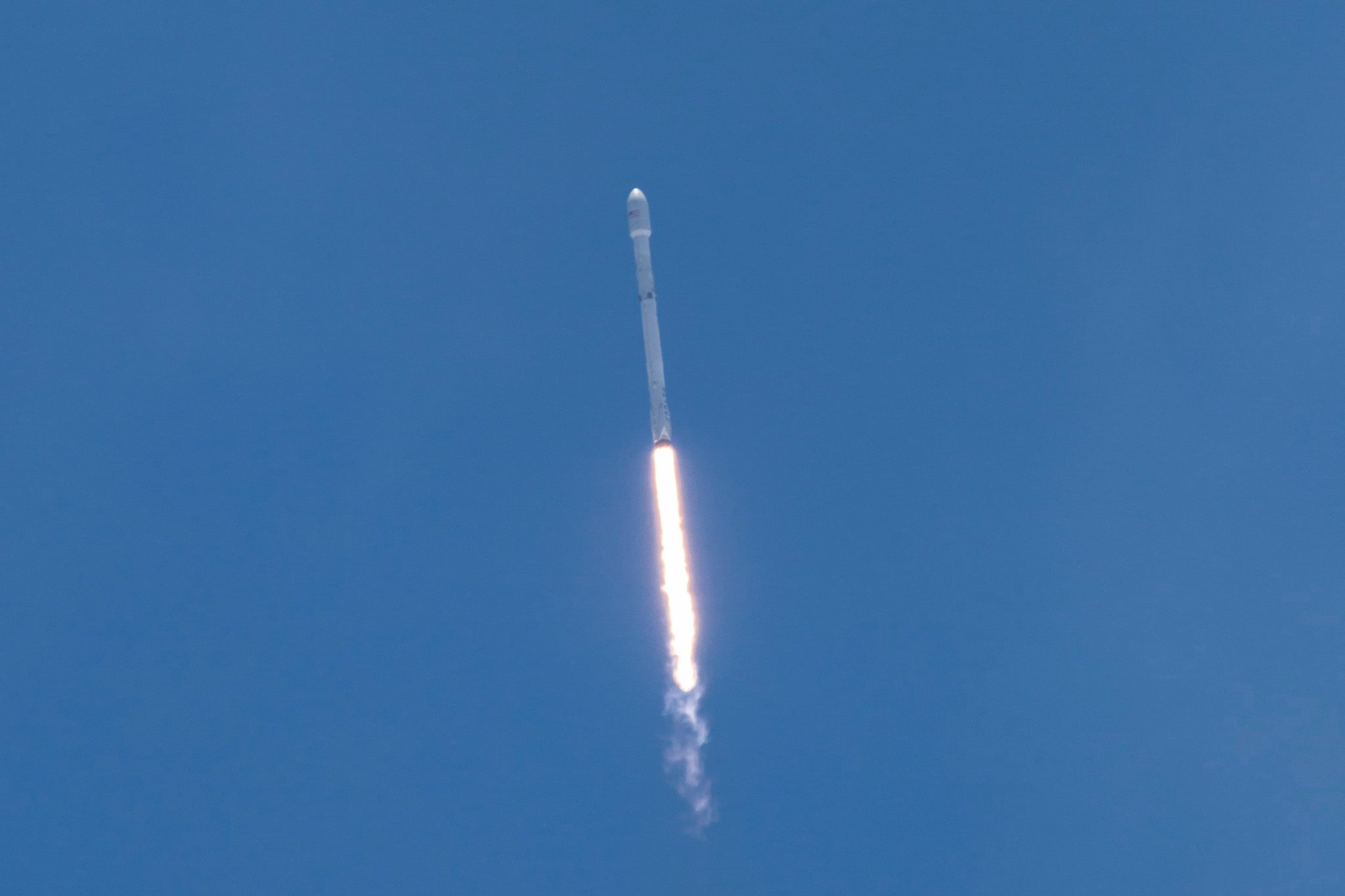
The launch, landing and deployment of the 10 Iridium Next satellites was all broadcast live on a SpaceX webcast.
The perfectly executed Iridium-2 and BulgariaSat-1 launch and landing duo clearly demonstrates the daunting capability of SpaceX’s privately owned and operated engineering team to pull off such a remarkable feat in nimble fashion.
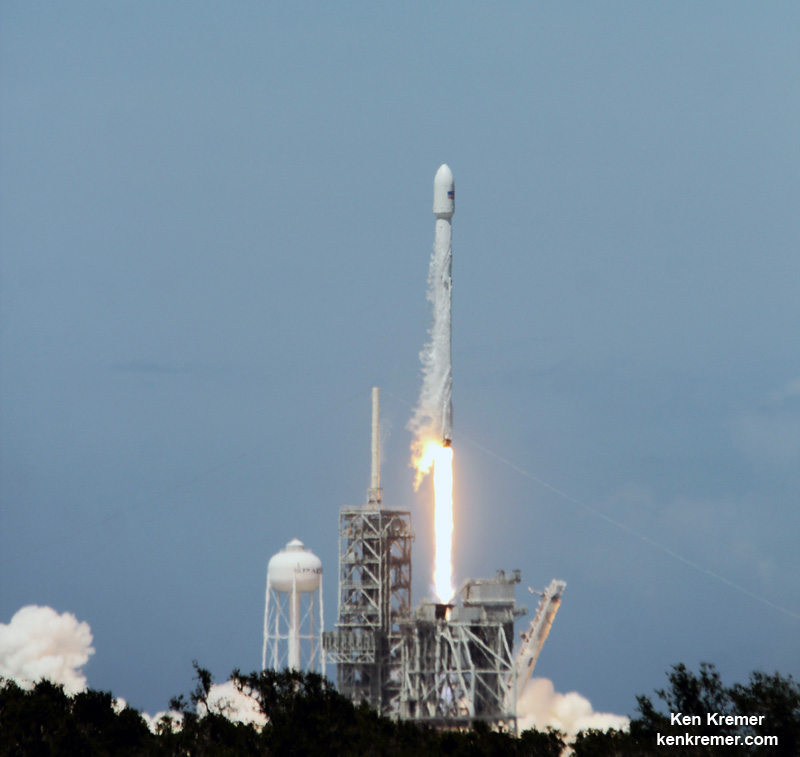
The stage was set for the unprecedented Falcon 9 launch doubleheader just a week ago when SpaceX CEO and billionaire founder Elon Musk tweeted out the daring space goal after all went well with the Florida Space Coast’s static hotfire test for the first in line BulgariaSat-1 flight.

Check out the expanding gallery of Bulgariasat-1 eyepopping photos and videos from several space journalist colleagues and friends and myself.
Click back as the gallery grows !

Sunday’s Iridium 2 flight was Iridium Communications second contracted launch with SpaceX.
“This payload of 10 satellites was deployed into low-Earth orbit, approximately one hour after a SpaceX Falcon 9 rocket lifted off from Vandenberg,” Iridium said in a statement.
The Mini Cooper sized Iridium NEXT satellites each weigh 1,900 pounds, totaling approximately 19,000 pounds placed into space. That is the weight of a semi tractor trailer truck!
The inaugural Iridium 1 launch with the first ten Iridium Next satellites took place successfully at the start of this year on Jan. 14, 2017.
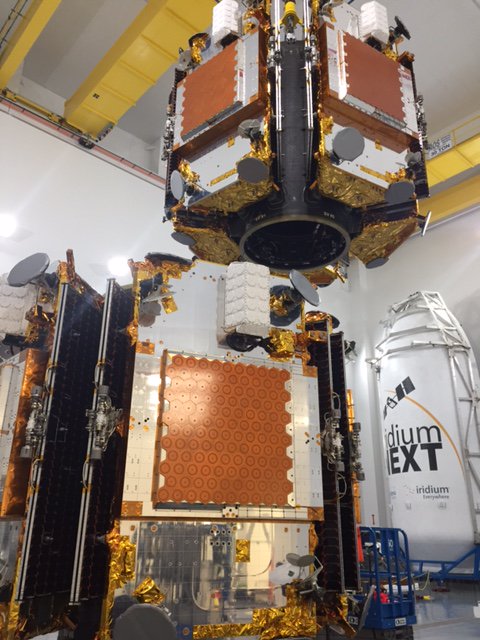
The new set of ten Iridium Next mobile relay satellites were delivered into a circular orbit at an altitude of 625 kilometers (388 miles) above Earth.
They were released one at a time from a pair of specially designed satellite dispensers at approximately 100 second intervals.
“Since the successful January 14, 2017 launch, Iridium NEXT satellites have already been integrated into the operational constellation and are providing service. The first eight operational Iridium NEXT satellites are already providing superior call quality and faster data speeds with increased capacity to Iridium customers. The two additional satellites from the first launch are continuing to drift to their operational orbital plane, where upon arrival they will begin providing service.”
Iridium 2 is the second of eight planned Falcon 9 launches to establish the Iridium NEXT constellation which will eventually consist of 81 advanced satellites.
At least 75 will be launched by SpaceX to low-Earth orbit, with 66 making up the operational constellation.
The inaugural launch of the advanced Iridium NEXT satellites in January 2017 started the process of replacing an aging Iridium fleet in orbit for nearly two decades.
Nine of the 81 will serve as on-orbit spares and six as ground spares.
“Now, and for approximately the next 45 days, these newly launched satellites will undergo a series of testing and validation procedures, ensuring they are ready for integration with the operational constellation,” said Iridium.
“We are thrilled with yesterday’s success. These new satellites are functioning well, and we are pressing forward with the testing process,” said Scott Smith, chief operating officer at Iridium.
“Since the last launch, the team at our Satellite Network Operations Center (SNOC) has been anxiously awaiting this new batch of satellites. There is a lot of work to do, and we are up for the challenge.”
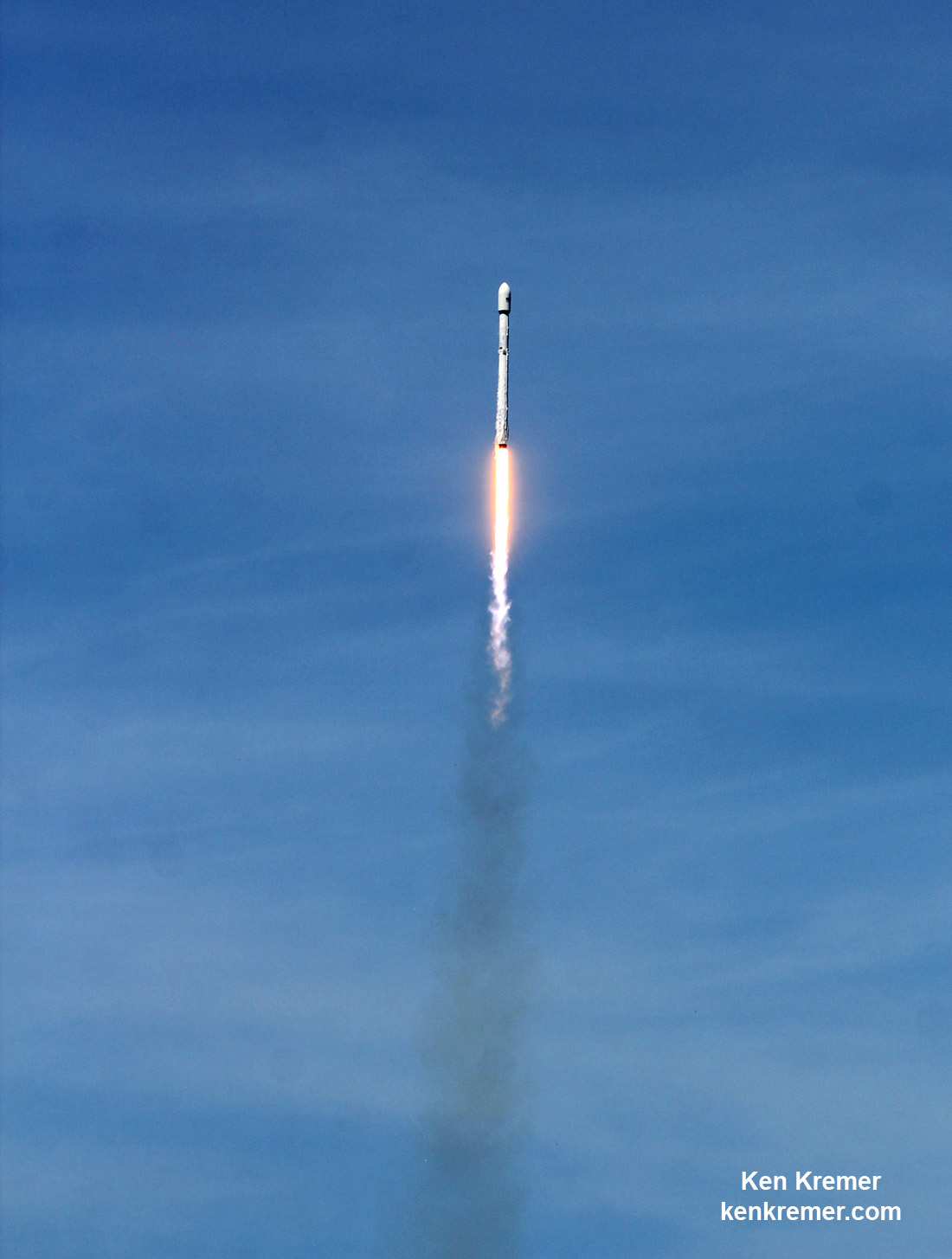
BulgariaSat-1 and Iridium-2 count as the eighth and ninth SpaceX launches of 2017.
Including these two ocean platform landings, SpaceX has now successfully recovered 13 boosters; 5 by land and 8 by sea, over the past 18 months.
Both landing droneships are now headed back into their respective coastal ports.
It’s a feat straight out of science fiction but aimed at drastically slashing the cost of access to space as envisioned by Musk.
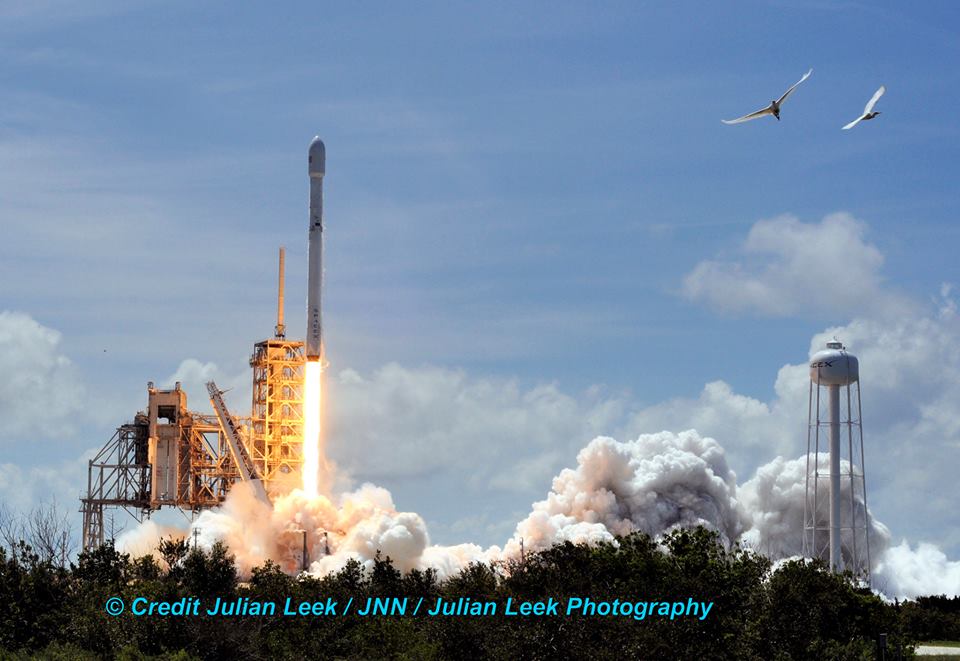
Watch this BulgariaSat-1 launch video from KSC pad 39A
Video Caption: Launch of SpaceX Falcon 9 on June 23, 2017 from pad 39A at the Kennedy Space Center carrying BulgariaSat-1 TV broadband satellite to geosynchronous orbit for BulgariaSat, which is Bulgaria’s 1st GeoComSat – as seen in this remote video taken at the pad. Credit: Ken Kremer/kenkremer.com
Watch for Ken’s onsite mission reports direct from the Kennedy Space Center and Cape Canaveral Air Force Station, Florida.
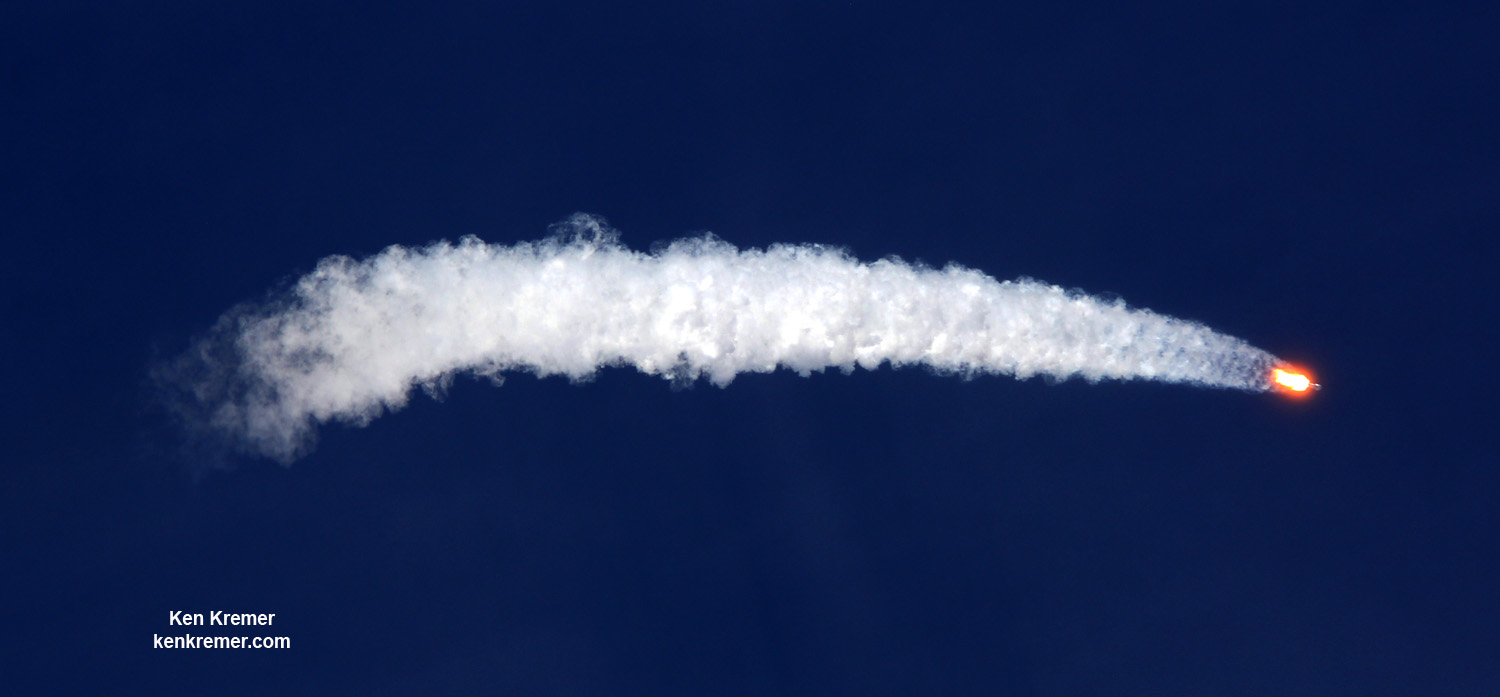

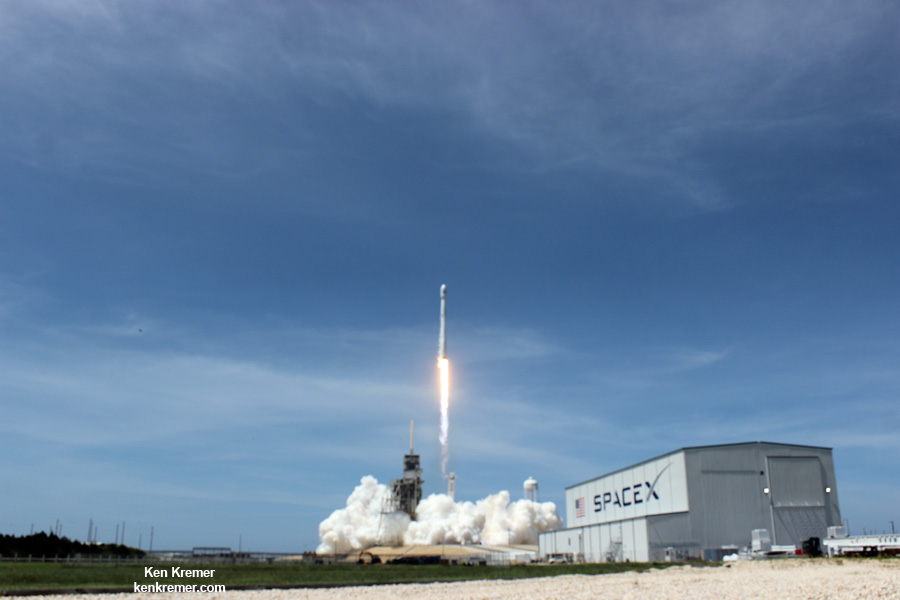
Stay tuned here for Ken’s continuing Earth and Planetary science and human spaceflight news.
Ken Kremer
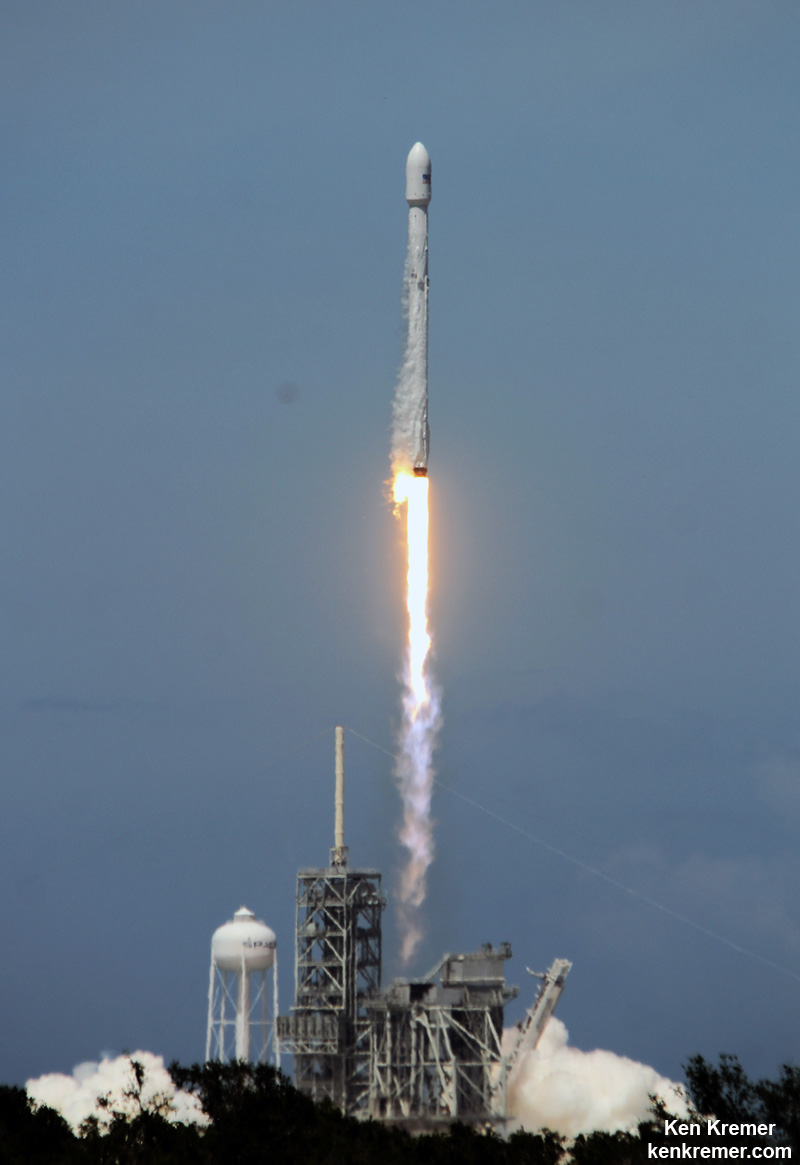
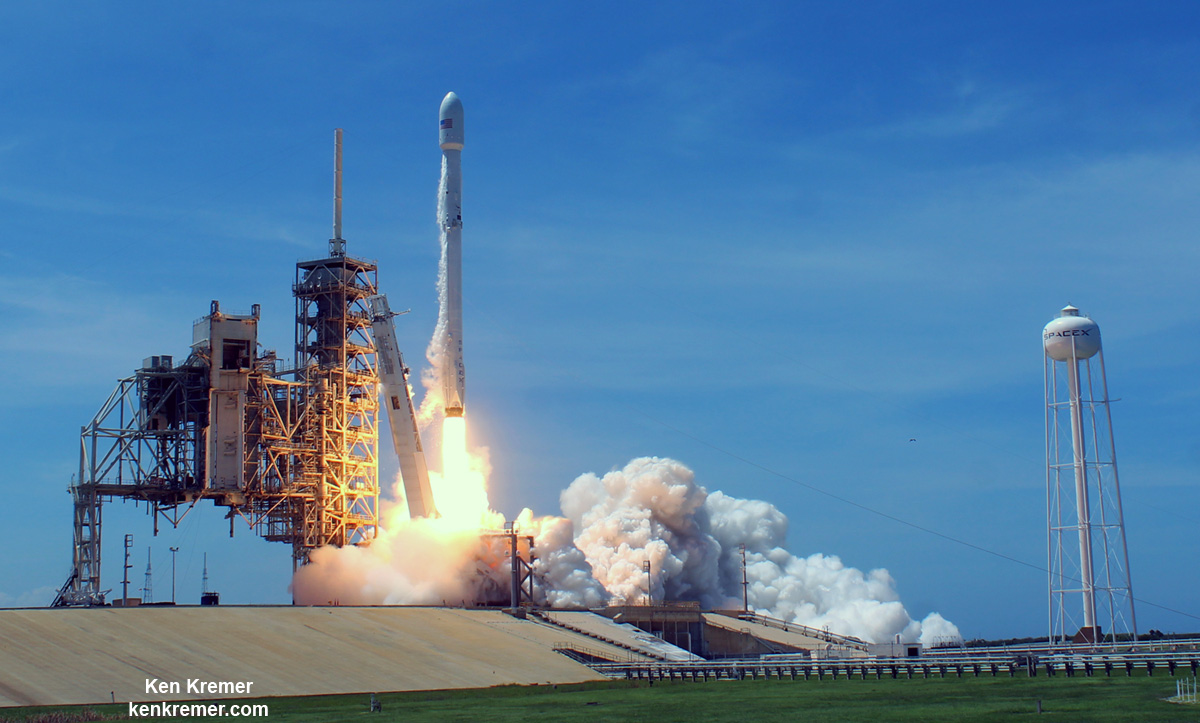
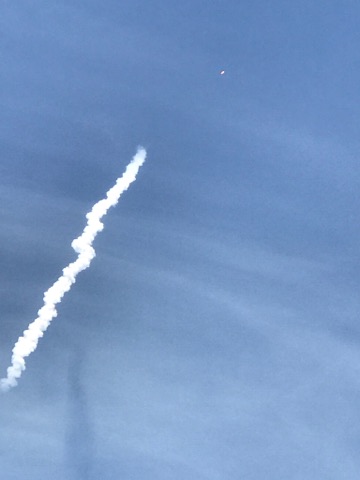
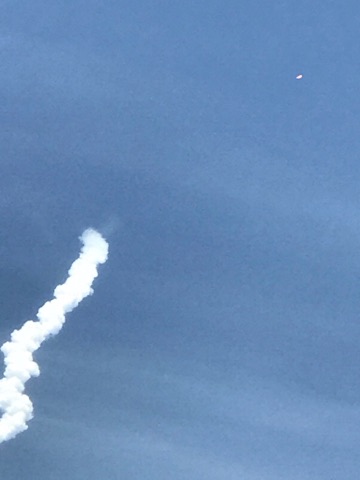
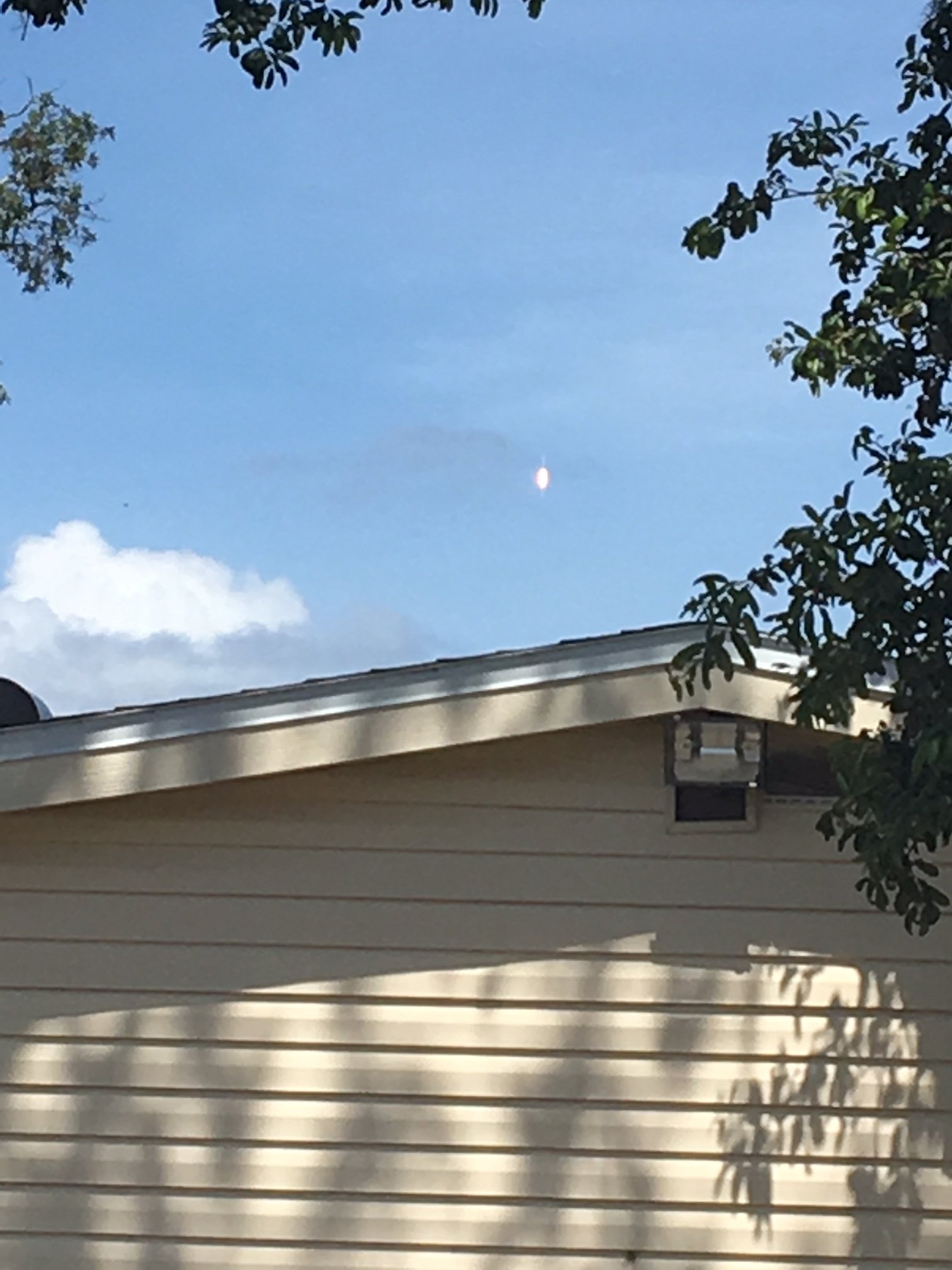

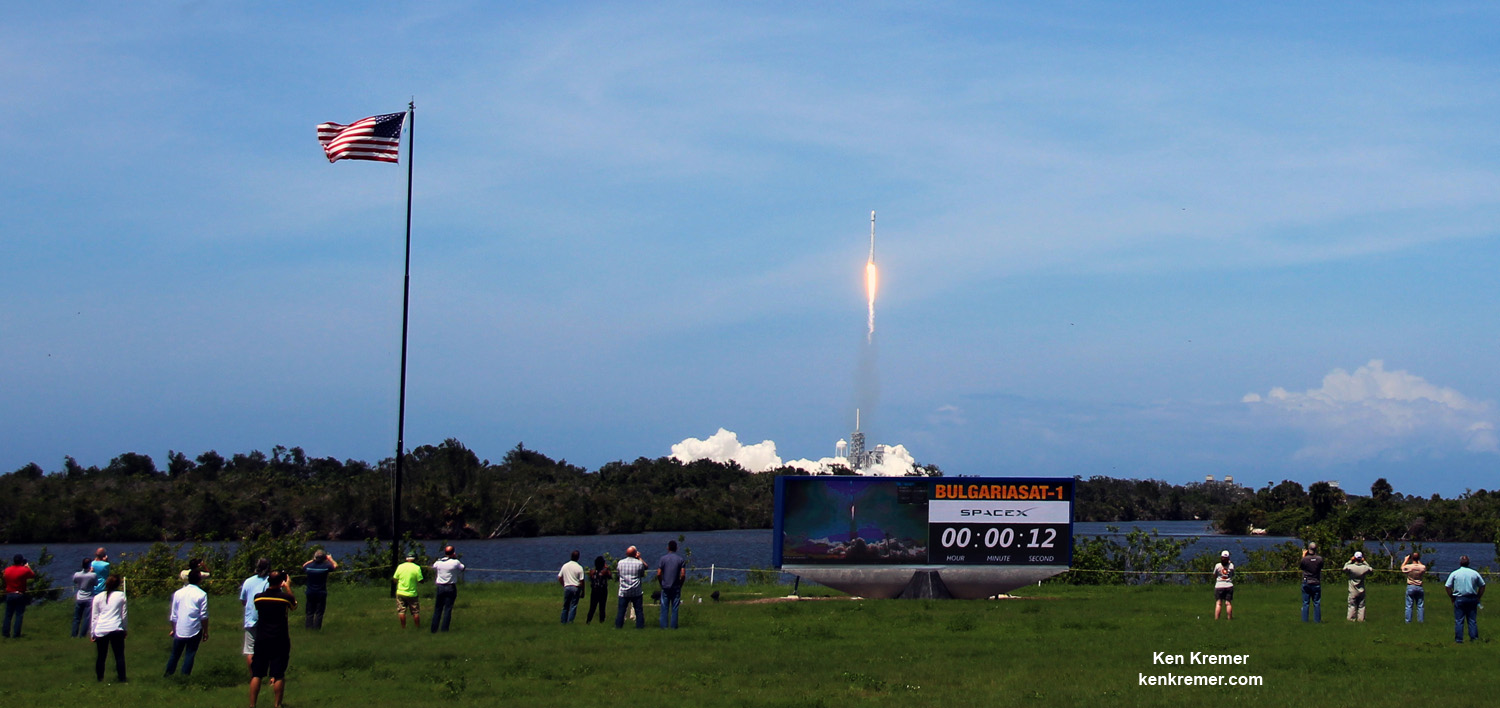
BulgariaSat-1 Blazes to Orbit on Used SpaceX Falcon 9 Rocket as Breakthrough Booster Lands 2nd Time on Oceanic Platform


KENNEDY SPACE CENTER, FL – In another breakthrough milestone aimed at slashing the high cost of rocketry, the innovators at billionaire entrepreneur Elon Musk’s SpaceX successfully launched a ‘used’ rocket for only the second time in history – that blazed a path to orbit with its BulgariaSat-1 commercial television comsat payload Friday afternoon, June 23, from the Kennedy Space Center and just minutes later landed upright and intact on an oceanic platform waiting offshore in the vast currents of the Atlantic ocean.
“This is really a great day for us,” Maxim Zayakov, CEO of BulgariaSat and Bulsatcom told Universe Today during pre and post launch interview’s onsite at NASA’s Kennedy Space Center in Florida.
“Everything is seeming to be a good success so far.”
To top that, SpaceX is targeting a bicoastal weekend doubleheader of launches signaling a remarkably rapid turnaround capability. Another Falcon 9 is scheduled for blastoff on Sunday, June 25 at 1:25 p.m. PDT (4:25 p.m. EDT; 2025 UTC) from Vandenberg Air Force Base in California on the Iridium-2 mission, less than 48 hours apart – which would set a new launch turnaround record for SpaceX.
The picture perfect liftoff of the BulgariaSat-1 communications satellite for East European commercial broadband provider BulgariaSat began at 3:10 p.m. EDT, or 19:10 UTC, June 23, with ignition of all nine of the ‘flight-proven’ Falcon 9 first stage engines on SpaceX’s seaside Launch Complex 39A at NASA’s Kennedy Space Center in Florida.

BulgariaSat is an affiliate of Bulsatcom, Bulgaria’s largest digital television provider.
“Everything went down just as we expected,” BulgariaSat CEO Zayakov told me. “Of course there was a lot of excitement. And there are a lot of excited and scared feelings [with launches].”
“At the end of the day it not only worked out just as expected with the launch but the satellite also already reported in telemetry that she is doing fine,” Zayakov elaborated.
BulgariaSat-1 is the first geostationary communications satellite orbited for the nation of Bulgaria.
“We will start using it as soon as we can, in about one and a half months.”

The used 229-foot-tall (70-meter) SpaceX Falcon 9 carrying BulgariaSat-1 soared off historic pad 39A into brilliant mid-afternoon blue skies drenching the Florida Space Coast with beloved sunshine to the delight of hordes of spectators gathered from across the globe – including a Bulgarian TV crew witnessing their first launch.
History’s first ‘flight-proven’ Falcon 9 booster was successfully launched by SpaceX this past March for Luxembourg based telecommunications giant SES on the SES-10 mission – likewise from pad 39A.
Some 35 minutes after blastoff, BulgariaSat-1 was successfully separated as planned from the Falcon 9 second stage and deployed to its targeted initial geostationary transfer orbit (GTO).
“So now she is on her way to the orbital position. The solar arrays deployed about 30 minutes after spacecraft separation from the second stage.”

Would you launch with Space X again?
“Yes looking to the future we would be happy to use SpaceX again in the future, certainly why not. SpaceX is definitely up there,” Zayakov replied.
BulgariaSat-1 will be located at the Bulgarian orbital position at 1.9 degrees East longitude and will provide reliable satellite communications solutions to broadcast, telecom, corporate and government customers.
How many customers will be served? I asked Zayakov.
“BulgariaSat-1 will serve about 800,000 customers in Bulgaria and about another million subscribers elsewhere in eastern Europe and the Balkans,” Zayakov elaborated.
The BulgariaSat-1 geostationary comsat will provide direct-to-home television (DTH) and data communications services to Southeastern Europe, including Serbia, the Balkans and other European regions.
You could not have asked for better weather as the recycled Falcon 9 roared to life for the second time with a paying customer and put on a long and exciting space spectacle for those lucky and fortunate enough to witness history with their own eyeballs first hand and follow along for several minutes as the rocket accelerated magnificently to orbit and arched over to the African continent in the nearly cloudless sky.
Falcon 9’s first stage for the BulgariaSat-1 mission previously supported the Iridium-1 mission from Vandenberg Air Force Base in January of this year.
Some two minutes and 40 seconds after liftoff the first and second stages separated.
As the second stage continued to orbit, the recycled first stage began the daunting trip back to Earth on a very high energy trajectory that tested the limits of the boosters landing capability.
“Falcon 9 will experience its highest ever reentry force and heat in today’s launch. Good chance rocket booster doesn’t make it back,” SpaceX founder and CEO Elon Musk wrote in a prelaunch tweet.
Following stage separation, Falcon 9’s first stage carried out two burns, the entry burn and the landing burn using a trio of the Merlin 1D engines.
Ultimately the 15 story tall booster successfully landed on the “Of Course I Still Love You” or OCISLY droneship, stationed in the Atlantic Ocean about 400 miles (600 km) offshore and east of Cape Canaveral.
“Rocket is extra toasty and hit the deck hard (used almost all of the emergency crush core), but otherwise good,” Musk tweeted shortly after the recycled booster successfully launched and landed for its second time.
The 156 foot tall first stage may have touched down with a slight tilt.
The OCISLY droneship is expected back into Port Canaveral in a few days.
The 8,100 pounds (3,700 kilograms) BulgariaSat-1 satellite was built by SSL in Palo Alto, Calif. It has a design lifetime for a 15-year mission.
BulgariaSat-1 is equipped with 2 Ku-band FSS transponders and 30 Ku-band BSS transponders for fixed satellite services and advanced television services such as high definition television.
With BulgariaSat-1 now safely in orbit, a period of critical testing and checkout is on tap next.
“It takes about ten days to arrive and stabilize at the final orbital slot,” Zayakov stated. “Then after those 10 days it takes about another 20 to 30 days to actually do all the orbital checkouts and orbital tests required to make sure that the satellite is performing fine and that we can start using it for broadcasts.”
“So in about one and a half months we will be ready to start using BulgariaSat-1.”
“We will start using it as soon as we can!”
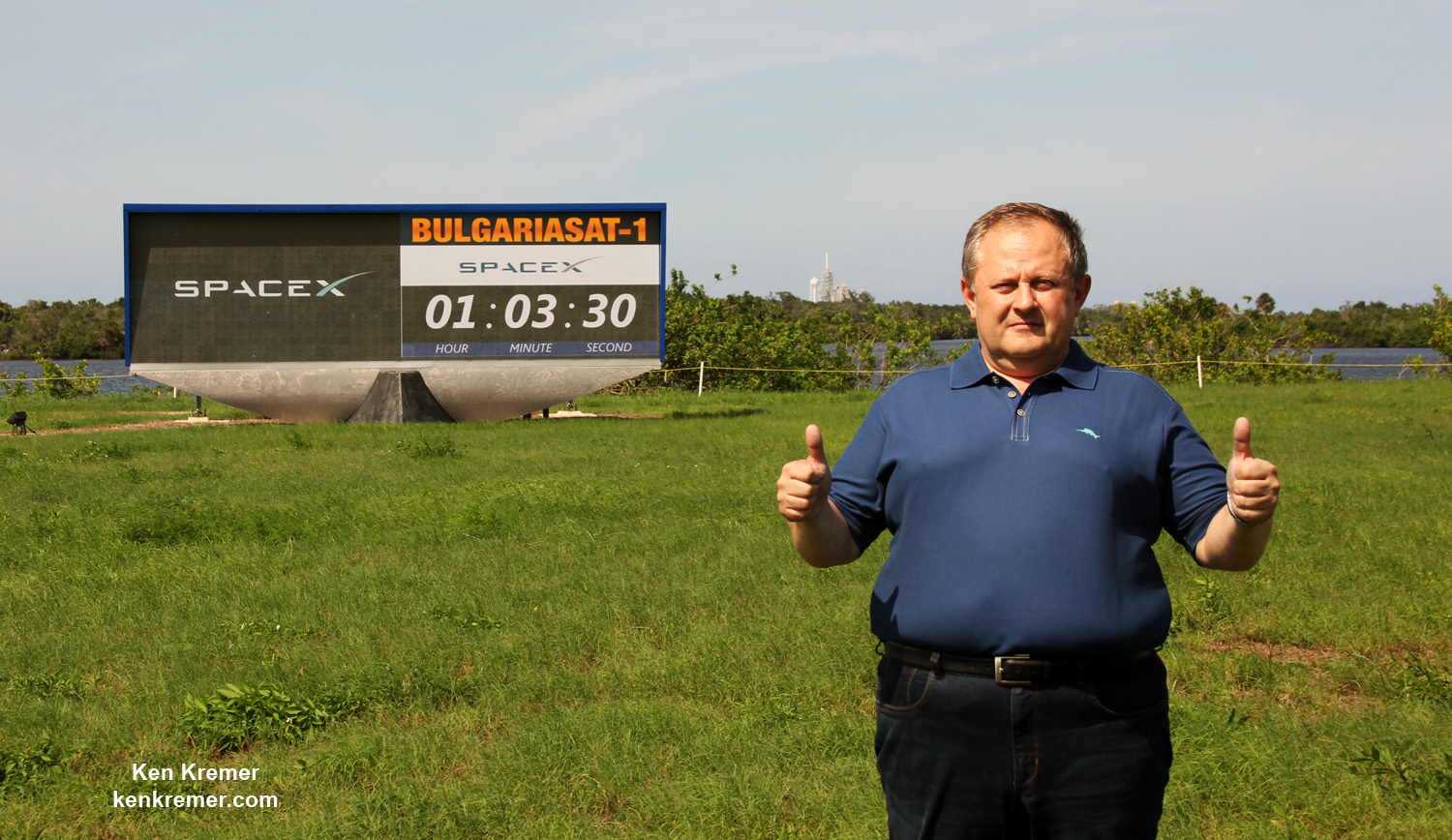
The BulgariaSat-1 launch had originally been slated for this past Monday, June 19 but was delayed four days to fix a valve in the payload fairing.
“Postponing launch to replace fairing pneumatic valve,” Musk tweeted last Sunday. “It is dual redundant, but not worth taking a chance.”
And everything went off without a hitch!
BulgariaSat-1 counts as the eighth SpaceX launch of 2017.
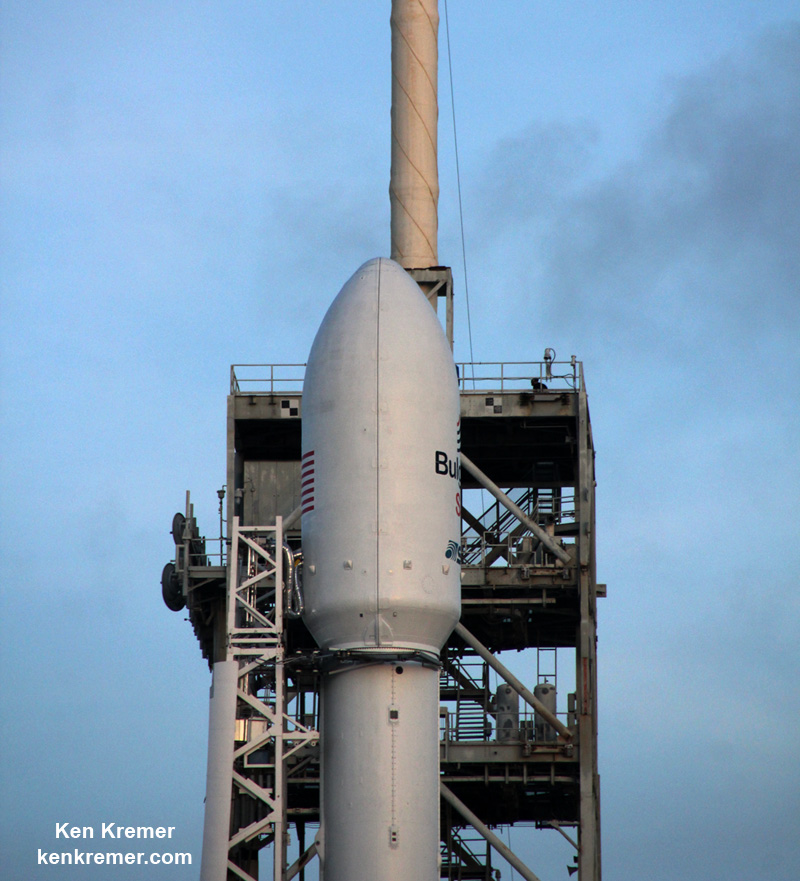
Watch for Ken’s onsite BulgariaSat-1 mission reports direct from the Kennedy Space Center and Cape Canaveral Air Force Station, Florida.
Stay tuned here for Ken’s continuing Earth and Planetary science and human spaceflight news.
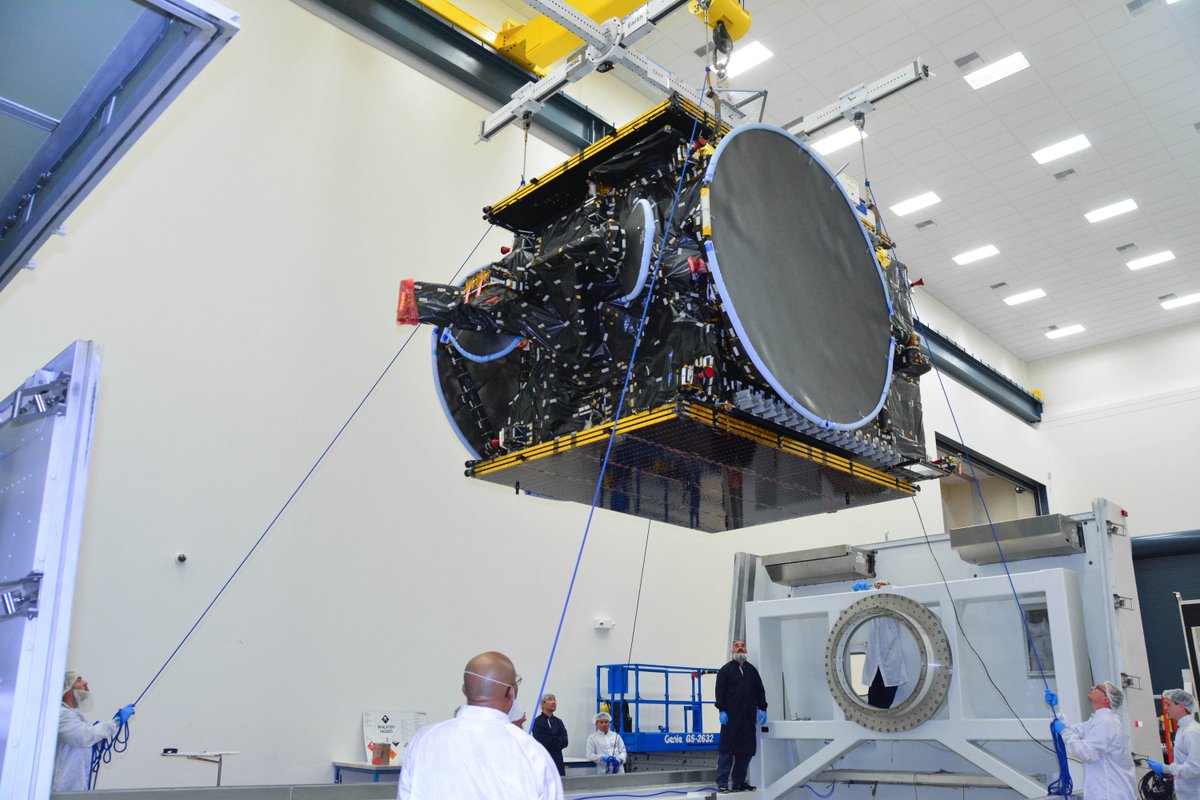
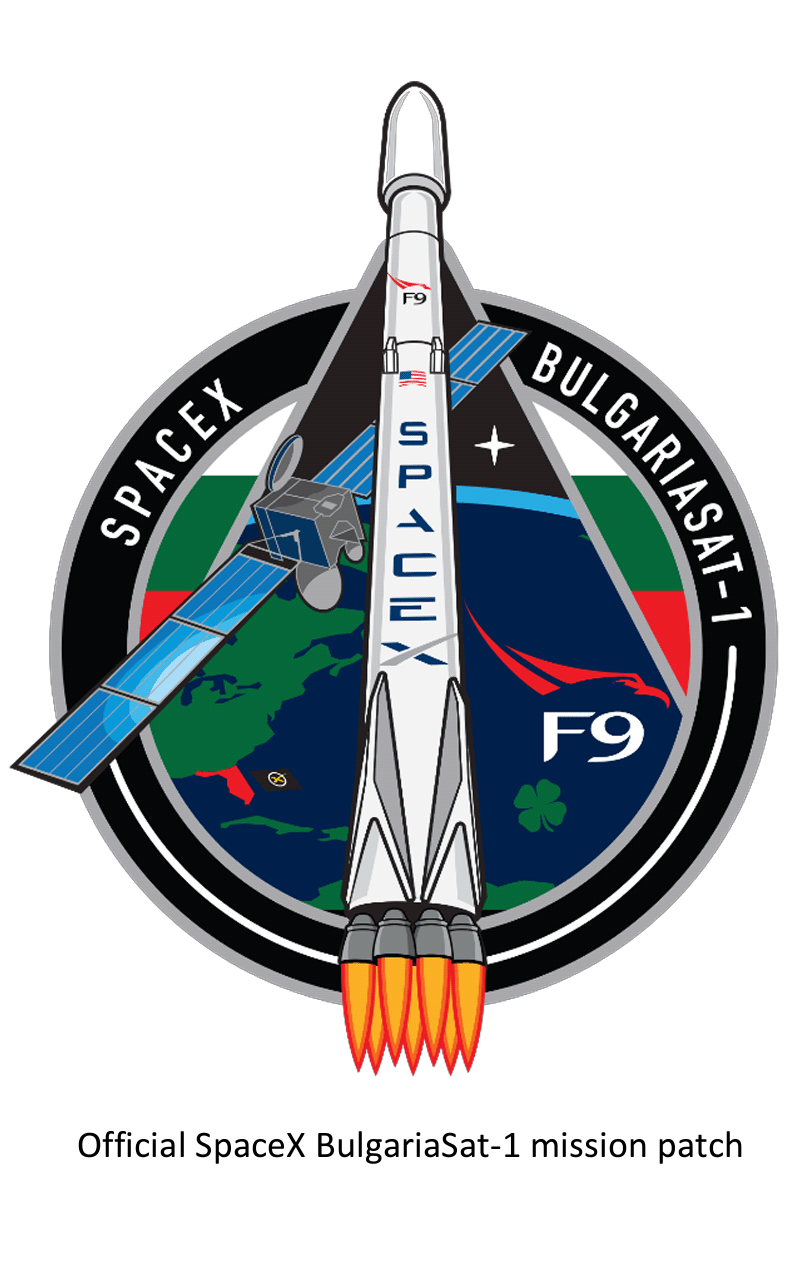
2nd SpaceX Recycled Falcon 9 Rocket Launching 1st Bulgarian GeoComSat June 23, Plus Potential Weekend Launch ‘Doubleheader’ – Watch Live
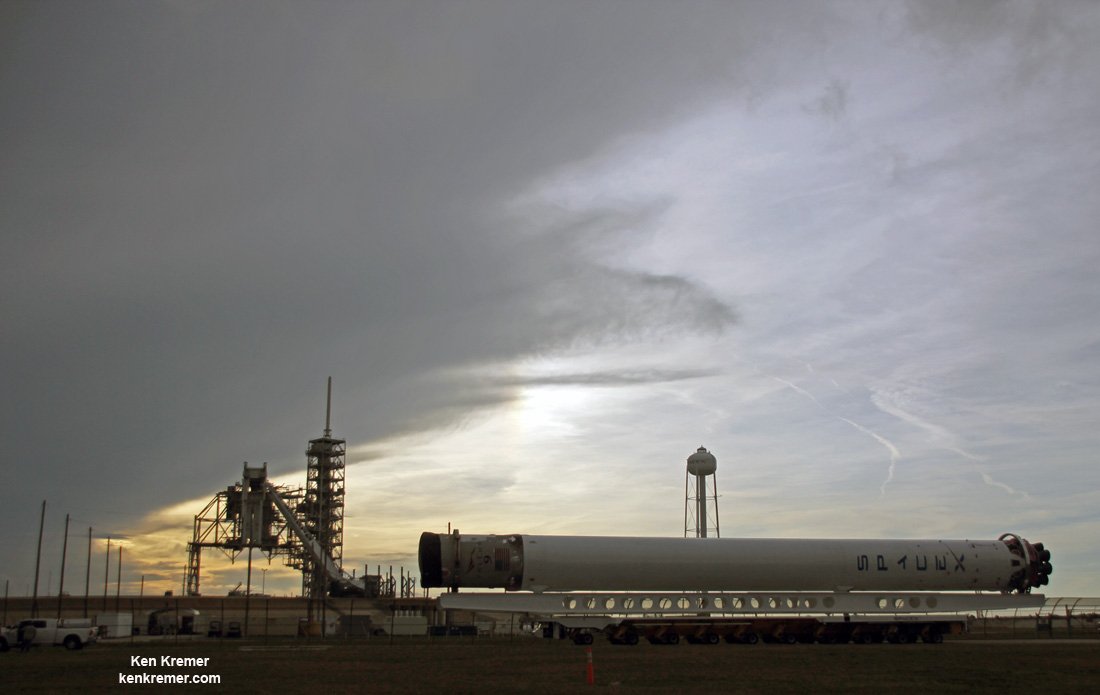

KENNEDY SPACE CENTER, FL – For only the second time in history, SpaceX will launch a ‘flight-proven’ Falcon 9 rocket this Friday afternoon and the payload this time for this remarkable and science fictionesque milestone is the first geostationary communications satellite for the nation of Bulgaria.
Blastoff of the BulgariaSat-1 communications satellite for commercial broadband provider BulgariaSat is slated for early Friday afternoon, June 23 at 2:10 p.m. EDT, or 18:10 UTC from SpaceX’s seaside Launch Complex 39A on NASA’s Kennedy Space Center in Florida.
BulgariaSat is an affiliate of Bulsatcom, Bulgaria’s largest digital television provider. The geostationary comsat will provide direct-to-home television (DTH) and data communications services to Southeastern Europe, including the Balkans and other European regions.
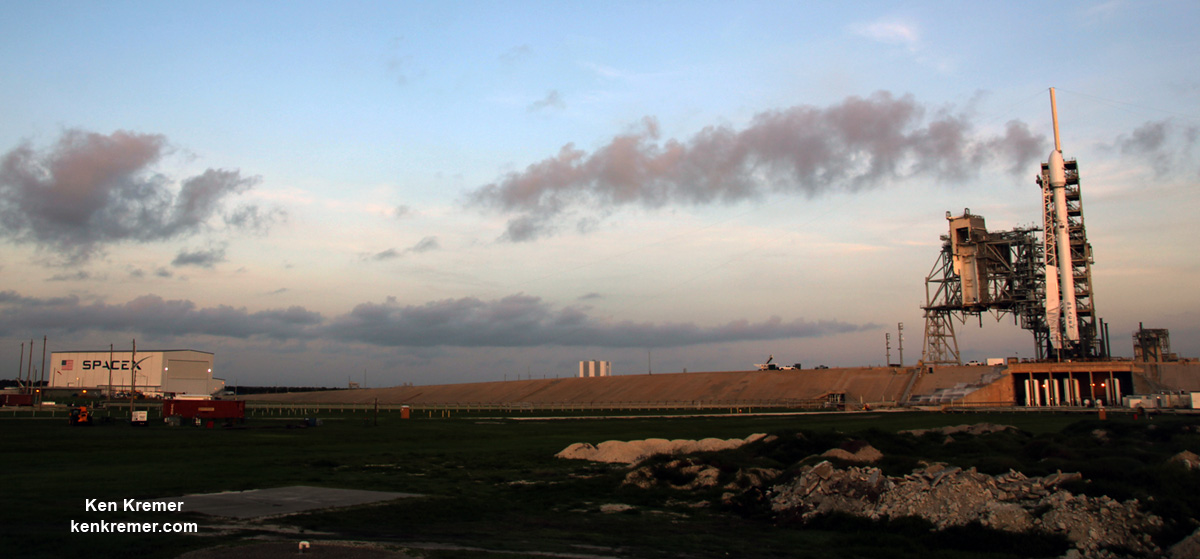
The used 229-foot-tall (70-meter) SpaceX Falcon 9 will deliver BulgariaSat-1 to a Geostationary Transfer Orbit (GTO).
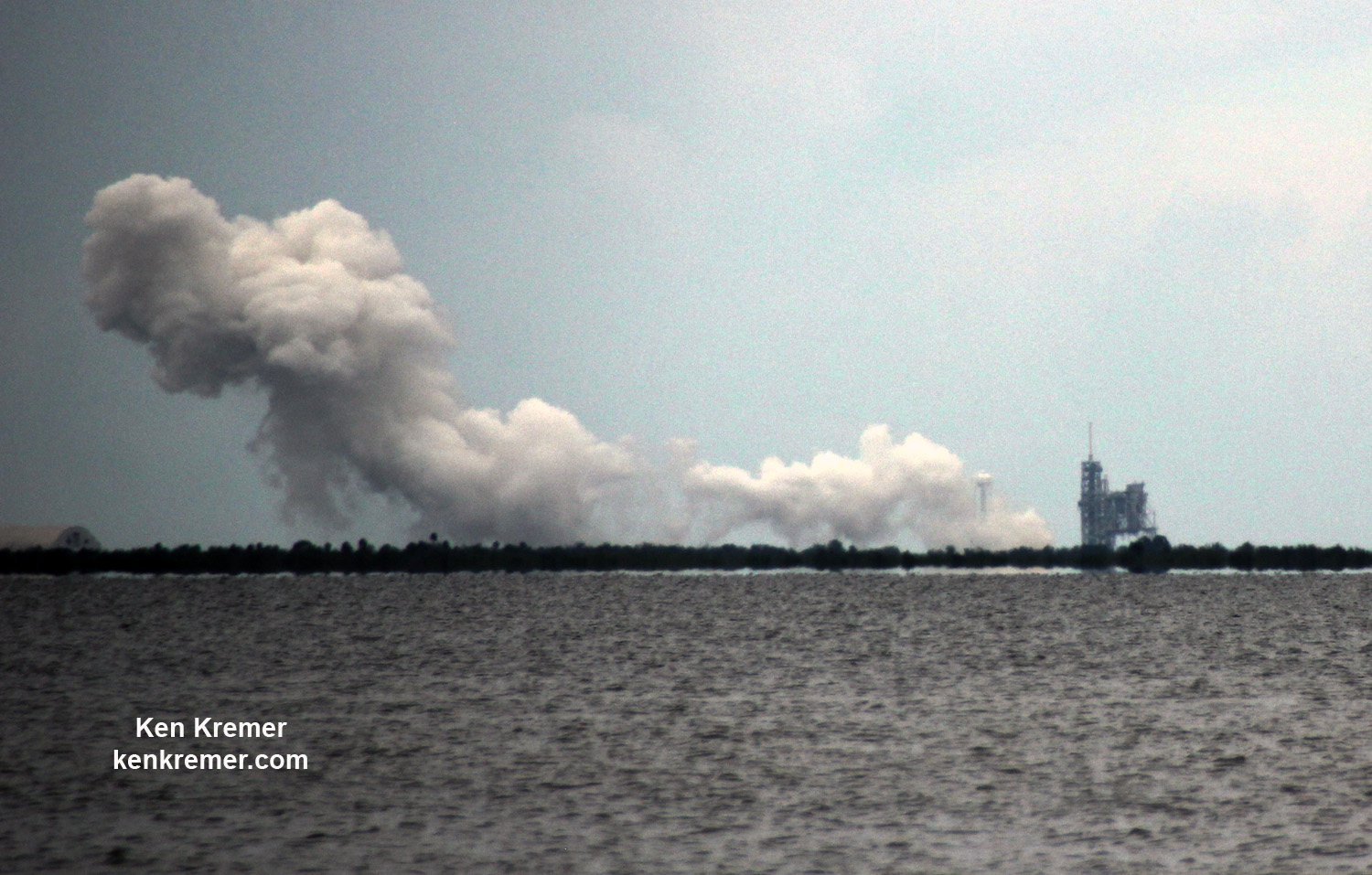
All systems are GO at this point!
And if all goes well there is a definite possibility of a weekend bicoastal launch double header by SpaceX – says SpaceX billionaire founder and CEO Elon. The next Falcon 9 mission is scheduled for blastoff on Sunday, June 25 from Vandenberg Air Force Base in California, barely 48 hours apart.
SpaceX is maintaining a blistering launch pace this year.
The Falcon 9 booster arrived just hours after launch of the Dragon CRS-11 resupply mission for NASA on June 3 – as I witnessed the recycled rockets arrival at pad 39A first hand later the same day (see photos).

SpaceX successfully launched history’s first ‘flight-proven’ Falcon 9 booster this past March for Luxembourg based telecommunications giant SES on the SES-10 mission – likewise from pad 39A.

The late lunchtime liftoff time for BulgariaSat-1 offers a very convenient opportunity for everyone to enjoy an eyewitness view, regardless of whether you live locally or if have the availability to take a quick trip to the Florida Space Coast.
And the current weather outlook is excellent say forecasters.
You can watch the launch live on a SpaceX dedicated webcast starting about 15 minutes prior to the opening of the launch window at 2:10 p.m. EDT, or 18:10 UTC
Watch the SpaceX broadcast live at: SpaceX.com/webcast
The recycled Falcon 9’s launch window extends for a full two hours until 4:10 p.m. EDT, June 23, or 20:10 UTC.
Fridays weather forecast is currently 90% GO for favorable conditions at launch time. That’s about as good as it gets for the notoriously fickle central Florida region.
The concern is for the Cumulus Cumulus Cloud Rule according to Air Force meteorologists with the 45th Space Wing at Patrick Air Force Base.
In case of a scrub for any reason on Friday, June 23, the backup launch opportunity is Saturday, June 24, at 2:10 p.m. EDT, or 18:10 UTC. Likewise it extends for two hours.
Saturdays’ weather forecast also quite good, dropping only slightly to 80% GO. The concern is for the Cumulus Cumulus Cloud Rule.
Falcon 9’s first stage for the BulgariaSat-1 mission previously supported the Iridium-1 mission from Vandenberg Air Force Base in January of this year. Following stage separation, Falcon 9’s first stage will attempt a landing on the “Of Course I Still Love You” droneship, which will be stationed in the Atlantic Ocean.
The satellite was built by SSL in Palo Alto, Calif. It has a design lifetime for a 15-year mission.
“We selected SSL to manufacture our first satellite early on, based on its history of success and reliability,” says Maxim Zayakov, chief executive officer of Bulgaria Sat. “SSL has been an excellent partner in helping us bring this project to fruition.”
BulgariaSat-1 will be equipped with 2 Ku-band FSS transponders and 30 Ku-band BSS transponders for fixed satellite services and advanced television services such as high definition television.

The historic pad 39A was previously used to launch NASA’s Apollo Saturn Moon rockets and Space Shuttles.
The path to launch was cleared following the successful completion of a critical static hot-fire test of the first stage last Thursday, June 15.
The hot fire test lasted about seven seconds as I witnessed from Banana River Lagoon and Rt. 1 in Titusville, which provides numerous excellent viewing locations.
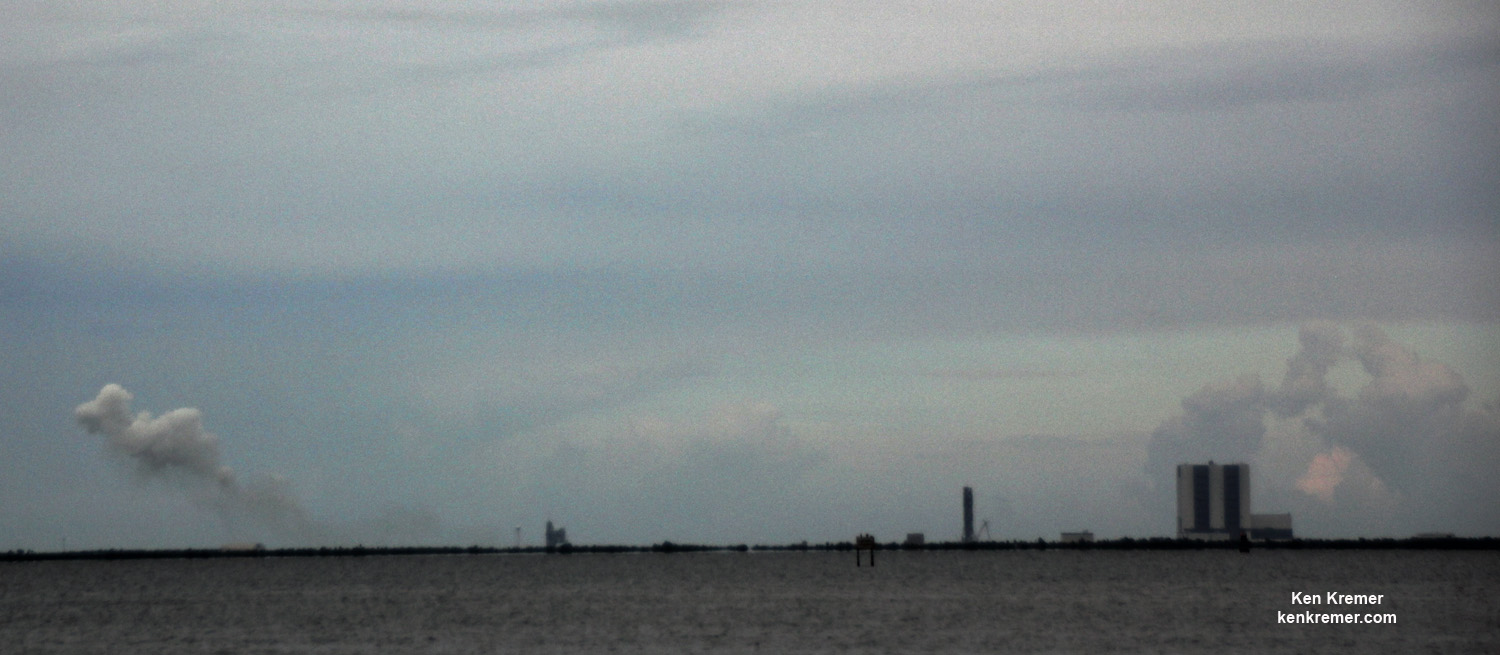
The BulgariaSat-1 launch had originally been slated for this past Monday, June 19 but was delayed four days to fix a valve in the payload fairing.

Watch for Ken’s onsite BulgariaSat-1 mission reports direct from the Kennedy Space Center and Cape Canaveral Air Force Station, Florida.
Stay tuned here for Ken’s continuing Earth and Planetary science and human spaceflight news.
………….
Learn more about the upcoming SpaceX launch of BulgariaSat 1, recent SpaceX Dragon CRS-11 resupply launch to ISS, NASA missions and more at Ken’s upcoming outreach events at Kennedy Space Center Quality Inn, Titusville, FL:
June 22-24: “SpaceX BulgariaSat 1 launch, SpaceX CRS-11 and CRS-10 resupply launches to the ISS, Inmarsat 5 and NRO Spysat, EchoStar 23, SLS, Orion, Commercial crew capsules from Boeing and SpaceX , Heroes and Legends at KSCVC, ULA Atlas/John Glenn Cygnus launch to ISS, SBIRS GEO 3 launch, GOES-R weather satellite launch, OSIRIS-Rex, Juno at Jupiter, InSight Mars lander, SpaceX and Orbital ATK cargo missions to the ISS, ULA Delta 4 Heavy spy satellite, Curiosity and Opportunity explore Mars, Pluto and more,” Kennedy Space Center Quality Inn, Titusville, FL, evenings


